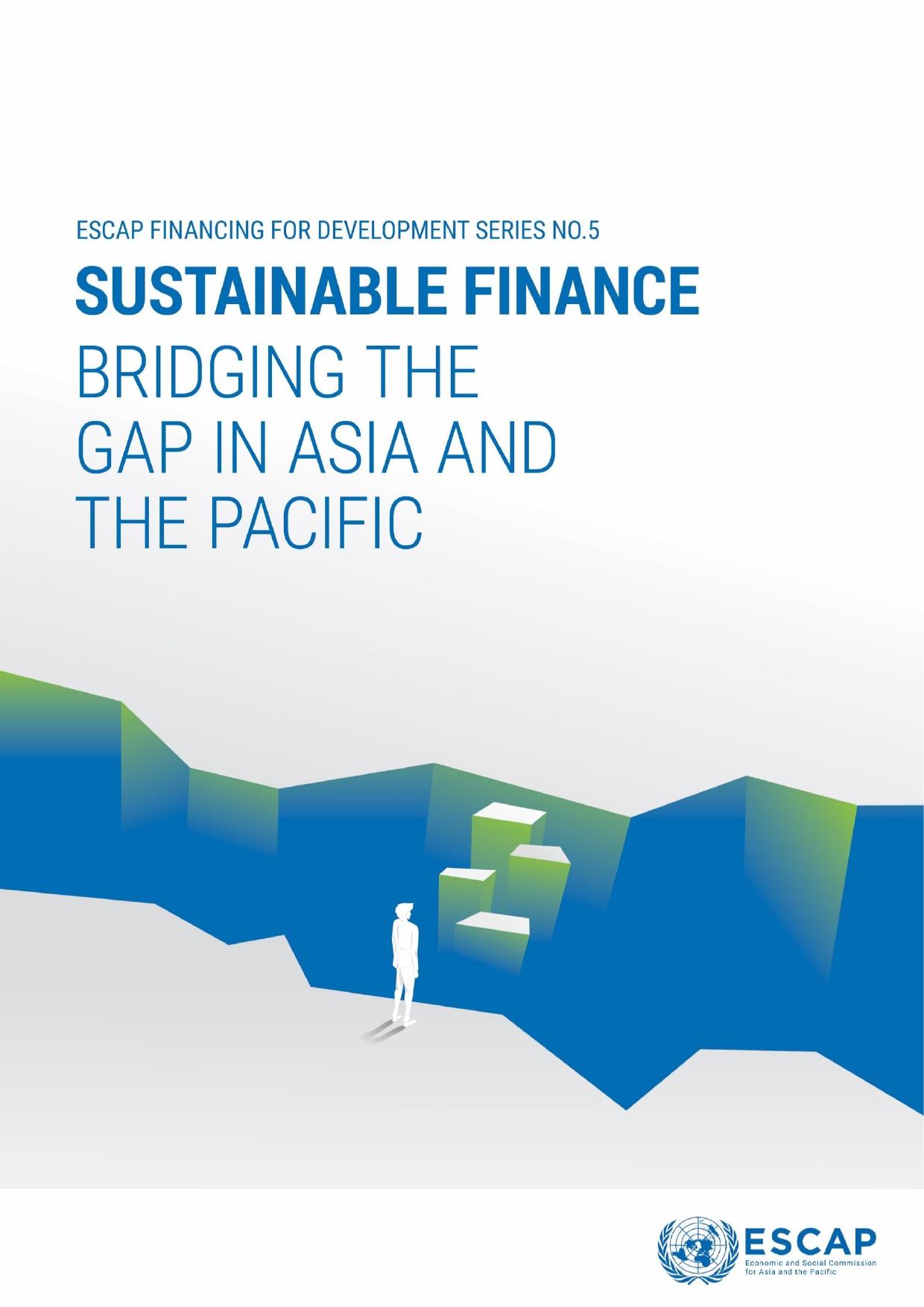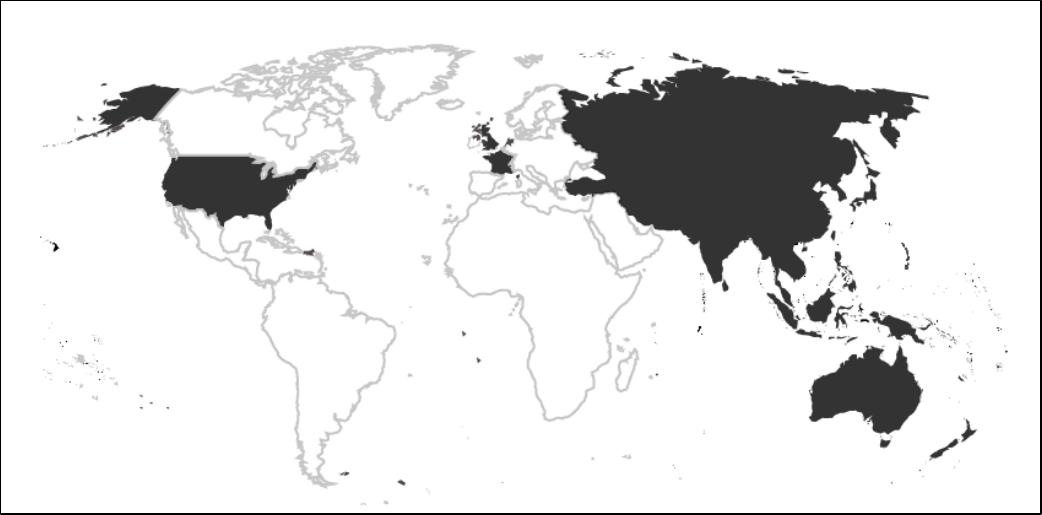TheshadedareasofthemapindicateESCAPmembersandassociatemembers.TheEconomicandSocialCommissionforAsiaandthePacific(ESCAP)isthemostinclusiveintergovernmentalplatformintheAsia-Pacificregion.TheCommissionpromotescooperationamongits53memberStatesand9associatemembersinpursuitofsolutionstosustainabledevelopmentchallenges.ESCAPisoneofthefiveregionalcommissionsoftheUnitedNations.TheESCAPsecretariatsupportsinclusive,resilient,andsustainabledevelopmentintheregionbygeneratingaction-orientedknowledge,andbyprovidingtechnicalassistanceandcapacity-buildingservicesinsupportofnationaldevelopmentobjectives,regionalagreements,andtheimplementationofthe2030AgendaforSustainableDevelopment.ThedesignationsemployedandthepresentationofmaterialonthismapdonotimplytheexpressionofanyopinionwhatsoeveronthepartoftheSecretariatoftheUnitedNationsconcerningthelegalstatusofanycountry,territory,cityorareaorofitsauthorities,orconcerningthedelimitationofitsfrontiersorboundaries.ESCAPFINANCINGFORDEVELOPMENTSERIESNO.5SUSTAINABLEFINANCE:BRIDGINGTHEGAPINASIAANDTHEPACIFICSustainableFinance:BridgingtheGapinAsiaandthePacificUnitedNationspublicationSalesNo.:23.II.F.6Copyright©UnitedNations2023Allrightsreserved.PRINTISBN:9789211014808PDFISBN:9789210027502PrintISSN:2522-798XOnlineISSN:2522-7998ST/ESCAP/3099Photocredits:Coverdesign:DilucidarPageiii:UNPhoto/JohnIsaacChapter1:www.iStockphoto.com/NikadaChapter2:www.iStockphoto.com/jaynothingChapter3:UNPhoto/EskinderDebebeChapter4:www.iStockphoto.com/IanDyballChapter5:www.iStockphoto.com/LeoPatriziTheviewsexpressedinthisdocumentarethoseoftheauthorsanddonotnecessarilyreflecttheviewsoftheUnitedNationsEconomicandSocialCommissionforAsiaandthePacific(ESCAP).ThedesignationsemployedandthepresentationofthematerialsinthispublicationalsodonotimplytheexpressionofanyopinionwhatsoeveronthepartofthesecretariatoftheUnitedNationsconcerningthelegalstatusofanycountry,territory,cityorarea,orofitsauthoritiesorconcerningthedelimitationofitsfrontiersorboundaries.ThispublicationfollowstheUnitedNationspracticeinreferencestocountries.Thispublicationshouldbecitedas:UnitedNations,EconomicandSocialCommissionforAsiaandthePacific(2023).SustainableFinance:BridgingtheGapinAsiaandthePacific.ESCAPFinancingforDevelopmentSeries,No.5.Bangkok.Thispublicationmaybereproducedinwholeorinpartforeducationalornon-profitpurposeswithoutspecialpermissionfromthecopyrightholder,providedthatthesourceisacknowledged.TheESCAPPublicationsOfficewouldappreciatereceivingacopyofanypublicationthatusesthispublicationasasource.Nousemaybemadeofthispublicationforresaleoranyothercommercialpurposewhatsoeverwithoutpriorpermission.Applicationsforsuchpermission,withastatementofthepurposeandextentofreproduction,shouldbeaddressedtotheSecretaryofthePublicationsBoard,UnitedNations,NewYork.iiESCAPFINANCINGFORDEVELOPMENTSERIESNO.5SUSTAINABLEFINANCE:BRIDGINGTHEGAPINASIAANDTHEPACIFIC3ESCAPFINANCINGFORDEVELOPMENTSERIESNO.5SUSTAINABLEFINANCE:BRIDGINGTHEGAPINASIAANDTHEPACIFICFOREWORDIn2022,theAsia-Pacificregionexperiencedunprecedentedweathercatastrophessuchasheatwavesanddroughts,typhoons,andfloodsthatresultedinsubstantialhumanandeconomiclossesanderodedhard-wondevelopmentgains.Evidenceismountingthattheseverityandfrequencyofsuchcatastrophesareincreasingduetoclimatechange,whichisservingasa“threatmultiplier”forexistingsocial,political,andeconomicchallenges.ThesechallengeshavebeenfurtherexacerbatedbytheongoingwarinUkrainewhichcauseda“polycrisis”relatedtofood,energy,andfinance,withcascadingmultifacetedeffectsontheglobaleconomyalreadyseverelyimpactedbytheCOVID-19pandemic.Toeffectivelyrespondtothesecrises–Covid,conflictandclimatechange–andtorebuildoureconomiesinamannerconsistentwiththeambitionsofthe2030AgendaforSustainableDevelopmentandParisAgreementonclimatechange,substantialfinancialresourcesareneeded.Butitisalsoclearthat,alarmingly,thegapbetweentheresourcesrequiredandthosecurrentlyavailableissubstantialandgrowing.Toclosethisgap,especiallytoaddressclimatechange,theparticipationandcommitmentofallrelevantstakeholders–governments,regulators,andprivatefinance–isurgentlyneeded.TheAsia-PacificregionisnotontracktomeettheSDGsby2030norachieveclimateambitions,withcurrentfinancialrequirementsfarexceedingavailableresources.Thus,inactiontoraisesufficientadditionalfinancing,ortochannelavailableresourcesinsupportofSDGsandclimateaction,isnotanoptionanymore.Itistimeforallstakeholderstocommittoacceleratedchangebycommittingtonetzeroemissionsandtransformingtheirfinancingpriorities,processes,andprogramstomeetthegrowingfinancingneedsoftheregion.Thisreportfocusesonsustainablefinance,which,inabroadersense,referstothefinancingofsustainableactivitiesaswellasfinancethatissustainablymanaged.Inthisvein,thereportexaminesthetrends,challenges,andopportunitiesthatpolicymakers,regulators,andprivatefinance(banks,issuers,andinvestors)inAsiaandthePacificfacetomobilizeanddeploysustainablefinance,particularlyforclimateaction.Itthenpresentsspecificrecommendationsforgovernments,regulators,andprivatefinance–summarizedintenprinciplesforaction–tochartthewayforward.WeaimtospurmorerobustandinformeddebateamongstourmemberStates,driveconsensusonkeypolicyandregulatorymeasurestomovetheregiontowardssustainabilityandbringgreaterclarityregardingthebenefitsandconsequencesofenhancingsustainablefinanceinboththeshortandlongterm.Iamconfidentthatpolicymakers,regulators,privatesectorrepresentativesaswellasresearchersintheAsia-Pacificregionwillbenefittremendouslyfromourreport.MyteamandIlookforwardtoengagingwithmemberStates,partners,andotherkeystakeholderstotranslatetheideaspresentedinthisreportintopracticalmeasuressothatthepressingfinancinggapcanbeclosed.HamzaAliMalikDirectorMacroeconomicPolicyandFinancingforDevelopment,ESCAPivESCAPFINANCINGFORDEVELOPMENTSERIESNO.5SUSTAINABLEFINANCE:BRIDGINGTHEGAPINASIAANDTHEPACIFICEXECUTIVESUMMARYenvironment.Sustainablefinance(andtransitionfinance)frameworks,roadmaps,disclosureframeworksTheAsia-PacificregionisnotontracktomeettheSDGsandtaxonomiesincreasetheintegrityandclarityofby2030norachieveclimateambitions,withcurrentfinancingsustainableactivities,throughtheuseoffinancialrequirementsfarexceedingavailableappropriatestandards.Achievingincreasedregionalresources.TheSharm-el-SheikhImplementationPlan,alignment,convergenceandinteroperabilityintheseagreedatthe27thConferenceofthePartiesofthestandardswillbehighlydesirable,whichcanreduceUnitedNationsFrameworkConventiononClimatecross-bordercompliancecostsandcreateanefficientChange(UNFCCC)in2022highlightedthattheworldwillandlevelplayingfield.needbetween$4trillionand$6trillionperyeartotransitiontoalow-carboneconomy.FordevelopingThisreportdiscusseschallenges,opportunities,andcountriesthefinancinggaptomeettheirNationallyrecommendationsforpolicymakers,regulators,andDeterminedContributions(NDC)isestimatedatclosetoprivatefinanceintheAsia-Pacificregiontobridgethe$6trillionfortheperiod2023-2030.gapinsustainablefinance.Itoutlinestwotracksofsustainablefinance;Track1referstouse-of-proceedsorUrgentandsystemicchangeisrequiredtodeliverobjective/outcomedrivenfinance;andTrack2referstofundingatsuchascale.Itrequiresrecognitionandsustainablymanagedfinancethatmanageswillingnessbyallcountriestotransformpolicies,environment,social,governance,andincreasinglyregulations,andthefinancialsystem.InAsiaandtheclimate,risksinitsdeployment.TheaimofthisreportisPacificthischangehasproceededattooslowapace.tospurarobustandinformeddebateamongstmemberPolicymakersstillneedtoimplementcredibleNDCStates,establishconsensusonkeymeasurestomovefinancingplans,withcorrespondingresourcetowardsincreasedsustainablefinance,andbringmobilizationstrategiestoachievesequencedNDCgreaterclarityregardingthebenefitsandconsequencestargetsthatareprogressivelyambitious(andtoadoptofvariouspolicy,regulatoryandprivatefinancechoices.moreambitiousNDCtargetsinthefuture).RegulatorsmustactdecisivelytomanagetherisksthatclimateWhatcangovernmentsdo?changeandbiodiversitythreatsposetothefinancialsystem,whileatthesametimedecisivelyshiftingPolicymakershaveanimportantroletoplayinbuildingcapitaltowardsgreenobjectivesconsistentwiththeirsustainablefinancemarketsanddrivingdownriskandNDCs.perceptionsofrisk.WhencommitmentsandprioritiesinclimateactionandsustainablefinanceareIntheprivatesector,banksandbusinessesneedtocommunicatedclearlytomarkets,long-termadoptnetzerocommitmentsandimplementcredibleinvestmentscanbeaccuratelypricedandundertakentransitionpathways.Astheydoso,andthesupplyofwithinvestorconfidence.Policymakersarealsonet-zeroalignedfinancingincreases,thedemandsideresponsibleforbudgetallocationsintermsofincentivesforthiscapitalalsoneedstoincrease.Forthis,projects,ortariffsthataffectthereturnsinfossilfueldependentparticularlyintheenergytransitionandnewgreensectors,andinthusshiftingthefinancingoftheenergytechnologies,areneededatsufficientscaleandqualitymixofsectors.Theiractionshavevastimplicationsontomeetarangeofinvestorneeds.Theseprojectsneedvarioussectorsoftheeconomythatneedtofinancethetobebuiltthroughnewfinancingpartnershipshifttonewandcleanerenergysources,reducetheapproaches.Inthisvein,multilateraldevelopmentbankscarbonintensityoftheiroutput,tracktheiremissions,anddevelopmentfinancialinstitutionswillplayakeyandplantheirtransitiontonet-zeroemissions.roleinprovidingcatalyticcapitalwiththerighttermsrelatedtoconcessionalityandrisk-sharing.AstheydoGovernmentsalsohavearoleinshiftingcapitaltowardsso,localbanksandinvestorsinAsia-Pacificmustgreenobjectives.Therehasbeenapromisingincreasedecideincreasinglytofinancethenet-zerotransition,bygovernmentsintheregioninissuingsovereigngreen,particularlyinprovidinglocalcurrencyfinancing,whichsocial,sustainableandotherbonds,labelledGSS+,thatisessentialintoday’sdifficultmacroeconomicraisecapitalforspecificallyGSS+uses.TheglobalmarketforGSS+bondshasgrowntomorethan$3.8trillionoutstandingbytheendof20221,andannualvESCAPFINANCINGFORDEVELOPMENTSERIESNO.5SUSTAINABLEFINANCE:BRIDGINGTHEGAPINASIAANDTHEPACIFICissuancesinAsiaandthePacificincreasedfrom$5IndonesiaandVietNamin2022.TheseJETPsbillionin2015to$206billionin2022.Althoughcoordinatenationalcommitmentstopeakingemissions,corporateissuancesdominatethismarket,sovereignsphasingoutcoal,improvingregulationsanddesigningandjurisdictionsareincreasinglytappingintoit,witheffectivepipelinesofbankableprojects—allinitiativesHongKong,China;Indonesia;Malaysia;NewZealand;whichprovideastrongbasistomobilizeevenmorePhilippines;Singapore;andThailandissuingbetween$1privateandpublicfinance.Whilenoteverycountryinthebillionand$2.5billioneachin2022.regioncanandshouldreplicatetheJETPmodel,theengagementbetweenpolicymakersandfinancialGovernmentsintheregionalsohavearoleinaccessingproviders(whetherpublicorprivate)fromtheplanningmultilateralclimatefunds(MCFs),suchastheandinceptionstagesofenergytransitionsaremutuallyAdaptationFund,theGlobalEnvironmentFund,orthebeneficialandservetofocusefforts,concentrateminds,GreenClimateFund.Whilethemoneyavailablefromandbridgethefinancinggap.MCFswillnotbesufficienttoclosethefinancinggap,MCFsremainacriticalsourceandchannelforWhatcanregulatorsdo?developedcountriestomeettheirParisAgreementobligationstodevelopingcountries.In2021,forRegulatorscanincreasinglyensurecoherenceandinstance,accordingtotheOECD2,fundsfromMCFscoordinationacrossotherregulatorsaswellasprovidedmorethan$1.2billiontoAsia-Pacificpolicymakers.Regulatorshaveanimportantroleincountries.Thissourceofsustainablefinanceispreservingstabilityofthefinancialsystem,managingattractivebecausealargeportionisavailableasgrantsrisks,andincreasingly,shiftingcapitaltowardsclimate-—about50percentin2021,comparedto29percentofrelatedinvestments.Toeffectivelytacklethescaleoffinancingfrombilateraldonorsand3percentofthesustainablefinancechallenge,financialregulatorsfinancingfrommultilateraldevelopmentbanks.needtoworkincreasinglycloselywithotherregulators,suchasenvironmentalprotectionagencies,Movingforward,themostimmediatestepfordepartmentsofindustriesthatregulatethefiduciarypolicymakerstotakeistoensurethatNationallydutiesofdirectorsandtrusteesoffundandinvestmentDeterminedContributionsaresupportedbyconcrete,managers,competitionandconsumerregulatorstargeted,andsequencednationalfinancingstrategies.guardingagainstpotentialgreenwashingofproductsClimatemitigationandadaptationactivitiesneedtobeandservices,energyregulatorsandregulatorsrelatedtomappedoutwithexpectedsourcesofdomesticpublictheintroductionofnewgreentechnologies.Suchanfinance,internationalfinancialassistance,andprivateintegrationofclimate-relatedandincreasinglynature-finance.Governmentsmustacceleratethedifficultworkrelatedrisksintoregulationalsocallsforsubstantialoftranslatingnationalnetzerocommitmentsintonet-investmentintobuildingtherightskillsandcapacitieszerocommitmentsbyfinancialinstitutionsandacrossthefinancialsystem.businesses.Indoingso,policymakersshouldensureclarity,reliability,predictabilityandstability,therebyEffectiveregulationrequiresclear,consistent,andsettingtrustedsignalstomarketsandinvestorswhocomparabledata.Amajorchallengetoimplementingmustmakethelong-terminvestmentsthatunderpintheregulatoryapproachesthatwouldaccountforclimate-netzerotransition.Sustainablefinanceframeworksrelatedandnature-relatedfinancialrisksisthelackof(suchasroadmapsandtaxonomies)canthenfurtheravailablequalitydata.Datachallengesreportedbyembedandclarifyfinancingparameterstosupportthesupervisoryauthoritiesincludethelackofgranular,NDCfinancingstrategies.consistent,andcomparabledatareportingstandardsforcounterpartiesandforfinancialinstitutions.ThedataFinally,newclimatefinancepartnershipsareneededatrequiredincludes:theidentificationofsectorsorscaletotacklethechallenge.Policymakerscanalsoeconomicactivitiesthatarevulnerabletophysical,drivesustainablefinanceatscalethroughengagingintransitionandliabilityrisks;financialinstitutions’multi-dimensionalpartnershipswithdonorcountriesandexposurestosuchsectorsoreconomicactivities;theprivatefinancialinstitutionssuchastherecentJustgeographicallocationoffinancialinstitutions’EnergyTransitionPartnerships(JETPs)launchedbyexposuresmostpronetophysicalrisk;andreportsonviESCAPFINANCINGFORDEVELOPMENTSERIESNO.5SUSTAINABLEFINANCE:BRIDGINGTHEGAPINASIAANDTHEPACIFICcarbon-relatedmetrics,includingScope1,2,and3thebanklendingmarket,andtrillionsarealsoheldingreenhousegasemissions,byfinancialinstitutionsandcapitalmarkets.Thisprivatefinancewillnowhavetotheircounterparties.TheInternationalSustainabilitystepuptothechallenge.RegulatorshaveanimportantStandardsBoard’s(ISSB)inauguralstandardsforrole,asdiscussed,inincentivisingthisprivatefinancetosustainability-relateddisclosures,issuedinJune2023,shifttowardsgreenobjectives,andincreatinganisexpectedtoestablishacommonglobalbaselineforefficientandlevelplayingfield.Theuniverseofprivatecorporatesustainabilitydisclosures.However,financeinAsiaandthePacificincludesbankswholendregulatorsincountrieswhereinstitutionsarenotyettobusinessesintherealeconomy;capitalmarketrequiredtoadoptISSBstandardswillstillfacedataissuersofequityanddebtsecurities;assetownerschallengesaroundthestandards,costs,andverification(pensionfunds,sovereignwealthfunds,foundations,aspectsoftherequireddata.endowments,trusts,familyoffices);andassetmanagers(mutualfundmanagers,investmentadvisors,Inadditiontoplayingasupervisoryroletomanagestockbrokers).Developmentfinancialinstitutionssuchfinancesustainably(whatthisreportreferstoasTrack2asmultilateraldevelopmentbanks(MDBs),bilateralofthetwotypesofsustainablefinance),regulatorscandevelopmentfinancialinstitutions,andnationalalsodecisivelyshiftcapitalintolow-carboninvestmentsdevelopmentbanksplayanincreasinglycriticaland(Track1ofthetwotypesofsustainablefinance).Theircatalyticroleinshiftingrisk,promotingstandards,workinsustainablefinanceroadmaps,sustainablemobilisingprivatefinanceandbuildingcapacity.financetaxonomies,andGSS+bondandloanframeworkscreateclarity,boostintegrity,andsignaltoHistorically,privatefinancehasoperatedunderinvestorsthecredibilityofintentionstoundertakeatraditionalnormsoffiduciaryduty,whichisnowsustainablefinancetrajectory.Emergingtransitionchanging.Thearchitecturegoverningboththedutiesoffinancetaxonomieshavethepotentialtoalsocrediblydirectorsofcompaniesaswellascompanies’climate-directthemarkettowardssupportingthetransitionfromrelatedandsustainabilitydisclosures,whicharemostlybrowntogreenactivitiesandincentivizethereductionofvoluntaryinAsiaandthePacificnow,isbeingemissions.Regulatorscanthussteadilyencouragetransformed.Financialinstitutionsandcompanieswillfinancialinstitutionsandcorporationstocrediblyincreasinglyberequiredtocomplywithastrengtheningtransitionthroughtheimplementationofvoluntaryandmeshofsustainabilityrequirementsiftheywishtomandatorysustainablefinancerequirements.continueoperatinginregulatedmarkets.Astheydoso,andtheyincreasinglycommittonet-zeroalignedTheadoptionofsustainablefinanceroadmapsisaoperations,theseAsia-Pacificprivatefinanceactorswillpromisingfirststep,buttheirmostlyvoluntarynaturehavetoincreasethescaleoftheirinvestingoperationsmaynotaccelerateurgentandwidespreadchange.Netinnet-zeroalignedactivities.Thiswillinfusemuchzerocommitments,oranyobligationtothenetzeroneededlocalcurrencyintothenetzerotransitioninthetransition,arecurrentlynotmandatoryacrossmostofregion,ifsuitableprojectsandactivitiesarepresentatAsiaandthePacific.Coalfinancingandfossilfuelscale.financingisstillontherise,poweredbytheincreaseinenergydemandacrossAsiaandthePacific.Onthesupplyside,muchmoreneedstobedonePolicymakersandregulatorsintheregionmustdifferentlyintermsofbuildinggreenprojectsthatarethereforetakeurgentanddecisiveactionasthereportreadytomeettheneedsofarangeofinvestors.outlines.Commontransactiontemplatesinnewsectorsandcountriescanbedevelopedandsharedbyinvestors,Whatcanprivatefinancedo?creatingacommontransactionlexiconinunchartedterritories.Investorsalsoneedtoparticipateinpre-TheSixthAssessmentReportoftheIntergovernmentalinvestmentproject-building,atearlierstages,despitethePanelonClimateChange(IPCC)2023highlightsthatresourcecostssucheffortsmayentail,inordertobringthereissufficientglobalcapitalandliquiditytoclosefirst-moverprojectsinchallengingsectorsandlocationstheglobalinvestmentgap.InAsiaandthePacific,tofruition,andthentoreplicatesuchprojects.PrivatetrillionsofdollarsofcapitalareheldpredominantlyinviiESCAPFINANCINGFORDEVELOPMENTSERIESNO.5SUSTAINABLEFINANCE:BRIDGINGTHEGAPINASIAANDTHEPACIFICfinancialinstitutionsinAsiaandthePacificneedtoandthecapacitiesforsuchcoordination.ThiswillengageinlearninghowtoinvestinwhatmayseemtobealsoallowgovernmentstobetterworkwithMDBs,riskierprojects,andhowtobuildandassesscapitalDFIs,anddevelopmentpartnerstoobtainthestructuresthatinvolveblendedfinanceandamultiplicityassistancetheyneedinthetimeframetheyneeditofstandards.Forsuchgreenprojectpipelinestoin.genuinelymeettheneedsandstandardsofmultipleinvestorsatscale,newpartnershipapproachesare4.Decisiveregulatoryactiontakesplacetoshiftneededthatmoveawayfromadeal-by-dealbasistoacapitalinAsiaandthePacifictowardsthenetzeroplatformbasis.Thisisadifferentwayofdoingtransition.AsiaandthePacificishometobusiness,andpartofthetransformationthatisneededsignificantlylargepoolsofcapitalcapableofacrossthesystem.bridgingthegapinsustainablefinance.RegulatorsneedtoadoptamoreactiveroleinshiftingcapitalTenprinciplesofactiontobridgeAsia-Pacific'stowardsclimateaction,recognizingthatdoingsosustainablefinancegapwillstrengthenfinancialstabilityinthesystem,aswellascreatealevelplayingfieldforall.IndoingThisreportputsforwardaten-pointactionplantoso,regulatorswillalsoneedtomovetowardsacceleratesustainablefinanceinAsiaandthePacific.consistenttaxonomiesandroadmapsacrossThesetenactionssummarizein-depthcountries,tocreatealevelplayingfield.recommendationsfoundineachchapterforgovernments,regulatorsandprivatefinance.Theseten5.Investmentinthecapacitiesoffinancialpersonnelactionsbelowaregroupedintoactionstobetakenbytoassessclimaterisk,innovategreenfinancialgovernments,regulators,andprivatefinance.instruments,andsupervisethetransitionpathofthegreeneconomyisundertaken.InternationalGovernmentsandregulatorsgroupingssuchastheNetworkforCentralBanksandSupervisorsforGreeningtheFinancialSystem1.Newclimatefinancepartnershipsaredeveloped(NGFS)ortheSustainableBankingandFinancethroughwhichgovernments,regulators,MDBs,andNetwork(SBFN)canbeeffectivetopromotepeer-privatefinancecommittoactionaroundspecificlearningamongmembers.goalsandcontributespecifictasksinlinewiththissharedgoal.JustEnergyTransitionPartnerships,6.Investmentinmuch-neededsectoralandproject-whichareledandownedbycountries,provideabasedfinancialdataisundertaken.Commondatausefulmodelfortheregion,especiallyifexecutionplatformsthatsharevaluabledataonESG,climate,canbeaccelerated.nature,contracts,clausesstandards,targets,anddeals(wherepossible)willstreamlineinvestment,2.EffectiveNDCfinancingstrategiesaredeveloped,assistbenchmarking,strengthencredibilityandledbyauthoritieswithclearmandates,whichsignalensurehigherreplicability.credibletransitionpathwayswithinterimtargetsandclearresourcemobilizationplans.ThiswillPrivatefinance-Asia-Pacificbanks,investorsandprovideaclearandvitalsignaltoinvestors,issuers.businesses,andprojectdevelopersthatgovernmentsarecommittedtochange.Thissignal7.Commitmentstonetzeropledgesfor2050withofreliability,stability,andpredictabilityisacorecredibletransitionpathwaysincluding2030goalspartofcostsaroundprojects.aremade.TheslownessofbanksinAsiaandthePacifictocommittonetzeroandtransitiontheir3.Policycoherenceandcapacitiesaredevelopedlendingandinvestingportfolioswithinterim2030acrosskeygovernmentministriessuchasfinance,science-basedtargetsisaseriousbrakeondrivingenergy,transport,andenvironment,ultimatelyfinancetowardsclimateactionintheregion.reducingthecostsoffinancing.GovernmentsneedtoinvestinboththeeffortforsuchcoordinationviiiESCAPFINANCINGFORDEVELOPMENTSERIESNO.5SUSTAINABLEFINANCE:BRIDGINGTHEGAPINASIAANDTHEPACIFIC8.Local-currencyfinancingofenergytransitionprojects.Thiswillalsoguaranteewell-designedprojectsaswellasgreentechnologiesandotherprojectsinwhichconcessionalfinancetrulynet-zeroinvestmentsisincreased.Local-currencycatalyzesandmobilizesgreaterprivatefinance.Infinancingiscriticaltoacceleratethescaleandpacedoingso,however,itiscriticaltoensuretheprojectofprivatefinancebecauseitcanfundprojectsthatisbothhighimpacttosupportthenet-zero-donothavetoreachahigherrateofreturnjusttotransitionandcommerciallyattractive.coverexchangerateriskaswellasprovideotherbenefits.Increasednet-zerocommitmentsby10.InvestmentoftimeandeffortwithpartnersinprivatefinanceinAsiaandthePacific(number7projectpreparationisincreasedinmorechallengingabove)combinedwithafocusoninvestinginthemarkets,whetheritisintheLDCs,SIDS,orinnewenergytransitionintheirlocalcurrencywillleveragegreentechnologies.Settingupamodalityinwhichandbringforwardtheneededinvestmentatscale.projectdevelopersandfinancialinstitutionsregularlymeetandco-creategreenprojectsina9.Concessionalfinancingandrisk-sharingbyprogressiveanditerativemannercanacceleratethemultilateraldevelopmentbanks,bilateralpreparationofeffectivepipelinesofbankablegreendevelopmentfinancialinstitutions,andpublicprojectsatscale.Whilelargeprojectshavelowerdevelopmentbanksisexpandedandaccelerated.transactioncosts,investinginprojectpreparationThiswillde-riskotherwisesoundprojectsandforsmaller-ticketprojectswillensurealong-termultimatelyleveragesignificantprivatecapital.A1:5pipelineoflargeprojects.Ultimatelygoodprojectratio,likeADB’sgoal,canbeonebenchmarktopreparationbringsdowntheriskofprojectswhenensurethatconcessionalfundstrulyleverageimplemented.privatefinanceandgotowardswell-structuredixESCAPFINANCINGFORDEVELOPMENTSERIESNO.5SUSTAINABLEFINANCE:BRIDGINGTHEGAPINASIAANDTHEPACIFICACKNOWLEDGMENTSSinceitsinceptionin2015,theESCAPbiennialseriesonfinancingfordevelopmenthaspublishedresearchonarangeofcriticalissuesonfinancingfordevelopmentfromtheregionalperspectiveofAsiaandthePacific.ThisresearchcontributestoregionalandnationaldialoguesonstrategiesfortheimplementationofselectedaspectsoffinancingfordevelopmentasadvancedbytheAddisAbabaActionAgenda.The5theditionoftheserieswaspreparedbyacoreteamatESCAPledbySubaSivakumaran(Chief,FinancingforDevelopmentSection)andcomprisingofChiaraAmato,PierreHorna,AlbertoIsgutandLatipatMikledfromtheFinancingforDevelopmentSectionoftheMacroeconomicPolicyandFinancingforDevelopmentDivisionaswellasexternalconsultantMichaelCoates.HamzaAliMalik,DirectoroftheMacroeconomicPolicyandFinancingforDevelopmentDivision,hasprovidedoverallleadershipandsharedvaluablecommentsandsuggestionsatvariousstagesofpreparationofthispublication.AtechnicalreviewwasconductedbyPatrickMartinandDeannaMorris,alsofromtheFinancingforDevelopmentSectionoftheMacroeconomicPolicyandFinancingforDevelopmentDivision.MichaelWilliamsonandMichaelDavidWaldronfromtheEnergyDivisionofESCAPprovidedtechnicalinputsonfinancingtheenergytransition.HeatherLynneTaylor-StraussfromtheTrade,InvestmentandInnovationDivisionprovidedinputsonforeigndirectinvestment.SignificantresearchassistancewasprovidedbythefollowingESCAPconsultants,internsandUNvolunteers:Mariad’Amato,ZeinabElbeltagy,RileyGreen,SophieHunter,NilaphyPhommachanhandHaoyueTan.Thepreparationofthereportbenefittedfromextensivediscussionsandconsultationswithabroadrangeofstakeholders.Tworeviewdiscussionswereheld:attheESCAPRoundtableonTheNextFrontierforSustainableFinanceattheSingaporeFinTechFestivalon4November2022andduringtheESCAPExpertGroupMeetingonPublicDebtandSustainableFinancingthattookplaceon28November–2December2022inBangkok,Thailand.Additionalfeedbackwasprovidedthroughaseriesofconsultationswithexpertsandpractitioners,includingrepresentativesofgovernmentagencies,regulators,investors,banks,privateorganizations,think-tanks,andacademialistedbelow.Wewouldalsoliketothankanumberofstakeholdersfortheirinputswhowishedtoremainanonymous.NameOrganizationTitleAbhishekKaulIBMAssociatePartner,Sustainability&AnalyticsAigulKussaliyevaAstanaInternationalFinancialCentre-GreenDirectorofSustainableDevelopmentofAIFCFinanceCentreAuthorityAllinnettesAdigueGlobalReportingInitiativeHeadGRIASEANRegionalHubAzizDurraniASEAN+3MacroeconomicResearchOfficeCapacityDevelopmentExpertCheaSereyNationalBankofCambodiaDirectorGeneralDarianMcBainOutsourcedChiefSustainabilityOfficerAsiaCEOErikGrigoryanEnvironmentGroupFounderandCEOEugeneWongSustainableFinanceInstituteAsiaCEOInesMarquesGreenHydrogenOrganizationDirectoroftheGreenHydrogenDevelopmentPlanJaclynDoveStandardCharteredBankHeadofSustainableFinanceStrategicInitiativesKelvinLesterK.LeeSecuritiesandExchangeCommission,CommissionerPhilippinesKelvinTanHSBCManagingDirector,HeadofSustainableFinance&Investments,ASEANKosintrPuongsopholAsianDevelopmentBankFinancialSectorSpecialistKristinaAnguelovaWWFSustainableFinanceInstituteAsiaHeadofAsiaSustainableFinanceLisePretoriusMatterHeadofSustainabilityLizCurmiCitiGlobalInsightsHeadofEnergytransitionandClimatefinancexESCAPFINANCINGFORDEVELOPMENTSERIESNO.5SUSTAINABLEFINANCE:BRIDGINGTHEGAPINASIAANDTHEPACIFICNameOrganizationTitleLynJavierBangkoSentralngPilipinasAssistantGovernor,PolicyandSpecializedSupervisionSub-SectorMariaPerdomoUNCDFRegionalCoordinator,AsiaandthePacificMichaelSalvaticoS&PGlobalSustainable1HeadofAsia,Pacific,MiddleEast&AfricaESGSolutionsMirandaCarrMSCIGlobalHeadofAppliedESG&ClimateResearchNasirZubairiLuxembourgHouseofFinancialTechnologyCEONicholasGandolfoSustainalyticsCorporateSolutions,Singapore,VicePresidentSustainalyticsNikitaBajracharyaDolmaAdvisorsSeniorInvestmentManagerPaulDickinsonCDP-DisclosureInsightActionFounderChairPiyawanKhemthongpraditBankofThailandAssistantDirector,FinancialInstitutionsStrategyDepartmentRiccoZhangInternationalCapitalMarketAssociationSeniorDirector,AsiaPacificRobertWillemvanZwietenRoute17FoundingPartnerSatoruYamaderaAsianDevelopmentBankAdvisorSteveCochraneMoody’sAnalyticsChiefAPACEconomistThammachartBankofThailandSeniorAnalyst,FinancialInstitutionsStrategyThammaprateepDepartmentTMJYPFernandoCentralBankofSriLankaSeniorDeputyGovernorUlrichVolzSOASUniversityofLondonDirector,CentreforSustainableFinance&ProfessorofEconomicsYouradenSengNationalBankofCambodiaDirector,BankingSupervisionDepartmentIIYukiYasuiAsia-PacificNetworkoftheGlasgowFinancialDirectorAllianceforNetZeroBankofAmericaPatcharaArunsuwannakornandPraneeSamchaiwattanaoftheFinancingforDevelopmentSectionintheMacroeconomicPolicyandFinancingforDevelopmentdivisionprovidedvaluableadministrativeandlogisticalassistancethroughouttheproject.Communicationstrategies,typesettingandlayoutforthisreportwasledbyVeerawinSu,alsooftheFinancingforDevelopmentSectionintheMacroeconomicPolicyandFinancingforDevelopmentDivision.ThemanuscriptwaseditedbyDanaMacLean.GraphicdesignandtypesettingserviceswereprovidedbyDilucidar.Thisreportisavailableonlinehere:https://hdl.handle.net/20.500.12870/6224xiESCAPFINANCINGFORDEVELOPMENTSERIESNO.5SUSTAINABLEFINANCE:BRIDGINGTHEGAPINASIAANDTHEPACIFICEXPLANATORYNOTES▪TheUnitedNationsEconomicandSocialCommissionofAsiaandthePacific(ESCAP)isoneofthefiveregionalcommissionsoftheUnitedNationsSecretariatandpromotescooperationamongits53memberStatesandnineassociatemembersinpursuitofsolutionstosustainabledevelopmentchallenges.TheEconomicandSocialCommissionforAsiaandthePacific(ESCAP)isthemostinclusiveintergovernmentalplatformintheAsia-Pacificregion.▪TheESCAPsecretariatsupportsinclusive,resilient,andsustainabledevelopmentintheregionbygeneratingaction-orientedknowledge,byprovidingtechnicalassistanceandcapacity-buildingservicesinsupportofnationaldevelopmentobjectives,regionalagreements,andtheimplementationofthe2030AgendaforSustainableDevelopment,andinsupportingandfacilitatingmemberstatesininter-governmentalcoordination,resolutions,andcommitments.▪ForallenquiriestotheFinancingforDevelopmentSection,MacroeconomicPolicyandFinancingforDevelopmentDivision,pleasesendqueriesto:escap-mpdd@un.orgGroupingsofcountriesandterritories/areasreferredtoarelistedalphabeticallyasfollows:▪ESCAPregion:Afghanistan;AmericanSamoa;Armenia;Australia;Azerbaijan;Bangladesh;Bhutan;BruneiDarussalam;Cambodia;China;CookIslands;DemocraticPeople’sRepublicofKorea;Fiji;France;FrenchPolynesia;Georgia;Guam;HongKong,China;India;Indonesia;Iran(IslamicRepublicof);Japan;Kazakhstan;Kiribati;Kyrgyzstan;LaoPeople’sDemocraticRepublic;Macao,China;Malaysia;Maldives;MarshallIslands;Micronesia(FederatedStatesof);Mongolia;Myanmar;Nauru;Nepal;Netherlands(Kingdomofthe);NewCaledonia;NewZealand;Niue;NorthernMarianaIslands;Pakistan;Palau;PapuaNewGuinea;thePhilippines;theRepublicofKorea;theRussianFederation;Samoa;Singapore;SolomonIslands;SriLanka;Tajikistan;Thailand;Timor-Leste;Tonga;Türkiye;Turkmenistan;Tuvalu;UnitedKingdomofGreatBritainandNorthernIreland;UnitedStatesofAmerica;Uzbekistan;Vanuatu;andVietNam.▪Leastdevelopedcountries:Afghanistan,Bangladesh,Bhutan,Cambodia,Kiribati,LaoPeople’sDemocraticRepublic,Myanmar,Nepal,SolomonIslands,Timor-Leste,Tuvalu.SamoaandVanuatuwerepartoftheleastdevelopedcountriespriortotheirgraduationin2014and2020,respectively.▪Landlockeddevelopingcountries:Afghanistan,Armenia,Azerbaijan,Bhutan,Kazakhstan,Kyrgyzstan,LaoPeople’sDemocraticRepublic,Mongolia,Nepal,Tajikistan,Turkmenistan,andUzbekistan.▪SmallislanddevelopingStates:AmericanSamoa,CookIslands,Fiji,FrenchPolynesia,Guam,Kiribati,Maldives,MarshallIslands,Micronesia(FederatedStatesof),Nauru,NewCaledonia,Niue,NorthernMarianaIslands,Palau,PapuaNewGuinea,Samoa,SolomonIslands,TimorLeste,Tonga,Tuvalu,andVanuatu.▪EastandNorth-EastAsia:China;DemocraticPeople’sRepublicofKorea;HongKong,China;Japan;Macao,China;Mongolia;andtheRepublicofKorea.▪NorthandCentralAsia:Armenia,Azerbaijan,Georgia,Kazakhstan,Kyrgyzstan,theRussianFederation,Tajikistan,Turkmenistan,andUzbekistan.▪ThePacific:AmericanSamoa,Australia,CookIslands,Fiji,FrenchPolynesia,Guam,Kiribati,MarshallIslands,Micronesia(FederatedStatesof),Nauru,NewCaledonia,NewZealand,Niue,NorthernMarianaIslands,Palau,PapuaNewGuinea,Samoa,SolomonIslands,Tonga,Tuvalu,andVanuatu.xiiESCAPFINANCINGFORDEVELOPMENTSERIESNO.5SUSTAINABLEFINANCE:BRIDGINGTHEGAPINASIAANDTHEPACIFIC▪SouthandSouth-WestAsia:Afghanistan,Bangladesh,Bhutan,India,Iran(IslamicRepublicof),Maldives,Nepal,Pakistan,SriLanka,andTürkiye.▪South-EastAsia:BruneiDarussalam,Cambodia,Indonesia,LaoPeople’sDemocraticRepublic,Malaysia,Myanmar,thePhilippines,Singapore,Thailand,Timor-Leste,andVietNam.Owingtothelimitedavailabilityofdata,selectedsmallislanddevelopingStatesareexcludedfromtheanalysis.Thispublicationandthematerialhereinareprovided“asis”.AllreasonableprecautionshavebeentakenbyESCAPtoverifythereliabilityofthematerialinthispublication.However,neitherESCAPnoranyofitsstaff,consultants,dataorotherthird-partycontentprovidersprovidesawarrantyofanykind,eitherexpressedorimplied,andtheyacceptnoresponsibilityorliabilityforanyconsequenceofuseofthepublicationormaterialherein.Referencestodollars($)aretoUnitedStatesdollars,unlessotherwisestated.Theterm“billion”signifiesathousandmillion.Theterm“trillion”signifiesamillionmillion.xiiiESCAPFINANCINGFORDEVELOPMENTSERIESNO.5SUSTAINABLEFINANCE:BRIDGINGTHEGAPINASIAANDTHEPACIFICABBREVIATIONSANDACRONYMSADB....AsianDevelopmentBankGBP....GreenBondPrinciplesAIFC...AstanaInternationalFinancialCentreGCF....GreenClimateFundAIIB....AsianInfrastructureInvestmentBankGDP....GrossDomesticProductAPAC...Asia-PacificGEF....GlobalEnvironmentFacilityASEAN...AssociationofSoutheastAsianNationsGFANZ...GlasgowFinancialAllianceforNetZeroAUM....AssetsUnderManagementGFSG....G20GreenFinanceStudyGroupBCBS....BaselCommitteeonBankingSupervisionGGGI....GlobalGreenGrowthInstituteBII....BritishInternationalInvestmentGH2....GreenHydrogenOrganisationBIS....BankofInternationalSettlementsGHGs....GreenhouseGasEmissionsBoE....BankofEnglandGISD....GlobalInvestorsforSustainableDevelopmentAllianceBOJ....BankofJapanGPIF....GovernmentPensionInvestmentFundofJapanBOT....BankofThailandGRI....GlobalReportingInitiativeBSP....BangkoSentralngPilipinasGSF....GreenandSustainableFinanceGrantSchemeBSTDB...BlackSeaTradeandDevelopmentBankGSLS....GreenandSustainability-LinkedLoanGrantSchemeCAF....CapitalAdequacyFrameworksGSS+....Green,Social,SustainabilityandOtherLabeledCBD....ConventionofBiologicalDiversityHKD....HongKongDollarCBI....ClimateBondsInitiativeHKMA...HongKongMonetaryAuthorityCBIT....Capacity-buildingInitiativeforTransparencyHTA....HardtoAbateCCLI....CommonwealthClimateandLawInitiativeICMA....InternationalCapitalMarketAssociationCEB....CouncilofEuropeDevelopmentBankIEA....InternationalEnergyAgencyCEO....ChiefExecutiveOfficerIFC....InternationalFinanceCorporationCEPR....CenterforEconomicPolicyResearchIF-CAP...InnovativeFinanceFacilityforClimateinAsiaandthePacificCGI....ClimateGovernanceInitiativeIFRS....InternationalFinancingReportingStandardsCGIF....InternationalInstituteforSustainableDevelopmentCGT....CreditGuaranteeandInvestmentFacilityIISD....InternationalMonetaryFundCOP....CommonGroundTaxonomyofEuropeanUnionandIMF....IntegratedNationalFinancingFrameworksDFC....IntergovernmentalPanelonClimateChangeChinaDFIs....InternationalPartnersGroupEBRD....ConferenceofthePartiesINFFs....InitialPublicOfferingsEIB....InternationalRenewableEnergyAgencyESCAP...TheUnitedStatesInternationalDevelopmentIPCC....IslamicDevelopmentBankFinanceCorporationIPG....ESG....DevelopmentFinancialInstitutionsInternationalSustainabilityStandardsBoardESMA...IndependentTechnicalAdvisoryPanelESRM...EuropeanBankforReconstructionandDevelopmentIPOs....InternationallyTransferredMitigationOutcomesETS....JustEnergyTransitionPartnershipsEUR....EuropeanInvestmentBankIRENA....KeyPerformanceIndicatorsFDI....LeastDevelopedCountriesFIs....UnitedNationsEconomicandSocialCommissionIsDB....LeastDevelopedCountriesFundFMO....forAsiaandthePacificISSB....LuxembourgHouseofFinancialTechnologyFSB....Environmental,Social,andGovernanceMonetaryAuthorityofSingaporeG20....MultilateralClimateFundsGBF....EuropeanSecuritiesandMarketsAuthorityITAP....MultilateralDevelopmentBanksEnvironmentalandSocialRiskManagementITMOs...EmissionsTradingSystemsJETPs....EuroKPIs....ForeignDirectInvestmentLDCs....FinancialInstitutionsLDCF....DutchEntrepreneurialDevelopmentBankLHoFT...FinancialStabilityBoardMAS....GroupofTwentyMCFs....GlobalBiodiversityFrameworkMDBs....xivESCAPFINANCINGFORDEVELOPMENTSERIESNO.5SUSTAINABLEFINANCE:BRIDGINGTHEGAPINASIAANDTHEPACIFICMRV....Monitoring,Reporting,andVerificationSGX....SingaporeExchangeMSCI....MorganStanleyCapitalInternationalSIDS....SmallIslandDevelopingStatesMSMEs...Micro,SmallandMediumEnterprisesSIFEM....SwissInvestmentFundforEmergingMarketsNDBs....NationalDevelopmentBanksSLBs....Sustainability-linkedBondsNDCs....NationallyDeterminedContributionsSLLs....Sustainability-linkedLoansNGFS....NetworkforGreeningtheFinancialSystemSMEs....SmallandMediumEnterprisesNGO....NongovernmentalOrganizationSPTs....SustainabilityPerformanceTargetsNorfund...NorwegianInvestmentFundSSE....SustainableStockExchangeNPIF....NorthernPowerhouseInvestmentFundSUSREG...WWF'sSustainableFinancialRegulationsandCentralBankActivitiesNZBA....Net-ZeroBankingAllianceTCFD....TaskForceonClimate-RelatedFinancialDisclosuresODA....tCO2....TonsofcarbondioxideOECD....OfficialDevelopmentAssistanceTNFD....TaskforceonNature-RelatedFinancialDisclosuresOECDDAC.OrganisationforEconomicCo-operationandUNCDF...UnitedNationsCapitalDevelopmentFundOJK....DevelopmentUNCTAD..UnitedNationsConferenceonTradeandDevelopmentOECDDevelopmentAssistanceCommitteePCT....UNDP....UnitedNationsDevelopmentProgrammePEPs....OtoritasJasaKeuangan(FinancialServicesUNEP....PV....AuthorityofIndonesia)UNEPFI...UnitedNationsEnvironmentProgrammePreferredCreditorTreatmentUNFCCC...UnitedNationsEnvironmentProgrammeFinancePoliticallyExposedPersonsInitiativeUNICEF...UnitedNationsFrameworkConventiononClimatePhotovoltaicUSD....ChangeWBG....UnitedNationsChildren’sFundSBFN....SustainableBankingandFinanceNetworkWWF....UnitedStatesDollarSBV....StateBankofVietNamSDGs....SustainableDevelopmentGoalsWorldBankGroupSERC....SecuritiesandExchangeRegulatorofCambodiaSGD....SingaporeDollarWorldWildlifeFundxvESCAPFINANCINGFORDEVELOPMENTSERIESNO.5SUSTAINABLEFINANCE:BRIDGINGTHEGAPINASIAANDTHEPACIFICCONTENTSFOREWORDIVEXECUTIVESUMMARYVACKNOWLEDGMENTSXEXPLANATORYNOTESXIIABBREVIATIONSANDACRONYMSXIV1.INTRODUCTION2A.ProgressintheAsia-PacificregiontowardstheSustainableDevelopmentGoals3B.Whatissustainablefinance?10C.Concludingremarks:Howcancountriesraisesufficientsustainablefinance?182.WHATCANGOVERNMENTSDO?21A.Introduction21B.Trendsandopportunities25C.Challenges40D.Recommendations433.WHATCANREGULATORSDO?50A.Introduction50B.Whatistheroleoffinancialregulatorsinsustainablefinance?50C.Trendsandopportunities51D.Challenges65E.Recommendations66F.Conclusion68xviESCAPFINANCINGFORDEVELOPMENTSERIESNO.5SUSTAINABLEFINANCE:BRIDGINGTHEGAPINASIAANDTHEPACIFIC4.WHATCANPRIVATEFINANCEDO?70A.Introduction70B.Trendsandopportunities72C.Challenges85D.Recommendations885.TENPRINCIPLESOFACTIONTOBRIDGETHESUSTAINABLEFINANCEGAPINASIAANDTHEPACIFIC92REFERENCES94ANNEXES99AnnexA:ClimatefinancingneedsinAsiaandthePacific99AnnexB:Creditratings100AnnexC:AccesstoUNFCCCFinancing102AnnexD:CarbonpricinginitiativesinAsiaandthePacific103AnnexE:Listofstakeholders104ENDNOTES106xviiESCAPFINANCINGFORDEVELOPMENTSERIESNO.5SUSTAINABLEFINANCE:BRIDGINGTHEGAPINASIAANDTHEPACIFICFIGURESANDTABLESFigure1.1:ProgressinachievingtheSDGsinAsiaandthePacificasof2022.................................................4Figure1.2:Progressinachievingthe2030SDGstargetsinAsiaandthePacificbysubregionandgoalasof2022....................................................................................................................................................5Figure1.3:StatusofcarbonneutralitycommitmentsofESCAPmembers,2022..............................................6Figure1.4:Asia-PacificscenariosforGHGemissions....................................................................................7Figure1.5:Globalclimatefinanceflowsin2017-2020bysector.....................................................................8Figure1.6:InflationrateinAsiaandthePacificandtheupperboundofinflationtarget,2021-2022.................9Figure1.7:InterestratesinAsia-Pacificeconomiesfollowmonetarytighteninginselectedeconomies...........9Figure1.8:10-yearsovereignbondyieldinselectedeconomiesinAsiaandthePacific,asofendof2022..........................................................................................................................................................10Figure1.9:Thetwotracksofsustainablefinance:use-of-proceeds-basedandsustainably-managedfinance.......................................................................................................................................................13Figure1.10:Thesustainablefinanceecosystem..........................................................................................15Figure1.11:Sustainablefinancestakeholdermapping.................................................................................16Figure2.1:StrongcorrelationbetweenIMFFinancialDevelopmentIndexandGDPpercapita........................21Figure2.2:StatusofIMFfinancialmarketandfinancialinstitutionsindexcomponents,2020........................22Figure2.3:Thematicandperformance-basedbondsmapping......................................................................26Figure2.4:GSS+bondissuancevalueinAsiaandthePacific,2015-2022(billionsofUnitedStatesdollars)......................................................................................................................................................26Figure2.5:CumulativeGSS+sovereign,corporateandpublicbondissuanceinAsiaandthePacificbycountry,2015-2022(billionsofUnitedStatesdollars)...................................................................................27Figure2.6:CumulativeGSS+bondissuancevalueofpublicsectorinAsiaandthePacificbycountryandissuertypesince2015,asofendof2019and2022(billionsofUnitedStatesdollars)............................28Figure2.7:CumulativeGSS+bondissuancevalueinAsiaandthePacificbycurrencyandissuertype,2015-2019and2015-2022..........................................................................................................................30Figure2.8:CumulativeGSS+bondissuanceinAsiaandthePacificbycurrency(percent),2015-2022...........31Figure2.9:Carbonpricinginitiativesatnationalandsub-nationallevelinAsiaandthePacific.......................32Figure2.10:ClimatefinancetoAsiaandthePacificovertimeandbyfinancinginstrument...........................39Figure2.11:AccesstoGEFandGCFclimatefinanceinAsiaandthePacific.................................................46Figure3.1:Transmissionchannelsfromclimateriskstofinancialrisks........................................................52Figure3.2:Alternativescenariosandimpactsoffinancialrisksduetoclimate-relatedrisks..........................53Figure3.3:Scope1emissionsofthetop100issuersbymarket...................................................................54Figure3.4:ImplementationoftheTCFDrecommendationsanduseofclimate-relateddisclosures................55Figure3.5:NumberoforganizationsinAsiaandthePacificthathavedeclaredsupportforTCFDrecommendations.......................................................................................................................................56Figure3.7:GreenandsustainablefinancetaxonomydevelopmentinAsiaandthePacific.............................62Figure3.8:Timelineoftaxonomydevelopment............................................................................................64Figure4.1:Banklendingtoprivatesectoras%ofGDP.................................................................................73Figure4.2:GSS+loansinAsiaandthePacific,2017–2022(billionsofUnitedStatesdollars)........................74Figure4.3:GSS+loansinAsiaandthePacificbycountry,2017–2022(billionsofUnitedStatesdollars)......................................................................................................................................................74Figure4.4:GSS+bondsandloansofcorporateissuancesinAsiaandthePacific,2021–2022(billionsofUnitedStatesdollars).............................................................................................................................75Figure4.5:Debtlevelsofemergingmarketanddevelopingeconomycompaniesoperatinginfossilfuelindustries...................................................................................................................................................76xviiiESCAPFINANCINGFORDEVELOPMENTSERIESNO.5SUSTAINABLEFINANCE:BRIDGINGTHEGAPINASIAANDTHEPACIFICFigure4.6:MarketcapitalizationofAsia-Pacificstockexchangesbycountry,2019-2023..............................76Figure4.7:TotalequitycapitalraisedinAsiaandthePacific,2019-2022......................................................77Figure4.8:FDIinflowsintoclimatemitigationandadaptationversusfossilfuelsinAsiaandthePacific,2016-2022(millionsofUnitedStatesdollars)..................................................................................78Figure4.9:FDIinflowsintoclimatemitigationprojectsinAsiaandthePacific,2016-2022(millionsofUnitedStatesdollars).................................................................................................................................78Figure4.10:TopnineMDBsandDFIsinAsiaandthePacificbyclimate-relateddevelopmentfinance............80Figure4.11:MDBsclimate-relateddevelopmentfinanceinAsiaandthePacificbyadaptationandmitigation,2020(millionsofUnitedStatesdollars)......................................................................................81Figure4.12:MDBsandDFIsclimate-relateddevelopmentfinanceinESCAPmembersbysector,financialinstrument,andconcessionalitytype.............................................................................................82Figure4.13:TotalamountofmobilizedprivatefinancebyMDBsacrossregions,2020..................................83Table1.1:Examplesofsustainablefinancedefinitions................................................................................11Table1.2:Rangeofpotentialapproachestoaccountingforclimatefinanceflows........................................17Table2.1:FirsttimeGSS+bondissuersin2021–2022.................................................................................29Table2.2.Opportunitiesandchallengesofdebtswapsfortheinvolvedparties............................................35Table2.3:Climate-relateddevelopmentfinancecommittedbydevelopedcountriestoAsia-Pacificcountriesthroughvariouschannelsin2021(inmillionsofUnitedStatesdollars)..........................................37Table2.4:GSS+bondissuanceandsovereign/jurisdictioncreditratings......................................................42Table3.1:TheTNFDreviseddraftnature-relateddisclosurerecommendations.............................................57Table3.2:Implementednationalsustainablefinanceroadmaps...................................................................60TableA.1:FinancingneedsformitigationandadaptationinAsiaandthePacificfromnationallydeterminedcontributions(millionsofUnitedStatesdollars).........................................................................99TableB.1:CreditratingsofESCAPmembersandrateddates......................................................................100TableB.2:InvestmentVSnon-investmentgrade..........................................................................................101TableC.1:ESCAPmembersandassociatemembersthathavenotaccessedUNFCCCclimatefinancemechanisms..............................................................................................................................................102TableD.1:Statusandprogressofcarbonpricinginitiativesatnationalandsub-nationallevelinAsiaandthePacific..........................................................................................................................................103TableE.1:SingaporeFinTechFestivalexpertroundtablediscussants..........................................................104TableE.2:Stakeholdersconsultedforthekeyinformantinterviews.............................................................105TableE.3:ListofspeakersatESCAPExpertGroupMeetingonPublicDebtandSustainableFinancinginAsiaandthePacific...............................................................................................................................105Box2.1:LDCsandSIDSandcarbonoffsetmarkets......................................................................................34Box3.1:CambodiaandASEANsustainablefinanceroadmaps.....................................................................60Box3.2:Thailandsustainablefinanceinitiatives..........................................................................................60Box3.3:ESCAP’sworkongreenbondframeworks.......................................................................................61Box3.4:CambodianSustainableBondAccelerator......................................................................................63Box4.1:Foreigndirectinvestmentintoclimatemitigationandadaptation....................................................78xixESCAPFINANCINGFORDEVELOPMENTSERIESNO.5SUSTAINABLEFINANCE:BRIDGINGTHEGAPINASIAANDTHEPACIFIC1ESCAPFINANCINGFORDEVELOPMENTSERIESNO.5SUSTAINABLEFINANCE:BRIDGINGTHEGAPINASIAANDTHEPACIFIC1.INTRODUCTIONpoor,climatechangemayalsoputatriskregionalandglobalfoodsecurity.Forthesereasons,climateactionTheglobalfinancinggaptoreachnetzeroemissionsbyisattheheartof2030AgendaforSustainable2050issubstantial.Forexample,theSharm-el-SheikhDevelopmentfortheregion.ImplementationPlanoftheCOP27highlightsthatapproximately$4trillionperyearneedstobeinvestedinAsia-Pacificeconomiesurgentlyneedtostepupactionrenewableenergyaloneuntil2030toreachnetzerototackletheclimatechallenge.TheAsia-Pacificregionemissionsby2050.3Inaddition,theglobalishometofiveofthe10largestemittersintheworldtransformationtoalow-carboneconomyisexpectedtoandaccountsforalmosthalfoftheworld’sgreenhouserequireinvestmentofatleastbetween$4and$6trilliongasemissions.Itisalsooneofthemostvulnerableannually.4Developingcountriesneedtoputupanregionstoclimatechange.Economicgrowthintheestimated$5.8-5.9trillion5inthepre-2030periodtoregionhasreliedheavilyonemission-intensivemeettheirNationallyDeterminedContributions(NDCs).activities,withtheemissionintensityofGDPestimatedToadapttoclimatechange,accordingtothetobe41percenthigherthantherestoftheworld.14IntergovernmentalPanelonClimateChange(IPCC),Additionally,thereisaclimateambitiongap,15withAsia-developingcountriesrequire$127billionperyearbyPacificregionalNDCsfallingshortoftherequired2030and$295billionperyearby2050.Buttheclimateambitiontoeffectivelyreducegreenhousegasdisparitiesarestark;fundsforadaptationonlyreachedemissionsinsupportofthe1.5ºCglobalwarming49billionin2019/20,accountingforabout6percentofpathway.trackedclimatefinance.6Atthesametime,theIPCCfoundthatpublicandprivatefinancialflowsforfossilTheSixthAssessmentReportoftheIPCC2023fuelsaregreaterthanthosedirectedtowardclimatehighlightsthatthereissufficientglobalcapitalandmitigationandadaptation.7liquiditytoclosetheglobalinvestmentgap.16However,therearebarrierstodeploycapitalforclimateaction,ClimatechangeunderahighemissionsscenariocouldbothwithinandoutsidethefinancialsectorandintheimposeGrossDomesticProduct(GDP)lossesof24percontextofincreasedeconomicvulnerabilitiesandcentinthewholeofdevelopingAsia,35percentinindebtednessfacingdevelopingcountries.17ReducingIndia,30percentinSouth-EastAsia,and24percentintheobstaclestoscaleupfinancialflowsrequirescleartherestofSouthAsiaby2100.8AccordingtoESCAP,9signallingandgovernmentsupport,includingstrongertheregionfacesincreasingfrequencyandseverityofalignmentfrompublicfinancestolowertherealandstorms,flooding,heatwaves,anddroughtsduetoperceivedregulatorycost,andmarketbarriersandrisksclimatechange.Ofthe10countriesmostaffectedbywhileimprovingtherisk-returnprofileofinvestments.Atthesedisastersglobally,sixareinAsiaandthePacific,thesametime,dependingonnationalcontexts,financialwhereclimate-relatedimpactshavedisruptedfoodactors—includinginvestors,financialintermediaries,systems,underminedeconomiesanddamagedcentralbanks,andfinancialregulators—canaddresssocieties.10Acrosstheregion,theaverageeconomicthesystemicunder-pricingofclimate-relatedrisksandlossesresultingfromdisaster-relatedandothernaturalreducesectoralandregionalmismatchesbetweenhazardsinAsiaandthePacificcostsanestimated$780availablecapitalandinvestmentneeds.18Theseinsightsbillionperyear.Thisisforecasttoincreaseto$1.1areechoedinouranalysis,consultations,andinterviewstrillioninamoderateclimate-changescenarioand$1.4andarefurtherelaboratedinthisreport.trillioninaworst-casescenario.11Ontheotherhand,economiclossesasapercentageofGDPhaverisenInadditiontofinancingclimateaction,aseparatefasterinAsiaandthePacificthanatthegloballevel.12streamofpublicandprivatefinanceisrequiredforNaturalresource–basedsectors,suchasagriculturebiodiversityandnatureobjectives.Countrieswillhavetoandfisheries,thataredirectlyaffectedbyclimate,furtheralignbothclimateandnaturefinancingaccountforaroundone-thirdoftotalemploymentintheapproacheswiththeircommitmentstothelandmarkregion.13BeyondthreateningthelivelihoodsofAsia’sKunming-MontrealGlobalBiodiversityFramework(GBF),adoptedby188countries19tohaltandreversenatureloss,aswellastheParisAgreement.TheKunming-2ESCAPFINANCINGFORDEVELOPMENTSERIESNO.5SUSTAINABLEFINANCE:BRIDGINGTHEGAPINASIAANDTHEPACIFICMontrealGBFincludesfouroverarchinggoalsandInthisreport,wediscussthechoicesandimplicationstwenty-threeaccompanyingtargetstobeachievedbythatpolicymakers,regulators,andprivatefinance2030,togetherwithfourlong-termgoalstoachievetheinstitutionsinAsiaandthePacificface.Thedecisions2050VisionforBiodiversity.Toachievetheseandinvestmentsmadetodaywillhavelong-termbiodiversityobjectives,itaimstomobilize$200billionconsequencesfortheregion.Inthisbiennialreport,theperyeargloballyby2030toimplementnationalfifthwithinESCAP’sFinancingforDevelopmentseries,biodiversitystrategies.Additionally,atargettoincreaseweexaminethetrends,challenges,andopportunitiesforfinancialflowsfromdevelopedcountriestodevelopingpolicymakers,regulators,andprivatefinance(banks,countriestoatleast$20billionperyearby2025andissuers,andinvestors)inAsiaandthePacificto$30billionperyearby2030,hasalsobeenset.mobilizeanddeploysustainablefinance,particularlyforFurthermore,deforestationdrivenbyland‑usechangeclimateaction.Wethenputforwardtenprinciplesforandagriculturecontributesaround11percentofannualactionforourmemberstatestochartthewayforward.globalgreenhousegasemissions,accordingtotheOurfocusinthisreportistohelppolicymakers,IPCC,reducingtheeffectivenessofexistingcarbonregulatorsandprivatefinanceactorsunderstandthesinks.Assuch,ithasbeensuggestedthattheglobalimplicationsofchoicesthatneedtobemadetobridgeeconomywillnotbeabletoreachnetzeroby2050thefinancinggapintheregion.Thereportaimstospurwithoutendingdeforestationby2025.20arobustandinformeddebateamongstmemberStates,driveconsensusonkeymeasurestomovetheregionThepolycrisisbringsfurthercomplexitytothechoicestowardssustainabilityandbringgreaterclaritytothethatneedtobemadetoincreasesustainablefinance.short-andlong-termbenefitsandconsequencesofThetermpolycrisis,definedasthesimultaneousthesepolicyandfinancingchoices.occurrenceofrelatedglobaladversitieswithcompoundingeffects,21aptlydescribesthecurrentsetA.ProgressintheAsia-ofinterlockingchallengesthatcountriesface.RisingPacificregiontowardsinflation,highpublicdebtlevelsandincreaseddebttheSustainableservicingburdens,combinedwithprojectionsofDevelopmentGoalsmoderateeconomicgrowthacrosstheglobe,placeslimitsonfiscalmanoeuvrability.Meanwhile,thefoodTheregionisfallingbehindonandenergycrisisspurredbythewarinUkrainehashadachievingtheSustainablewide-rangingdetrimentalglobalimpacts.TheneedtoDevelopmentGoalsensurethattheworldlimitsglobalwarmingtobetween1.5ºCand2ºCabovepre-industriallevels,whilealsoAsof2022,theregionisnotontracktoachieveanyoftheaddressingrisingpovertyandinequality,hasincreasedSDGs,asseeninFigure1.1.WhiletheregionhastheimportanceofmakingclearandsustainableprogressedrelativelymoreinGoals7(Affordableandfinancingchoices.cleanenergy)and9(Industry,innovation,andinfrastructure)and10(ReducedInequalities)sinceDeliveringsufficientsustainablefinancetoachieve2015,ithasregressedsignificantlyinGoal13(Climateclimateandbiodiversitygoalswillrequireaaction)–amajorfocusofsustainablefinance.Thisistransformationofthefinancialsystem.ItwillalsothecaseforallfivesubregionsofESCAP.Ontheotherrequireengagementwithgovernments,centralbanks,endofthespectrum,althoughnoSDGisontrackinanysecuritiesandexchangecommissions,ministriesofsubregion,progressonGoals1(Nopoverty),3(Goodenvironment,energyandtransport,commercialbanks,healthandwell-being),and9(Industry,innovationandinstitutionalinvestors,andotherprivatefinanceactorsinfrastructure)washigherthan50percentofbeingon—tonamejustafew.Inthismomentofinterconnectedtrackinatleastthreeofthefivesubregions.crises,thereisheightenedrecognitionandwillingnessamongallactorstosystemicallytransformpolicy,3regulation,andfinance.Ifchaosbreedsopportunity,thenthisisanopportunityforsystemictransformationthatshouldnotbemissed.ESCAPFINANCINGFORDEVELOPMENTSERIESNO.5SUSTAINABLEFINANCE:BRIDGINGTHEGAPINASIAANDTHEPACIFICFigure1.1:ProgressinachievingtheSDGsinAsiaandthePacificasof2022.Source:ESCAPStatisticalDatabase.22SDG1(Nopoverty)andSDG15(LifeonLand)inEastandNorth-EastAsiaandSDG11(SustainablecitiesandAmongthefivesubregions,thelargestchallengesarecommunities)andSDG10(Reducedinequalities)infacedbythePacificsubregion,wheresixoutofthe17South-EastAsia.Unfortunately,forallSDGsacrossSDGsshowregressionin2022comparedto2015.subregionsinthetable,SDGprogressasof2022islessAcrosssubregions,asseeninFigure1.2below,thetopthanhalfofits2030target.performereconomiesareintheEastandNorth-EastAsiaandSouth-EastAsiasubregions,particularlyon4ESCAPFINANCINGFORDEVELOPMENTSERIESNO.5SUSTAINABLEFINANCE:BRIDGINGTHEGAPINASIAANDTHEPACIFICFigure1.2:Progressinachievingthe2030SDGstargetsinAsiaandthePacificbysubregionandgoalasof2022.Source:ESCAPStatisticalDatabase.23andSouth-Westsubregion.27Morerecently,theInternationalMonetaryFundestimatedtheSDGWithregardstoestimatesofthefinancialneedsoffinancinggapofAsia-PacificemergingmarketdevelopingcountriestoimplementtheSustainableeconomiesandlow-incomedevelopingcountries,DevelopmentGoals(SDGs),thereiswidevariation.Thisrespectively,as5.4percentand10.6percentoftheindicatesbothdifferentmethodologiesaswellasalackGDP.28Whilesuchestimatesvary,allofthemshowthatofdata.In2014,theUnitedNationsConferenceontheSDGfinancinggapissubstantive.TradeandDevelopment(UNCTAD)estimatedtheannualfinancialgapat$2.5trillionglobally,butaftertheThelackofprogressonclimatepandemicthisestimatesurgedto$4.3trillionperyear.24actioninAsiaandthePacificisAsimilarfigurewascitedatarecentmeetingbetweenalarmingglobalbusinessleadersthataremembersoftheGlobalInvestorsforSustainableDevelopment(GISD)CarbonneutralitycommitmentsarestillbeingtranslatedAllianceandtheSecretaryGeneraloftheUnitedNationsintopolicyandregulatorychangesintheregion.FiguretodiscusssolutionstobridgetheSDGfinancinggap.251.3belowshowsthepolicyandlegislativestatusoftheForAsiaandthePacific,ESCAPestimatedin2019anexistingcarbonneutralitycommitmentsofAsia-PacificaverageannualfinancinggaptoachievetheSDGsofmemberstatesasofDecember2022.Bhutanistheonly$1.5trillionperyear—equivalentto5percentofthecountrytohaveachievedcarbon-neutralityintheregionaggregateGDPoftheregion’sdevelopingcountries.26andistheworld’sfirstcarbon-negativecountry.WithregardstoAsiaandthePacific,thereissubstantialheterogeneityacrosscountriesandsubregions.For5instance,theannualgapestimatedbyESCAPin2019wasashighas16percentoftheGDPfortheregion’sleastdevelopedcountries,and10percentfortheSouthESCAPFINANCINGFORDEVELOPMENTSERIESNO.5SUSTAINABLEFINANCE:BRIDGINGTHEGAPINASIAANDTHEPACIFICFigure1.3:StatusofcarbonneutralitycommitmentsofESCAPmembers,2022.Source:ESCAPbasedonESCAP,UNEP,andUNICEF(2022).1.1°Cofwarmingsince1850-1900andestimatedthattheaverageglobaltemperaturewillreachorexceedMostcountrieshavenotyetassessedandreportedthe1.5°Cofwarminginthenext20years.ArecentanalysisfinancialneedstomeettheirNationallyDeterminedusingglobaldatafindsthatreachingatemperatureriseContributions(NDCs).Atthetimeofwriting,of51Asia-ofbetween1.5°Cand2°CgoalwouldrequirecutsinPacificcountriesthatarepartytotheUNFCCC,only17globalgreenhousegasemissions(GHG)by2030ofreportedthatinformationintheirlatestNDCs,andonly7between25and50percentcomparedto2019.haveabreakdownoffinancialneedsforadaptationandHowever,currentcountrypledgesinNDCswouldcutmitigation.Thispointstoasignificantneedintheregiononly11percent,iffullyimplemented.30ThisisalsotodevelopeffectiveNDCfinancingstrategiestomeetreferredtofortheAsia-PacificregioninFigure1.4clearfinancialneeds.below.Similarly,inAsiaandthePacific,GHGemissionsareexpectedtodeclinebyonly7.6percentbetweenFurthermore,thelatestNDCsatboththeglobaland2020and2030,whichfallssignificantlyshortofthe45regionallevelshavebeenassessedasnotbeingpercentreductionrequiredbythe1.5°Cpathwayfortheambitiousenoughtocontainglobalwarmingtobetweenregion,asshowninFigure1.4.311.5°Cand2°C.TheSixthAssessmentreportoftheIPCC29showsthatemissionsofgreenhousegasesfromhumanactivitiesareresponsibleforapproximately6ESCAPFINANCINGFORDEVELOPMENTSERIESNO.5SUSTAINABLEFINANCE:BRIDGINGTHEGAPINASIAANDTHEPACIFICFigure1.4:Asia-PacificscenariosforGHGemissions.Source:ESCAP,basedonESCAP,UNEPandUNICEF(2022).Note:Theprovidedscenarios,whicharedevelopedonthedataintheNDCsinclude:(i)UnconditionalNDCs(thelevelofGHGemissionreductionacountrycanachieveonitsown);(ii)conditionalNDCs(thelevelofGHGemissionreductionsacountrycanachievesubjecttosomeconditions,e.g.supportfrominternationalfinancing,capacitybuilding,existenceoffavourablecondition,carbonmarket,etc.)(iii)NDC+netzeropledges(thelevelofGHGemissionreductionsbasedonNDCs,andcurrentnet-zeropledges)(iv)45percentreductions(a45-percentGHGemissionreductionfrom2010levelisrequiredtokeeptheworldwithinthe1.5Ctemperaturerise.EstimatesoffinancingrequirementsrangehigherandFinancinggapsforclimatemitigation,adaptation,andarefrequentlybeingrevisedupwardsthemorethetransitionfacedifferentchallenges.Accordingtoactionisdelayed.TheReportoftheIndependentHigh-UNFCCC,33asseeninFigure1.5below,globalclimateLevelExpertGrouponClimateFinancestatesthatfinanceflowswere12percenthigherin2019–2020emergingmarketsanddevelopingcountries(excludingthanin2017–2018,reachinganannualaverageof$803China)willneedtospendapproximately$1trillionperbillion,withthetrendbeingdrivenbyanincreasingyearby2025(4.1percentofGDPcomparedwith2.2pernumberofmitigationactionsinbuildingsandcentin2019)andaround$2.4trillionperyearby2030infrastructureandinsustainabletransport,aswellasby(6.5percentofGDP)onthreeinvestmentandspendinggrowthinadaptationfinance.Whilemitigationfinancepriorities:32(i)thetransformationoftheenergysystem,constitutedthelargestshareofclimate-specific(ii)respondingtothegrowingvulnerabilityofdevelopingfinancialsupportthroughbilateral,regional,andothercountriestoclimatechange;and(iii)investinginchannels,at57percent,theshareofadaptationfinancesustainableagricultureandrestoringthedamagehumancontinuestobesmall.However,adaptationfinanceactivityhasdonetonaturalcapitalandbiodiversityinfromtheprivatesectorisdifficulttokeeptrackoftermsofdegradedland,deforestation,anddamagetobecausegovernmentsdonotmaintainacentralizedwatersuppliesandtheoceans.systemthatcanaccountforprivatefunds.347ESCAPFINANCINGFORDEVELOPMENTSERIESNO.5SUSTAINABLEFINANCE:BRIDGINGTHEGAPINASIAANDTHEPACIFICFigure1.5:Globalclimatefinanceflowsin2017-2020bysector.Source:ESCAPbasedonUNFCCC(2022a)Financeforadaptationneedstorisedramatically.example,SouthAsiawouldsuffera6.5percentAccordingtotheWorldResourcesInstitute,quotingthecontractionofrealGDPinthecaseofasevereIPCC,developingcountriesalonewillneed$127billiondisruptiontothenaturalenvironmentandhealthyperyearby2030,and$295billionperyearby2050,toecosystemsby2030.36adapttoclimatechange.ThemacroeconomicenvironmentInadditiontotheclimatefinanceinAsiaandthePacifichasbecomegap,thereisalargebiodiversitychallenginginrecentyears.financinggap.TheabilityofgovernmentstospendpublicfinancesonAccordingtotheKunming-MontrealGlobalBiodiversityclimateactionisbecomingincreasinglyconstraineddueFramework(GBF),$700billionperyearwillbeneededtotounfavourableeconomicconditions,whichisclosethebiodiversityfinancegap.Toprogressivelyworseningthefinancinggap.Asthefiguresbelowshow,closethisgap,Target19oftheGBFaimstomobilizerisinginflationaccompaniedbyrisinginterestrates,and$200billionperyearby2030globallyfromallsources,risingriskpremiumsonsovereignbonds,suggestthatincludingbyincreasingfinancialflowsfromdevelopedthecostofborrowingisrising.Forprivatesustainablecountriestodevelopingcountriestoatleast$20billionfinance,thekeyconsiderationisthatwithmorecostlyperyearby2025and$30billionperyearby2030,tocapital,projects,andinvestmentopportunitieswillhaveimplementnationalbiodiversitystrategies.Beyondthetoprovidegreater,andsubstantiallyhigher,hurdleratesneedtomeetagreed-uponbiodiversityfinancingtargets,(i.e.theminimumacceptablerateofreturn)toitisvitaltorecognizethestrongrelianceofeconomiesinvestors.Thiswillhaveseriousimplicationsfortheonnature,particularlyinlowandlower-middle-incomevolume,quality,terms,andtenorsofsustainablefinancecountries.AccordingtotheWorldBank,35lowandlower-availabletoclosethegap.middle-incomecountriesstandtolosethemostinrelativetermsifecosystemservicescollapse,severely8hamperingprospectstogrowoutofpoverty.ForESCAPFINANCINGFORDEVELOPMENTSERIESNO.5SUSTAINABLEFINANCE:BRIDGINGTHEGAPINASIAANDTHEPACIFICFigure1.6:InflationrateinAsiaandthePacificandtheupperboundofinflationtarget,2021-2022.Source:ESCAPbasedonCEIC,accessedon15February2023Figure1.7:InterestratesinAsia-Pacificeconomiesfollowmonetarytighteninginselectedeconomies.Source:ESCAPbasedonCEIC,accessedon15February2023.9ESCAPFINANCINGFORDEVELOPMENTSERIESNO.5SUSTAINABLEFINANCE:BRIDGINGTHEGAPINASIAANDTHEPACIFICFigure1.8:10-yearsovereignbondyieldinselectedeconomiesinAsiaandthePacific,asofendof2022.Source:ESCAPbasedonWorldGovernmentBonds,accessedon1March2023.Note:The10-yearsovereignbondyieldisattheendoftheperiod.Inconclusion,theneedtoredirectmorefinancetowardsB.Whatissustainableclimatemitigationandadaptationgoalsintheregionasfinance?wellasnatureandbiodiversitygoalsiscritical.AlthoughraisingpublicandprivateliquidityischallengingintheSustainablefinanceencompassesawidesetofcurrentmacroeconomicenvironment,significantdefinitions,withbindingandnon-bindingimplications.Itmeasurescanbetakentoincreaseandacceleratehasanevolvinglexicon.Definitionsareimportantsustainablefinancebyremovingpolicy,regulatory,andbecausetheydefinenotonlythevolumeofsustainableinstitutionalbarrierstoclimateaction.Inthenextfinanceavailable,butalsoitsintegrity.Definitionsalsosection,weexploredefinitionssurroundingsustainable,guidefuturechoicesabouttheallocationofcapital.Wegreenandclimatefinance,whicharerelevantforlistbelowinTable1.1themostuseddefinitionsandpolicymakersandregulatorsintheregionastheytheirsources,sothatpolicymakerscanunderstandthecontinuetoengageintransformingfinancialsystems.nuancesindifferencesbetweendefinitions.Theimplicationsofthedefinitionsofclimatefinancearefurtherdiscussedbelow.10ESCAPFINANCINGFORDEVELOPMENTSERIESNO.5SUSTAINABLEFINANCE:BRIDGINGTHEGAPINASIAANDTHEPACIFICTable1.1:Examplesofsustainablefinancedefinitions.BodyDefinitionEuropeanUnion(RegulationThedefinitionof‘sustainableinvestment’inRegulationEU2019/2088includesEU2019/2088)investmentsineconomicactivitiesthat(i)contributetoanenvironmentalobjectiveand(ii)donotsignificantlyharmanyenvironmentalorsocialobjective.Theregulationcoverssixpredominantlyenvironmentalobjectives:climatechangemitigation,climatechangeadaptation,thesustainableuseandprotectionofwaterandmarineresources,thetransitiontoacirculareconomy,pollutionpreventionandcontrol,andtheprotectionandrestorationofbiodiversityandecosystems.37G20SustainableFinanceTheG20SustainableFinanceRoadmapreleasedinOctober2021encouragesjurisdictionsRoadmapthatintendtodeveloptheirownapproachestoalignfinanceandsustainabilitytorefertoasetofvoluntaryprinciples.Theseinclude:Principle1:Ensurematerialpositivecontributionstosustainabilitygoalsandfocusonoutcomes;Principle2:Avoidnegativecontributiontoothersustainabilitygoals(i.e.donosignificantharmtoanysustainabilitygoalrequirements)Principle3:Bedynamicinadjustmentsreflectingchangesinpolicies,technologies,andstateofthetransitionPrinciple4:Reflectgoodgovernanceandtransparency;Principle5:Bescience-basedforenvironmentalgoalsandscience-orevidence-basedforothersustainabilityissues;andPrinciple6:Addresstransitionconsiderations.TheInternationalCapitalSustainablefinanceincorporatesclimate,green,andsocialfinancewhilealsoaddingMarketAssociation(ICMA)widerconsiderationsconcerningthelonger-termeconomicsustainabilityoftheorganizationsbeingfunded,aswellastheroleandstabilityoftheoverallfinancialsysteminwhichtheyoperate.ICMA’sdefinitionisbasedonmarketusageanddrawsontheG20andEuropeanUnionreferences,accordingtoICMA.38InternationalFinanceSustainablefinancereferstopolicies,regulations,andpracticesbyregulators,Corporation’sSustainablesupervisors,industryassociations,andfinancialinstitutions(FIs)toBankingandFinance(i)reduceandmanageenvironmental,social,andgovernance(ESG)risksresultingfromNetwork39andaffectingfinancialsectoractivities,includingtherisksofclimatechange;and(ii)encouragetheflowofcapitaltoassets,projects,sectors,andbusinessesthathaveenvironmentalandsocialbenefits.Abalanceofdefinitionsthatbothincorporaterigourandassustainable.AsexemplifiedbytheEuropeanUnionactasanincentivizingandinclusiveforceisnecessary.TaxonomyRegulation,thedefinitionsofsustainableBynomeansarethesedefinitionsexhaustiveorfinanceandtheirsubsequentuseinregulationcanbemutuallyexclusive.Whilethebroadnessofsustainableprogressivelystrengthenedovertime.Andwhilethefinancedefinitionshasalsocontributedattimestotermiswell-understoodandwell-embeddedinfinance,confusion,ortoclaimsthatsomesustainablefinanceisregulations,andpolicyinmorematuremarkets,itisless‘sustainable’thanpurported(conveyingafalseneverthelessalsotruethatwideswathsofstakeholdersimpression,or‘greenwashing’),broaddefinitionsofstillneedtobeconvincedofthevalueofsustainablesustainablefinanceallowatthisstagemorefinanceactivities.stakeholderstoparticipateandclassifytheiractivities11ESCAPFINANCINGFORDEVELOPMENTSERIESNO.5SUSTAINABLEFINANCE:BRIDGINGTHEGAPINASIAANDTHEPACIFICDefinitionsareimportanttoguideregulatorsandprovideenvironmentalbenefitsinthebroadercontextofpolicymakers.Evolvingsustainable,greenandtransitionenvironmentallysustainabledevelopment.”40Again,taxonomiesincertaincountriesinAsiaandthePacificthereisnosingleuniversalagreed-upondefinition.furthertryandclarifytothefinancialsectorhowClimatefinance,asdefinedbyUNFCCC,41referstolocal,financingofactivitiescanbeconsideredgreen,national,ortransnationalfinancing–drawnfrompublic,sustainable,ortransitioningfrombrowntogreen.Itisprivateandalternativesourcesoffinancing–thatseeksthusimportantforpolicymakers,whoareconsideringtosupportmitigationandadaptationactionsthatwillvoluntaryandmandatoryapproachesinsustainableaddressclimatechange.Thisdefinitionisobjective-finance,tounderstandthedifferencesindefinitions,sobased,anditfallswithinTrack1ofsustainablefinance.thattheycanguidethefinancingofsustainable,greenortransitionactivitiesintherealeconomy.WithregardsTrack2referstosustainably-managedfinance.Thetothedefinitionofclimatefinance,wediscussthissecondtrackisnotaboutwheretheinvestmentgoesorfurtherbelow.whichactivitiesarefinancedbut,rather,howsustainabilityorclimateorgreen-relatedrisksmateriallyThetwotracksofsustainableimpactthefinancialperformanceoftheinvestmentandfinancehowthoserisksshouldbemanaged.Forexample,whenenvironmental,socialandgovernance(ESG)risksareSustainablefinancecanbecategorizedbytwotracks.analysedwithrespecttohowtheywouldaffecttheBothfostersustainableeconomic,social,andfinancialreturnsoftheinvestment,theresultingenvironmentaldevelopment,buttherearetwodifferentinvestmentsareoftenlabelledasESGinvestments.routestowardsfosteringthatimpact.Here,greeningfinancereferstothemainstreamingofenvironmentandclimateriskmanagementintheTrack1referstothefinancingofsustainableactivities.financialsector.Forexample,thepurposeoftheTrack1,asshowninFigure1.9below,referstouse-of-NetworkforCentralBanksandSupervisorsforGreeningproceedsdefinedsustainablefinance,inwhichthetheFinancialSystem(NGFS),launchedattheParisOneproceedsgotowardsclearlydemarcated,pre-defined,PlanetSummitin2017,istoenhancetheroleofthesustainable,green,orclimate-orienteduses,activities,financialsysteminmanagingrisksandcapitalforgreenobjectives,oroutcomes.Withregardstogreenfinance,andlowcarboninvestmentsinthebroadercontextofforexample,theG20GreenFinanceStudyGroupenvironmentallysustainabledevelopment.Whilegreendescribesitas“thefinancingofinvestmentsthatfinancefallswithinTrack1,greeningfinancefallswithinTrack2ofsustainablefinance.Werefertothistrackassustainably-managedfinance.12ESCAPFINANCINGFORDEVELOPMENTSERIESNO.5SUSTAINABLEFINANCE:BRIDGINGTHEGAPINASIAANDTHEPACIFICFigure1.9:Thetwotracksofsustainablefinance:use-of-proceeds-basedandsustainably-managedfinance.Source:ESCAPframeworkhasbeenwidelyadoptedbynearlyallcentralbanksintheAsia-Pacificregion,thoughthespecificsESGstandardsinriskmanagementvaryacrosscountries.ESRMframeworksmeasurehowdonotnecessarilymeanhighESGriskswillaffectthebankingsectorandthusmanaged,impact.butimportantly,theyarenotdesignedtoevaluatesocialorenvironmentalimpact—i.e.theinstitution’sactivitiesESG-relatedinvestmentriskshavecomeunderontheenvironmentoritscommunities.increasingscrutinybyinvestorsinrecentyears,andtheserisksalsoincludenon-financialconsiderationsCorporategovernancerisks(theG)ontheotherhandwhichcanaffectacompany’sfinancialperformance,aredeterminedseparately,andusuallycarryadifferentreputation,andlong-termsustainability.ESGinvesting,weightthanthe‘E’andthe‘S’.CorporategovernanceorESGfinance,hascometotheforeofpublicrisksaroundshareholderandboardpractices,politicallyconsciousnessworldwideassustainablesocialandexposedpersons(PEPS)onboardsandtheirenvironmentalpracticeshavebecomeastrategicinvolvementindecision-making,aswellascomplicatedimperativeforbusinesses.MuchofthecritiqueonESGfamilyownershipstructureswithinbusinessesarealsointheglobalnarrativehasbeenduetoitslackofassessedbyfinancialinstitutionsthatemployESGriskstandardizationforcomplianceandtherisksofso-managementpractices.ESGriskmanagementcalledgreenwashing.42ItisthereforeimportanttoframeworksfordifferentsectorsandproductsapplyunderstandwhatconstitutesESGandwhatdoesnot.differentweightsandanalyticalapproachestotheE,SandGcomponentsofESGrisks.StrengtheningE,STheassessmentofESGrisksisimportantforboththeand/orGstandardsarethesubjectofcontinueddifficultbankingsectorandcapitalmarkets.Thereisafast-politicalconversationsbetweenfinancialinstitutions,emergingandincreasinglywell-establishedregulatorybusinesses,andpolicymakers.riskmanagementframeworkthatincorporatesenvironmentalandsocialriskconsiderationsinto13bankingandfundmanagement.TypicallyknownasEnvironmentalandSocialRiskManagement(ESRM),theESCAPFINANCINGFORDEVELOPMENTSERIESNO.5SUSTAINABLEFINANCE:BRIDGINGTHEGAPINASIAANDTHEPACIFICESGriskassessmentsincapitalmarketsusethestandards,asthroughtheinauguralstandardsinJuneprincipleofwhetherESGrisksarematerialtothe2023oftheInternationalFinancingReportingStandardsfinancialperformanceofthecompany’sstockorthe(IFRS)Foundation’sInternationalSustainabilityfund’sperformance.MorganStanleyCapitalStandardsBoard(ISSB),whichrecommendsaInternational(MSCI),oneoftheleadingprovidersofESGcomprehensiveglobalbaselineofsustainability-relatedratingstocorporatesandfunds,definesESGinvestingdisclosures.incapitalmarketsastheconsiderationofenvironmental,socialandgovernancefactors,alongsideUseoroutcome-basedsustainablefinance(Track1)isfinancialfactorsintheinvestmentdecision-makingmutuallystrengthenedbysustainablymanagedfinanceprocess.ThisisfurtherechoedbyMorningstar(Track2),andbotharecriticaltoaresilientfinancialSustainalytics,anotherleadingESGratingproviderandsystem.Thesetwoaspectsofsustainablefinanceareofindustrystandardsetter.Sustainalytics’ESGriskratingscoursenotmutuallyexclusive;use-basedsustainablemeasureacompany’sexposuretoindustry-specificfinancecanhave,andfrequentlydoeshave,strongESGmaterialESGrisksandevaluatehowwellthecompanyriskmanagementandsafeguards.SomeESG-ratedismanagingthoserisks.Theirmulti-dimensionalwayofinvestingwillalsobedirectedtosustainableusesevenmeasuringESGriskcombinestheconceptsofifthatisnotexplicitlymeasuredyet.ImportantlybothmanagementandexposuretoarriveatanabsolutearecriticaltotherobustfunctioningandstabilityoftheassessmentofESGrisk.financialsystem.Theabilitytomanagerisks,includingclimate-relatedrisks,leadstothestableprovisionofMSCI’sESGratingsaredesignedforonepurpose:tosustainablefinanceandstrengthensthetransitiontoameasureacompany’sresiliencetofinanciallymateriallow-carboneconomy.environmental,societalandgovernancerisks.43ESGrisksarethereforeevaluatedintheassessmentofaWhoarethekeyconstituentsofthecompanytounderstandhowsuchESGrisksmayimpactsustainablefinanceecosystem?currentandfuturefinancialperformance–notsustainabilityperformance.MSCInotesthat“OurESGThesustainablefinanceecosystemcapturesanexusofratingsprovideawindowintoonefacetofrisktonationalcommitments,publicandprivatesectorfinancialperformance.Theyarenotageneralmeasureincentivesandstandards,andfinancingrelationshipsofcorporate‘goodness,’abarometeronanysingleissuebetweenpolicymakers,regulators,andprivatefinanceorasynonymforsustainableinvesting...Theyarenotstakeholders.Sustainablefinancialmarketsaremadeclimateratings.”44Toaddfurtherclarity,MSCIconsidersupofalargeecosystemofactors,asshownbelowinthreemethodsofESGinvesting:a)ESGintegration,b)Figure1.10(adaptedfromtheInternationalFinanceimpactinvesting,andc)values-basedinvesting.OfCorporation).However,theactivitiesfinancedbythisthesethreemethods,thefirstisbyfarthemostecosystemarecontainedwithintherealeconomy,orfrequentlyadoptedmethodofESGinvestinginmarketswithinsectorssuchaspower,transportation,trucking,today.Asanextremeexample,afossilfuelinvestingagriculture,forestry,manufacturingetc.Therefore,fundcanstillbelabelledasanESGfundifitconsidersfinancingsustainableactivitiesfollows,orlagsbehind,andactivelymanagesESGrisksasitinvestsinfossildevelopmentsintherealeconomy.Net-zeropledgesbyfuels.financialinstitutionscandrivefinancingtowardsnet-zerorelatedactivities,butonlyiftheprojectsandFurthermore,theUN’sPrinciplesforResponsibleactivitiesbycorporationsandhouseholdsthemselvesInvestingnotesthatthereis“nosingledefinitivelistofqualifyasnet-zerorelatedactivities.ESGissues”.45Thishasledatoplethoraofdifferentstandards,duediligenceprocesses,analyticalmethods,andmeasurementmethodsaroundESGassessmentbycompanies,banks,investors,funds,andmarketsacrosstheworld.Movementsareunderwaytocentralize14ESCAPFINANCINGFORDEVELOPMENTSERIESNO.5SUSTAINABLEFINANCE:BRIDGINGTHEGAPINASIAANDTHEPACIFICThefrontierwheretheactualworkwillbedonetoThesustainablefinanceecosystemhasmanyacceleratesustainablefinanceisthuswithintherealstakeholders.WhileFigure1.10showsthetraditionaleconomy.Inparticular,itwilltakeplacewithinthefinancialsector’sroleinsustainablefinance,Figure1.11businessesthatadapttheirchoices,makemeaningfulbelowdepictstheuniverseofprivatefinanceactorsthatnet-zerocommitments,andmeasureanddiscloseareinstrumentalfordeterminingwhetherprivatefinancesustainabilityimpacts.Aseriouspivotisrequiredissustainableandhowitcanbedeployedtomoreimmediatelyifthe2015ParisAgreementcommitmentssustainableuses.Thisuniverserepresentsasetof—inwhich196countriespledgedtolimitglobalaveragestakeholdersandcountriesthatneedtomobilizeinatemperatureincreasetowellbelow2°Cabovepre-systematicandcoherentfashion(throughsettingindustriallevelsandmakeeffortstohaltthecoordinatedpolicyandregulatoryactions).Forexample,temperatureincreaseto1.5°Cabovepre-industrialincorporatingsustainableorgreenelementsintothelevels46—istobemet.Whilstwelimitourdiscussionincomplianceanddisclosureburden;thetaxregime;andthissustainablefinancereporttopolicymakers,thefeesfromadvisory,verifiers,andauditorsthatassetregulators,andprivatefinance,itisnoexaggerationtoownersbear,canchangetheflowofcapitalinthissaythatthescopeandscaleofthechangerequiredinsustainablefinanceecosystem.therealeconomyintheAsia-Pacificregionisbreath-taking,exacerbatedbytheurgencyofthetimeframeinwhichitmustdoso.Figure1.10:Thesustainablefinanceecosystem.Source:ESCAPadaptedfromtheInternationalFinanceCorporation15ESCAPFINANCINGFORDEVELOPMENTSERIESNO.5SUSTAINABLEFINANCE:BRIDGINGTHEGAPINASIAANDTHEPACIFICFigure1.11:Sustainablefinancestakeholdermapping.Source:ESCAP200948tomobilize$100billionperyearby2020anduntil2025tosupportclimateactionindevelopingAnevolvingdefinitionofclimatecountries.49Whilethisgoalhasyettobemet($83.3financebillionwasmobilizedin2020–thelastavailableestimateatthetimeofwriting),theworkoftheStandingTheUNFCCCdefinitionofclimatefinanceincludesCommitteeonFinanceoftheUNFCCCindicatesthatthisbindingcommitmentsfordevelopedcountrieswithisanareaofcontinueddebate,stating,“thereareimplicationsforrecipientdevelopingcountries.ThevaryingunderstandingsofwhatclimatefinanceUnitedNationsFrameworkConventiononClimateencompasses,includingwhichsectorsandactivitiesareChange(UNFCCC)referstoclimatefinanceaslocal,covered,therangeoffinancialinstrumentsavailablenational,ortransnationalfinancing—drawnfrompublic,andwhichtrackingandreportingprocessesapply,asprivateandalternativesourcesoffinancing—thatwellasdifferentperspectivesofwhatdefinitionsofseekstosupportmitigationandadaptationactionsthatclimatefinanceshouldincludeandthedetailwithwhichwilladdressclimatechange.47Thedefinitionofclimateassociatedconceptsshouldbedefined.”50financehasacquiredscrutinyduetotheimplicationsfortheCOP15pledgesmadebydevelopedcountriesin16ESCAPFINANCINGFORDEVELOPMENTSERIESNO.5SUSTAINABLEFINANCE:BRIDGINGTHEGAPINASIAANDTHEPACIFICThereareatleastninekeyvariablesrelevanttoanyThecomplexitydescribedherecanseemdaunting,butitdefinitionofclimatefinance.TheStandingCommitteeaddsvaluableclaritytopolicymakers,regulators,andonFinance’sreportshowsninecomponentsnecessaryprivatefinanceactorsfromdevelopingcountries(totooperationalizeagivendefinitionofclimatefinancewhomthesecommitmentshavebeenmade).Climateforreportingpurposes,asshowninTable1.2below.financeisobjective-basedandfallswithinTrack1ofthetwotracksdiscussedearlier.Table1.2:Rangeofpotentialapproachestoaccountingforclimatefinanceflows.FactorsRangeofapproachesGeographicscopeInternationalflowsonlyDomesticflowsonlyGlobalflowsRecipientPublicsectorPrivatesectorNGOsandcivilsocietyObjectiveProgrammedorbudgetedAddressesclimateasoneofNostatedclimategoalsbutclimateobjectivesmultipleobjectivespossibleco-benefitsCausalityDirectfinanceFinancemobilizedasFinancemobilizedFinancemobilizedco-financethroughsupportforthroughsupportforprojectpreparationorenablingenvironmentstechnicalassistanceInstrumentsGrantsConcessionalNon-Firstloss/EquityGuaranteesInsuranceloansconcessionalpatientloansequityTotalorTotalcostofaprojectoractionIncrementalcostofaclimateprojectoractioncomparedtothebaselinecaseincrementalcostPointofCommitments:CountingfinancewhentheDisbursements:Countingdisbursedandreceivedmeasurementcommitmentismade,irrespectiveofwhenthefinancefinancewillbedisbursed(e.g.overseveralsubsequentyearsofaproject)CostofNominalvalue:ThefacevalueofaloanSubsidycost:ThecostofprovidingtheloanexpendituremeasuredbydiscountedcashflowsGross/netflowsGrossflows:TheamountspentorcommittedNetflows:Theamountspentaccountingforoveragivenyearrepaymentsovertime(e.g.loans)Source:UNFCCC(2022c).17ESCAPFINANCINGFORDEVELOPMENTSERIESNO.5SUSTAINABLEFINANCE:BRIDGINGTHEGAPINASIAANDTHEPACIFICDoesmoresustainablefinanceC.Concludingremarks:HowtranslateintoprogresstowardsthecancountriesraiseSustainableDevelopmentGoals?sufficientsustainablefinance?ThereiscurrentlynooverallSustainableDevelopmentGoalorsub-targetthatmeasurestheflowofsustainableThesumsarestaggering,whicheverestimateofthefinance.Inaddition,financingtheSDGsdoesnotalwaysfinancinggapisused.YetwhilethegaptofinancethedirectlycorrelatewithimprovedSDGindicatorsforSDGswillcontinuetobesubstantial,thediscrepancyseveralreasons.Forexample,use-basedsustainablebetweenneedandavailabilityoffundsforfinancingfinancedirectedtowardstheprovisionofclimateactiontoachievethe1.5-2°Ctargetloomslargerenvironmentallysustainablerenewableenergywouldandlarger.ThereisnosinglesilverbullettomobilizetheaffectGoal7,51whichcanbemeasuredbythefinanceneededintheshorttimeframeneeded.Instead,proportionofthepopulationthatreliesmainlyoncleanonlyconcertedandtargetedactionbyallstakeholdersfuelsandtechnology(indicator7.1.2);theshareofwilltransformtheregion’spathway.AstheSharm-el-renewableenergyoutoftotalenergyconsumptionSheikhactionplannoted,deliveringsuchfundingwill(indicator7.2.1);and/orhowmuchmoneyisflowingtorequireatransformationofthefinancialsystemsanditscountriesforcleanenergyresearch(7.a.1).52However,structuresandprocesses,engaginggovernments,thecorrespondingresultsarenotalwaysvisibleforcentralbanks,commercialbanks,institutionalinvestors,manyreasons.Firstly,reportinguse-basedproceedsandotherfinancialactors.withinmostofthecurrentlyacceptedsustainablefinanceframeworksdoesnotincludereportingonSDGHowcancountriesincreasethevolumeofsustainableimpacts.Secondly,nationalstatisticsagenciesandfinanceinthetimeframeneeded?Thecentralquestionbodiesdonothavetheresourcestomeasureall17-forthisreport,therefore,is“HowcancountriesinAsiainterlinkedgoalsand231indicators.Thirdly,andthePacific,especiallydevelopingcountriesimprovementinSDGsmaytakeconsiderabletimeandincludingtheLeastDevelopedCountries(LDCs)andthemaybeaffectedbyothertrendsoccurringinparallel,SmallIslandDevelopingStates(SIDS)increasethemakingitdifficulttoisolatetheimpactofsustainablequantityandqualityofsustainablefinanceavailableinfinancealone.ThiswasnotedearlierintheRoadmapforthetimeframeneeded?”WefocusparticularlyontheFinancingthe2030AgendaforSustainableenvironmentalaspectsofsustainablefinance,alreadyDevelopment,whichpointedoutthatmisalignedheavilyweightedinmostsustainablefinancedefinitions,incentivesandregulations,limitedawareness,andandininternationalandregionalregulatoryandpolicydifficultiesinidentifying,measuring,andreportingonnormsandprocesses.Thisincludesafocusongreensustainableinvestmentsimpedeprivateinvestment53inandclimatefinance.WealsofurthernotethatLDCsandtheSDGsatscale.54ThelackofhardevidencetojustifySIDShavecontributeddisproportionatelylittletoGHGssustainablefinanceintermsoftheSDGsneedtobebutaresignificantlyimpactedbyregionalandglobalcounterbalancedbygreaterawarenessofhowemissions.Theirecosystemsarealsoparticularlypronesustainablefinancingworks.Thislackofreportingtoandaffectedbythecollapseofbiodiversity;however,abilityisthusanimportanthurdletoovercome,soastotheydoholdadisproportionateamountofhighbetterdrivenationalconversationsandchoicestowardsbiodiversityassets.financingfordevelopmentaswellastoadvocatemoreclearlyforincreasesinclimatefinance.18ESCAPFINANCINGFORDEVELOPMENTSERIESNO.5SUSTAINABLEFINANCE:BRIDGINGTHEGAPINASIAANDTHEPACIFICThechallengesaregreaterforLDCsandSIDS.LDCsandWethusproposeactionbythreesetsofstakeholdersSIDSfaceasetofinterconnectedchallengesinscalingwhoarethesubjectofthisreport:policymakers;sustainablefinance.LDCsandSIDSaregenerallyfarregulators;andprivatefinance.Weanalysetrends,moreexposedtotheimpactofclimatechangerelatedchallenges,andopportunitiesfacedbythesethreemainextremeweathereventsduetotheirrelianceonstakeholdersandaimtoanswerthefollowingpolicysubsistenceagricultureintheformer,andtheirexposurequestions:tosea-levelchangesinthelatter.LDCsandSIDSarealsohighlyexposedtothenegativeimplicationsof▪Whatcangovernmentpolicymakersdo?growingglobalmacroeconomicuncertainties.Finally,thelimitationsofgovernmentrevenuemeansthatpublic▪Whatcanregulatorsdo?financeisnaturallyconstrainedinimplementingtheadaptationchangesrequiredtoprotectthelivelihoods▪Whatcanprivatefinancedo?andlivesoftheirvulnerablepopulations.LDCsandSIDSalsofacedifficultiesobtainingthedataandbuildingtheThegoalofthisreportistocontributetoabetter-capacitiesneededtotrackandacceleratesustainableinformeddebatethatcanguidetimelychoicesamongstfinance.ourmemberstates.Ourfocusistooutlinethechoicesthatstakeholdersface,aswellasdiscussingtheevidence,data,andcurrentdebatesaroundsuchchoices.Wehopethatthiswillbetterinformmuch-neededactions,andspuracceleratedaction.19ESCAPFINANCINGFORDEVELOPMENTSERIESNO.5SUSTAINABLEFINANCE:BRIDGINGTHEGAPINASIAANDTHEPACIFIC20ESCAPFINANCINGFORDEVELOPMENTSERIESNO.5SUSTAINABLEFINANCE:BRIDGINGTHEGAPINASIAANDTHEPACIFIC2.WHATCANThereisastronglinkbetweenfinancialsectorGOVERNMENTSDO?developmentandGDPgrowth.AccordingtotheWorldBank,“countrieswithbetter-developedfinancialsystemsA.Introductiontendtogrowfasteroverlongperiodsoftime,andalargebodyofevidencesuggeststhatthiseffectisInthischapterweexaminethetrends,challenges,andcausal:financialdevelopmentisnotsimplyanoutcomeopportunitiesthatpolicymakerswithingovernmentsofeconomicgrowth;itcontributestothisgrowth.”55faceinunlockingfurthersustainablefinance,andHowever,thereissubstantialdebateovertheextenttoparticularlyclimatefinance,frompublicandprivatewhichthefinancialsectorcontributestogrowth,whichstakeholders.Wethenproposerecommendationsfortypesoffinancialsystemsaremostbeneficialtopolicymakerswhichareaggregatedinourfinalchaptergrowth,andevenwhetherallgrowthinthefinancialintoourtenpointactionplanfortheregion.sectorisbeneficialtosociety.56WhatisclearisthatapositivecorrelationexistsbetweenGDPpercapitaandtheInternationalMonetaryFund’s(IMF)financialdevelopmentindex,asseeninFigure2.1below.Nevertheless,itisimportanttonotethatthegrowthofsustainablefinancemarketsdependsonthedepth,integrity,andliquidityofcountries’financialsystems.Figure2.1:StrongcorrelationbetweenIMFFinancialDevelopmentIndexandGDPpercapita.Source:ESCAPbasedonIMF,FinancialDevelopmentIndexDatabase,accessedon8February2023;WorldBank,accessedon8February2023.Note:TheIMFFinancialDevelopmentIndexisanaggregatemeasurethatsummarizeshowdevelopedfinancialinstitutionsandfinancialmarketsareintermsoftheirdepth,access,andefficiency.ThereissignificantcorrelationbetweentheFinancialInstitutionsindexandGDPpercapita(corr=0.73,p<0.001)andbetweentheFinancialMarketindexandGDPpercapita(corr=0.62,p<0.001).57BothGDPpercapitavaluesandIMFFinancialMarketIndexandFinancialInstitutionIndexvaluesarefrom2020.CountrieslackingsufficientinformationonFinancialMarketIndexcomponentswereexcludedfromtheanalysisduetomissingdata.ThefigureshowscountriesinAsiaandthePacificbasedonESCAPgroupingsatsub-regionallevel.21ESCAPFINANCINGFORDEVELOPMENTSERIESNO.5SUSTAINABLEFINANCE:BRIDGINGTHEGAPINASIAANDTHEPACIFICFigure2.2belowshowstherelativestateoffinancialsustainablefinancetaxonomies.Thissuggeststhatmarketdevelopmentintheregion.Interestingly,onecountriescanleapfrogtraditionaltimelinesoffinancialmayintuitivelyexpectcountrieswithmorefinanciallysystemmaturationindevelopingsustainablefinancedevelopedsystemstobefurtheralonginadoptingsystems.Suchsustainablefinanceflowsoftenincludesustainablefinancetaxonomiesorregulationandnewtypesofinvestorsfordevelopingcountries;experiencinghighersustainablefinanceflows.Forinvestorswhospecificallyseeksustainable/greenexample,CambodiaandVietNam,whichhaveimpactinvestmentseveninthefaceofhighsovereignorseeminglylessdevelopedfinancialsystems,havecurrencyrisk.Forissuers,suchdiversificationinneverthelessissuedmaidengreenbondsusinggreenorinvestorsexpandsthedepthofthemarket.Figure2.2:StatusofIMFfinancialmarketandfinancialinstitutionsindexcomponents,2020.Source:ESCAPbasedonIMF,FinancialDevelopmentIndexDatabase,accessedon8February2023.Note:TheIMFFinancialMarketIndexmeasureshowdevelopedfinancialmarketsareintermsoftheirdepth,access,andefficiency.Countries/jurisdictionshighlightedingreenrepresentcountries/jurisdictionsthathaveissuedagreenbond.CountrieslackingsufficientinformationonFinancialMarketIndexcomponentswereexcludedfromtheanalysisduetomissingdata.Incaseofinsufficientinformationonfinancialmarkets’depth,accessandefficiency,onlyavailableinformationontheothercomponentsisshowninthefigure.22ESCAPFINANCINGFORDEVELOPMENTSERIESNO.5SUSTAINABLEFINANCE:BRIDGINGTHEGAPINASIAANDTHEPACIFICTogrow,sustainablefinancemarketsneeddepth,“Datalimitationsforadaptationprojects,hightransactionaccess,efficiency,andstability.AccordingtotheCentercosts,andsmallprojectsizesmakeitdifficultforSIDStoforEconomicPolicyResearch(CEPR),intraditionalattractinvestmentsandcompetefororaccessclimatefinancialmarkets,‘depth’meansthatfinancialresiliencefinancing.TheclimateanddevelopmentfinanceinstitutionsandfinancialmarketsareofasufficientsystemsneedtoadequatelytakeintoaccountSIDSuniquesize.‘Access’reflectsthedegreetowhicheconomicneedsandvulnerabilities,whilstensuringamoreconsistent,agentsusefinancialservices.‘Efficiency’meansthatlong-termfocused,andsystematicwaytoattractclimatefinancialinstitutionscansuccessfullyintermediatefinanceworkingalongsidenationalstakeholders”–Pesetafinancialresourcesandfacilitatetransactions.Finally,NoumeaSimi,ChiefExecutiveOfficer,MinistryofForeign‘stability’referstolowmarketvolatilityandlowAffairsandTradeofSamoainstitutionalfragility.58Theseelementsarealsonecessaryforanincreaseinsustainablefinanceflows.Whatistheroleofpolicymakersinsupportingsustainablefinance?LDCsandSIDSfaceparticularchallengesinfinancialsectordevelopment,whichaffectstheirabilitytoattractThefinancingofsustainabledevelopment,includingtheprivatefinance.ManyLDCsandSIDSintheAsia-Pacificfinancingofclimateaction,requiresstrongleadershipregioncontinuetofacechallengingfiscalsituations,andcommitmenttoimplementtheNationallywhichareexacerbatedbylowlevelsoftaxrevenueandDeterminedContributions(NDCs)intime.TheParisdomesticsavings,disruptionsinthetourismsectorforAgreement,nowratifiedby193countries,requestseachSIDS,lowproductivity,andvolatileGDPgrowth.Manycountrytooutlineandcommunicatetheirpost-2020LDCsandSIDSalsofrequentlystruggletoexpandclimateactions,knownastheirNDCs.TheseNDCsformcapitalmarketsanddeepenfinancialsectors,especiallythebasisforcountriestoachievetheobjectivesofthewithregardstoattractingprivateand/orforeigncapital.ParisAgreement,andcontaininformationontargets,Forexample,ofalltheprivatefinancemobilizedgloballypoliciesandmeasurestoreducenationalemissionsandbetween2012and2018,LDCsreceivedonly6peradapttotheimpactsofclimatechange.InAsiaandthecent,59—approximatelyUS$13.4bnbetween2012andPacific,countrieshavestartedtoimplementtheNDCs2018.Themajorityflowedtouppermiddleincomedomesticallyby(i)mainstreamingclimateactivitiesintocountries,whichreceived41percent,or$84bn.nationaldevelopmentplans,policies,strategiesandMeanwhile,lowermiddleincomecountriesweretheroadmaps;(ii)creatinganinstitutionalframework;(iii)recipientsof33percent,or$68bn.Giventhelowsharemobilizingresources;and(iv)elaboratingtransparencyofLDCsinglobalGDP,thismayseemtobeameasurestomonitorandevaluateclimateaction.substantialamount;however,inlightofthediscrepancyHowever,asoutlinedearlier,thestateofclimatebetweensustainablefinancesandwhatisrequired,aambitioninAsiaandthePacific(asmanifestedinthesignificantincreaseinprivateinvestmentisvital.WithNDCcommitmentscollectively)isinsufficienttomeet10outofthe12LDCsinAsiaandthePacificenroutetotheglobalgoaloflimitingtemperatureriseto1.5graduation,officialdevelopmentassistancewillneeddegreesCelsius.replacementwithalternativesourcesofpublicandprivatefinance,particularlytosupporttheSustainableDevelopmentGoals.23ESCAPFINANCINGFORDEVELOPMENTSERIESNO.5SUSTAINABLEFINANCE:BRIDGINGTHEGAPINASIAANDTHEPACIFICImportantly,evenwhere(insufficientlyambitious)NDCsForpublicandprivatesustainablefinancetoflowareinplace,NDCfinancingplanslackprogress.A2020towardstheNDCs,contradictionsintheenablingassessmentbyESCAPsuggeststhat26countriesintheenvironmentofsustainablefinanceneedtoberesolved.region,wellmorethanhalf,havenottakenanystepstoFirstly,itisimportanttorecognizethescaleoftheintegrateNDCactionsinnationalbudgetaryprocesses;transformationcurrentlyunderwayinsustainable29countrieshavenorelevantpolicyframeworksforfinance.Regulations,taxonomies,standards,andaligningprivatesectoractionswithNDCs;and22marketsareinflux,alongsidecountries’evolvingNDCcountriesdonothaveframeworksforaligninglendingimplementationplans.PolicymakersareresponsibleforwithNDCs.60Whilethisisimproving,concertedandbudgetallocationsintermsofincentivesortariffsthatsystematiceffortstodeviseandimplementaffectthereturnsin,forexample,coalversusgreencomprehensivefinancingstrategiesfortheNDCsarehydrogenofftake,andinshiftingeconomicstructuresnotadvancingfastenough.awayfromusingtraditionalenergysourcestocleanerenergysources.ThishasvastimplicationsforrealNevertheless,progresshasbeenmadeincertainareas.economyindustries,whichhavetoadapttonewandTheissuanceofgreen,social,andsustainablebondscleanerenergysources,reducethecarbonintensityofcontinuesapace.Climatebudgettagging—thepracticetheiroutput,tracktheiremissions,andplanforofidentifying,measuring,andmonitoringclimatetransition.Inturn,thisaffectsthosewhofinancesuchrelevantexpenditures—isslowlyincreasing.Moreindustriesandcompanies,whetheritispublicorprivatecountriesareexploringtheviabilityofdebt-for-climatefinance.Therefore,whenregulationandpolicyareordebt-for-natureswaps,especiallyinsituationsofconstantlyevolving,investmentreturnsaredifficulttopotentialdebtdistress.Severalcountriesaredevelopingforecastwithpredictabilityorstabilityandaffectgo-no-andimplementingintegratednationalfinancinggofinancingdecisionswithdeleteriouseffectsonlong-frameworks(INFFs),whichcouldstrengthenplanningterminvestmentprojects.Coherenceacrosspoliciesprocessesanddrivesustainablefinancing.Theseareandsectorsalongwithanenablingenvironmentisthuspromisingtrends.Buttoavoidfragmentation,theycriticaltoacceleratesustainablefinance.shouldbeaccompaniedbyanationalvisionthatiscentral,overarching,andintegratedtofinanceboththe“Theenablingenvironmentsignalsanincoherenceinpolicies:NDCsandtheSDGstogether.forexample,withasubsidizedcoalindustryononepartandadifferentpicturefortherenewableenergymarket,whichlacksPolicymakershaveanimportantroletoplayinsignallingcompetitivenessasaresultofthereturnsemergingduetocredibleintentionsandpresentingnationalclimatechallengesontheregulatoryfront.”–Anonymousactionprioritiestomarkets.Suchintentionsandnationalprioritiesarecloselywatchedbymarkets,whoSustainablefinanceroadmapsareonetoolthatusethemtopricelong-terminvestments.Emissions-governmentscanusetosignaltheirprioritiestoreducinginvestments—whetheritisphasingoutofcoalmarkets.Inmanycases,thoughsuchroadmapsareortheadoptionofnewtechnologiesincarboncapture,announcedbygovernmentsandtheirministriesofutilizationandstorage—requireupfront,lumpsumfinance,thedesignandimplementationofsuchpaymentsofsignificantamountstofinancecapitalroadmapsareledbyregulators.Theseroadmapscanexpenditureinequipment,factories,renewableenergychartapathforthedevelopmentofasustainableinstallations,andtechnologies.Meanwhilereturnsarefinancemarket,oftenbycreatingprioritiesandtimelinescollectedoveralong-termbasis,andofteninthelaterforthedevelopmentofkeyenablingtoolssuchas(i)yearsoftheproject.Policysignalsthusneedtoacttosustainableorgreentaxonomies;(ii)green,social,andreduceboththeactualrisksandtheperceptionsofriskssustainablebondframeworks;(iii)corporateassociatedwithsuchlong-horizon,upfrontinvestments.sustainabilityreporting;(iv)climatedisclosures;(v)andnet-zerotransitionreporting;andothersimilarrequirements.However,whilesustainablefinance24ESCAPFINANCINGFORDEVELOPMENTSERIESNO.5SUSTAINABLEFINANCE:BRIDGINGTHEGAPINASIAANDTHEPACIFICroadmapslayouttheplannedtrajectoryofasustainableB.Trendsandopportunitiesfinancemarket,policymakersstillneedtograpplewithhowunderlyingsectorsintherealeconomy(whichisThissectiondiscussesrecenttrendsamongfinancedbysustainablefinance)canbeguidedtogovernmentsandpolicymakersacrossAsiaandthetransitionintime.Pacificwhicharestrengtheningthedepth,access,efficiency,andstabilityofsustainablefinancemarkets.Furthermore,itisimportanttodistinguishbetweentheThesetrends,whicharelargelypositive,pointtostandardsandambitionofsustainablefinanceincreasingpolicymomentumacrosstheregionandareroadmapsindevelopedcountriesversusleastapositiveharbingeroffurthersustainablefinanceatandevelopedcountries.LDCs,SIDSandothercountriesimperativescaleandpace.Wediscuss,inparticular:thewithspecialsituationsshouldbeabletoattractenoughgrowthofgreen,social,sustainabilityandotherlabeledcapitalrequiredforclimateactionandtheSDGs.The(GSS+)bonds;theroleofcarbonpricing;potentialofdangeristhatbyimposingstrictESGstandardsonriskdebtforclimateswaps;trendsinaccessingmultilateralmanagement(Track2),oronuseofproceeds(Track1),climatefunds;andthepotentialofferedbytheJustcapitalendsupbeingdivertedawayfrommoreEnergyTransitionPartnerships(JETPs).challengingmarketsthatalreadyfacehighsovereignriskanddeterinvestors.TheASEANtaxonomyforSovereigngreen,social,exampleisamulti-tieredframeworkthattakesintosustainabilityandotherlabeledaccountdifferencesamongstitsmemberstates.(GSS+)issuancePolicymakersalsohavearoleinadvocatingforandManycountriesintheregionareincreasinglyissuingmobilizingcommittedclimatefinancefromdevelopedsovereignbondsthatfinanceclimateactionandcountries.In2009atCOP15,developedcountriessustainabledevelopment.Green,social,sustainability,committedtoagoalofjointlymobilizing$100billionasustainability-linkedbonds,andtransitionbonds,yearby2020toaddresstheneedsofdevelopingtogetherreferredtoasGSS+bondsorthematicbonds,countriesinthecontextofmeaningfulmitigationfallwithinTrack1ofsustainablefinance,wherebytheiractions.Thisfundingwouldcomefrompublicandproceedsareexplicitlydirectedtofundgreen,social,orprivate,bilateral,andmultilateralsources,includingsustainableactivities,asseeninFigure2.3below.Whilegrantsaswellasconcessionalandnon-concessionalgreen,socialandsustainabilitybondsfollowastrictdebt.In2016,partiestotheParisAgreementdecideduse-of-proceedscriteria,sustainability-linkedbondsthattheyshall“setanewcollectivequantifiedgoalfrom(SLBs)areusedbyissuerswhocommitexplicitlytoafloorof$100billionperyear,takingintoaccountthefutureimprovementsinthesustainabilityoutcomesofneedsandprioritiesofdevelopingcountriesbeforetheirentitywithinapredefinedtimeline,andthe2025”.61In2021,atCOP26inGlasgow,partiesdecidedproceedsofSLBsareintendedtobeusedforgeneraltoinitiatedeliberationstoestablishanewcollectivepurposes.63SLBsthereforeoffertheissuergreaterquantifiedgoalthataretobeconcludedin2024,andareflexibilityintermsofproceeds,whilestillsettingtoincludeinteralia,quantity,quality,scopeandaccessspecifictargetsforsustainableoutcomesinafeaturesaswellassourcesoffunding.62Inspiteofpredefinedtimeline.Transitionbondsareanemergingstrongcommitments,fundinghasfallenshortoftheassetclasswherebytheissuercaneithercommittousegoalof$100billionannually($83.3billionwasofproceedstermsdirectedtoclimateorjust-transitionmobilizedin2020,accordingtothelatestdataavailablepurposes,orissuegeneralpurposebondsalignedtoatthetimeofwriting).Nevertheless,onthedemandsustainabilitylinkedbondprinciples.64OntheLondonside,developingcountriescancontinuestrengtheningStockExchange,forexample,transitionbondissuerstheirabilitytoseekaccesstothesefundsthroughmustpublishatransitionframeworkinlinewithICMA’sconcretefinancingplansandstrategies.ClimateTransitionFinanceHandbook,engageinclimate-relatedfinancialdisclosures,committonet-zerotargetsandcommittoreportannuallyonitstransitionperformance.25ESCAPFINANCINGFORDEVELOPMENTSERIESNO.5SUSTAINABLEFINANCE:BRIDGINGTHEGAPINASIAANDTHEPACIFICFigure2.3:Thematicandperformance-basedbondsmapping.Source:ESCAPsustainabilitybondsandmorerecentinstruments,suchassustainability-linkedandtransitionbonds,aremakingFigure2.4belowshowsthesteepgrowthinGSS+bondsprogress.Thegrowthofthesedebtinstruments,despiteinAsiaandthePacificfrom2015to2022andtheglobalturmoilindebtmarkets,isaproofoftheirpromisinggrowthofnewassetclasses.Globally,theresilience.Additionally,maidenissuancescontinuedtomarketforGSS+bonds(corporateandsovereign)hasgrowandbytheendof2022,43sovereignsfromfivegrowntoaround$3.8trillionasoftheendof2022continentsbroughtoutdebutGSSissues.66Ofthese,(excludingtransitionbonds).65Thesenewassetclassesgreenbondsdominatethemarketwithsocialbonds,provideflexibilitybyissuerstomeetdifferentclimatesustainabilitybonds,andsustainability-linkedbondsobjectivesandenabletheissuertoobtainfurtherfollowing.unrestrictedfunding.Whilegreenbondscontinuetodominatebothcorporateandsovereignbondissuances,Figure2.4:GSS+bondissuancevalueinAsiaandthePacific,2015-2022(billionsofUnitedStatesdollars).Source:ESCAPbasedonEnvironmentalFinancedata,accessedon4April2023.Note:ThedatalabelsshowthetotalGSS+bondissuanceforthefollowingcountriesandjurisdictions:Armenia,Australia,Bangladesh,China,Fiji,Georgia,HongKong,China;India,Indonesia,Japan,Kazakhstan,Malaysia,NewZealand,Pakistan,Philippines,RepublicofKorea,RussianFederation,Singapore,Thailand,Türkiye,Uzbekistan,VietNam.Itshowsannualissuancesandincludessovereign,financialandnon-financialcorporateandotherpublicsectorissuances.26ESCAPFINANCINGFORDEVELOPMENTSERIESNO.5SUSTAINABLEFINANCE:BRIDGINGTHEGAPINASIAANDTHEPACIFICFigure2.5:CumulativeGSS+sovereign,corporateandpublicbondissuanceinAsiaandthePacificbycountry,2015-2022(billionsofUnitedStatesdollars).Source:ESCAPbasedonEnvironmentalFinancedata,accessedon4April2023.Note:Figureshowscumulativevaluesacrosscountriesfortheperiod2015-2022.Itincludessovereign,corporate,andotherpublicsectorissuances.InAsiaandthePacific,China,JapanandtheRepublicofSovereignslagbehindcorporateissuersofGSS+butKoreahaveissued78percentoftheGSS+bondstheirshareisgrowing,sendingimportantsignalstothebetween2015and2022.Amongdevelopingcountries,market.SovereignGSS+issuanceisstillabout5perIndia,Singapore,Indonesia,Philippines,andThailandcentofthetotaldebtissuanceglobally,whilecorporateshaveissuedGSS+bondsforover$65billioninthelastaregloballyissuing8percentoftheirissuanceinGSS+sevenyears,asseeninFigure2.5.Globally,accordingtoinstruments.Similarly,internationalfinancialinstitutionsClimateBondsInitiative,2022sawGSS+issuanceholdareraisingmorethan30percentoftheirtotalbondits5percentshareoftheglobalbondmarketdespiteanissuesviagreeninstruments.68SovereigngreenoveralldeclineinGSS+volumeto$863.4billionfromissuancescatalyzedomesticmarketdevelopmentandmorethan$1trillionin2021.67Ofthese,greenbondsendimportantsignalstomarketsaboutthedirectionissuancecomprisedjustoverhalfofthelabelledbondandcommitmentofpolicymakerstoclimateandissuancein2022($487.1billion),followedbysustainabilitygoals.InAsiaandthePacific,thegrowthsustainabilitybonds($166.4billion),socialbondsinsovereignandotherpublicissuancebycountriesin($130.2billion),SLBs($76.3billion),andtransitiontheregionhasbeensubstantialbetween2019and2022,bonds($3.5billion).asseeninFigure2.6below.27ESCAPFINANCINGFORDEVELOPMENTSERIESNO.5SUSTAINABLEFINANCE:BRIDGINGTHEGAPINASIAANDTHEPACIFICFigure2.6:CumulativeGSS+bondissuancevalueofpublicsectorinAsiaandthePacificbycountryandissuertypesince2015,asofendof2019and2022(billionsofUnitedStatesdollars).Source:ESCAPbasedonEnvironmentalFinancedata,accessedon4April2023.Note:Otherpublicsectorincludesdevelopmentbanks,municipalgovernment,andpublicenterprises.CountrieswithlessdevelopedfinancialsystemshavenascentbaseofissuersandinvestorsinGSS+bonds,alsomovedaheadtomobilizesustainablefinancetherehavebeenpromisingmaidenissuancesinAsia-markets.DespitethechallengesassociatedwithPacificcountriesoverthepasttwoyears—atrendthatemergingregulationfornewGSS+markets,increasedsignalsgrowthandcontinuedstrengthofsustainablepremiumsduetolowersovereigncreditratings,andafinancemarketsacrosstheregion.28ESCAPFINANCINGFORDEVELOPMENTSERIESNO.5SUSTAINABLEFINANCE:BRIDGINGTHEGAPINASIAANDTHEPACIFICTable2.1:FirsttimeGSS+bondissuersin2021–2022.CountryBondlabelIssuertypeIssuanceyearIssuancevalue(millionUSdollars)BangladeshGreenPublicsector2021PakistanGreenCorporate202111.58UzbekistanGreenPublicsector202117.16VietNamSustainabilitySovereign2021SustainabilitySovereign2021500GreenCorporate2021SustainabilityCorporate2021233.82635200425Source:Source:ESCAPbasedonEnvironmentalFinancedata,accessedon4April2023.Note:NoGSS+sovereignbondswereissuedbyESCAPmembersforthefirsttimein2022.ItisexpectedmoreESCAPmemberswillissueaGSS+bondforthefirsttimein2023,includingMongoliaandCambodia.Thereisalsopromisinglocal-currencyissuanceofGSS+Importantly,italsomeansprojectsfinancedbysuchbonds,signallinguptakeofGSS+bondsbylocalgreenbondsdonotneedtoaddapremiumtoovercomeinvestors.ThisnotonlyincreasesthedepthoftheGSShard-currencyfinancingcosts,whichareaggravatedbymarketsbutimportantlysignalsthatinvestmentappetitethedepreciationoflocalcurrenciesagainsttheUnitedisnolongerdrivensolelybyinternationalinvestors.Statesdollar.ThisunlockslargervolumesofEnsuringtheparticipationoflocalinvestorsinsustainablefinancethatcanmeetenvironmentalsustainablefinancemarketsisessentialtoachievingaobjectivesatahigherandfasterscale.Finally,asseencountry’sclimateobjectives.AsseeninFigure2.7inFigure2.8below,therehasbeensubstantialissuancebelow,therehasbeensignificantlocalcurrencyinmanylocalcurrenciesinAsia-PacificcountriesthatissuancesofGSSbondsbybothcorporateandpublicdonotnecessarilyhaveaninvestment-graderating.Thisactors.Thissignalsthatdomesticinvestorsarealsoshowsthatinvestorshaveanappetiteforwhatmayunderstandingandpurchasingthesesecuritiesandbeperceivedasmoreriskylocalcurrencyfinancing,insignifiesthepromiseofdepthandaccessinthesetheGSS+assetclass.Interestingly,someoftheseGSS+markets.bondsarealsobeingusedaslong-termfinancinginstruments(withmaturitiesbeyondfiveyears),whichisessentialasapotentialtooltofinancecapitalexpenditure-heavy,upfrontinvestmentsinclimateaction.29ESCAPFINANCINGFORDEVELOPMENTSERIESNO.5SUSTAINABLEFINANCE:BRIDGINGTHEGAPINASIAANDTHEPACIFICFigure2.7:CumulativeGSS+bondissuancevalueinAsiaandthePacificbycurrencyandissuertype,2015-2019and2015-2022.Source:ESCAPbasedonEnvironmentalFinancedata,accessedon4April2023.Note:1)Otherpublicsectorincludesdevelopmentbanks,municipalgovernment,andpublicenterprises.Corporatereferstobothfinancialandnon-financialcorporations.2)NotethattheissuancevaluesofChineseyuan,Japaneseyen,andKoreanwonareamongthetopissuancecurrenciesinAsiaandthePacificduring2015-2022.However,theseweremostlydomesticallyissuedinlocalcurrencies.Ninety-ninepercentofissuanceinChineseyuanwereinChina,99percentofissuanceinJapaneseyenwereinJapan,and100percentofissuanceinKoreanwonwereintheRepublicofKorea.30ESCAPFINANCINGFORDEVELOPMENTSERIESNO.5SUSTAINABLEFINANCE:BRIDGINGTHEGAPINASIAANDTHEPACIFICFigure2.8:CumulativeGSS+bondissuanceinAsiaandthePacificbycurrency(percent),2015-2022.Source:ESCAPbasedonEnvironmentalFinancedata,accessedon4April2023.Theemergenceofsustainability-linkedbonds(SLBs)responsibleforacombinedtotalof30percentofallcouldallowthefinancingofprojectswithdirectimpactSLBissuancein2021andH12022,theindustrials,incuttingGHGemissions.Whilegreenbondsarematerials,andconsumersectorshaveasizeablesharedirectedtofinancinggreenprojectsundergreenbondofthemarket,withacombinedtotalofalmost50percriteria,theyareusuallynotlinkedtofinancingthecentofallSLBissuance,suggestingthatcompaniesinareductionofemissions.SLBsareinstrumentswithpre-widerrangeofsectorsareusingtheinstrumenttohelpdefinedsustainabilityperformancetargetsthatthefinancetheirnetzeroorlow-carbontransitions.70issuercommitstomeetbyagivendate(the"penaltyeventdate").Ifthetargetsarenotmet,theissuerisTrendsshowthatsovereignissuancestendtoraisetypicallysubjecttoapenalty,amechanismthatisoverallsustainablebondstandards.Accordingtotheabsentinthecaseofconventionalgreenbonds.SLBsBankofInternationalSettlements(BIS),theinauguralcanbelinkeddirectlytoreducedgreenhousegasissueofsovereigngreenbondstendstotightenemissionsthroughthecontractualchoiceofthestandardsforoverallgreenissuanceinthatcountry.SustainabilityPerformanceTarget(SPTs).DatafortheAftersuchanissue,notonlydoestheannualnumberoffirsthalfof2022showsthat58percentofSLBcorporateissuestendtoincreaseacrossjurisdictions,issuancesweretiedtogreenhousegasemissions–andbutsodoesthepercentageofcorporateissuancewith28percentofthesecoveredscope1,2,and3second-partyopinions.Thistendencyisapparentinbothemissions.69advancedandemergingmarketeconomies.71ThisfurtherenhancestheintegrityofthemarketsandallowsFurthermore,mainstreamgreenbondstendtobeinvestorstotrustandtrade.AccordingtoBIS,whileallconcentratedingreeninfrastructure(buildingsandsovereignissuershavesolicitedasealofapprovalfromtransport)andrenewableenergybutSLBsareissuedanexternalreviewer,incontrast,asmanyasone-fifthofacrossamorediverserangeofsectors.Alongsidethecorporategreenbondsgloballyareself-labelledasfinancialservicesandutilitiessectors,whicharegreenbytheissuerwithoutanyexternalreview.7231ESCAPFINANCINGFORDEVELOPMENTSERIESNO.5SUSTAINABLEFINANCE:BRIDGINGTHEGAPINASIAANDTHEPACIFICSovereignsustainablefinanceinstrumentscanGovernmentsareincreasinglypotentiallyfinanceotherSDGobjectivesaswell,activeincarbonmarketsincludinggenderequality.Whilethesustainablefinancemarketkeepsexpanding,investors’requestsformoreInadditiontofosteringthedevelopmentoftheGSS+inclusiveandinnovativefinancialinstrumentsthatbondmarketsintheregion,carbonmarketsshouldbeaddresssocialissuesarealsogrowing.Theseincludeseriouslyconsideredbygovernmentsforclimateaction.financialproductswhichincludewomen’sleadership,Voluntarycarbonmarketsremainpredominantlyglobalemploymentorincorporationintoinvestmentstrategyinnature,butintheregion,China,Thailand,Japan,theandanalysis.Socialbonds,SustainableDevelopmentRepublicofKorea,Singapore,AustraliaandNewGoalbonds,73genderbonds,sustainabilitybonds,andZealandhavealsodevelopedemissionstradingsustainability-linkedbondscanhelpdirectcapitaltoschemesorcarboncreditmarkets,ascanbeseeninreducethefinancialandeconomicinequalitiesbetweenFigure2.9belowandAnnexD.Newcarbonmarketsinwomenandmen.SuchinstrumentscanenablecapitaltoAsiaandthePacificarealsoexpectedtogolivein2023,flowtofundsocialprojectstargetingspecificwhenIndonesiawilllaunchthefirstphaseofmandatorypopulations.However,greenorsustainability-linkedcarbontradingforcoalpowerplants.74bondswhichincludeagenderordiversitydimensionremainscarce.Figure2.9:Carbonpricinginitiativesatnationalandsub-nationallevelinAsiaandthePacific.Source:ESCAPbasedonWorldBankCarbonPricingDashboard75andUNCTADSustainablefinanceregulationsplatform.76Note:Carbonpricinginitiativesareconsidered"scheduledforimplementation"oncetheyhavebeenformallyadoptedthroughlegislationandhaveanofficial,plannedstartdate.Carbonpricinginitiativesareconsidered“underconsideration”ifthegovernmenthasannounceditsintentiontoworktowardstheimplementationofacarbonpricinginitiativeandthishasbeenformallyconfirmedbyofficialgovernmentsources.77ETSreferstocap-and-tradesystems,butalsobaseline-and-creditsystems.7832ESCAPFINANCINGFORDEVELOPMENTSERIESNO.5SUSTAINABLEFINANCE:BRIDGINGTHEGAPINASIAANDTHEPACIFICGovernmentscanallocatecarbonpricingrevenuestoeffectivecarbonpricerangeshouldbealsocamefromcriticalsocialandenvironmentalpoliciestosupporttheNetworkofCentralBanksandSupervisorsforsustainabledevelopment.TheWorldBankestimatesGreeningtheFinancialSystem(NGFS)whichreleasedthat$84billionincarbonpricingrevenueswasraisedbyitsupdatedscenariosforcentralbanksandsupervisorsgovernmentsin2021,yetcarbonpricingstillonlyinSeptember2022.NGFSmodellingsuggeststhataccountsforlessthan5percentofglobalemissions.carbonpricesneedtobearound$50by2030in2010ESCAP’sEconomicandSocialSurvey2020highlightsterms(or$69in2023terms)andsubsequentlyaroundthatphasingoutfossilfuelsandintroducingcarbon$200(or$276in2023terms)by2050toachieveapricingcouldopenupsignificantfiscalspaceforbelow-2°Coutcome.82Themajorityofcurrentcarboncountriesintheregion.Forexample,atacarbonpriceofpricesremainfarbelowthisrange,andsuchpricesare$70,thesurveyestimatesthatseveralcountriesinthecommandedinhighincomecountries,mainlyinEuroperegioncouldincreaserevenuesbyover2percentofandtheUnitedStates.GDPby2030.Insum,iftherevenueraisedfromcarbontaxesiscollectedeffectivelyandthenpartiallyMostcountrieshavenowincludedemissionreductionschannelledbackintotheeconomytocompensatelow-targetsintheirNDCs.CarbonoffsetsareanintegralpartincomegroupsfortheimpactonenergyandoftheUNFCCCParisAgreement,includingtherulestotransportationcosts,itcanpotentiallyincreasethelevelestablishpathwaysfortheiruse.Acarbonoffsetisofeconomicactivityandreduceinequalityandpoverty,equaltoonemetrictonneofcarbondioxide(orwhilesimultaneouslyprogressingtowardsemissionsequivalentGHG)thathaseitherbeenremovedfromthetargetsandreducingairpollution.atmosphereorpreventedfrombeingreleasedintotheatmosphere.CriticallyforcarbonoffsetstoservetheirSeveralcountriesintheAsia-Pacificregionhavealreadypurposeofincentivizingabatementandencouragingadopteddifferentformsofcarbonpricing.ThisincludescountriestomeettheirinternationalclimatechangeChina(thelargestcarbonmarketintheworld),Japan,obligations,theymusthaveenvironmentalintegrity.RepublicofKorea,Australia,Singapore,NewZealand,CarbonoffsetsarecreatedbycertifiedactivitiesthatandKazakhstan.Inaddition,severalothersarecurrentlycreateandmeasurethenumberoftonnesofremovalsconsideringcarbonpricingpolicies,includingThailand,orreductionsinGHGsfromtheatmosphere.OnlyMalaysia,BruneiDarussalamandIndonesia.(However,additionalremovalsorreductionsinGHGsthathappenIndonesiarecentlyannounceditwoulddelaythebecauseoftheactivities,andthatwouldnothaveintroductionofitscarbontaxduetotheimpactofhighhappenedotherwise,canbecountedandmadeintoenergyprices).Furthermore,nascentdiscussionsarecarboncredits.underwaytolinkcompatibleETSswitheachothertoreducecosts,increaseliquidity,andharmonizecarbonArticle6allowspartiestotheUNFCCCtousepricingacrossjurisdictions.AccordingtotheWorldinternationaltradingincarbonoffsets,referredtoasBank,7973differentcarbonpricinginstrumentsgloballyinternationallytransferredmitigationoutcomes(ITMOs)havebeenimplementedasoftheendof2022withatohelpachievetheiremissionsreductiontargets.ITMOsshareofglobalGHGemissionscoveredaround23perenablecountriestobuyandsellcarbonoffsetsfromcent.RecordhighrevenuesfromemissiontradingeachothertomeettheirobligationsundertheParisschemesandcarbontaxesapproached$100billion.Agreement.Importantly,thiscreatesopportunitiesforWhilebothissuancesandretirementsofcarboncreditsdevelopingcountriestosellcarbonoffsetstodevelopedfellcomparedto2021,voluntarydemandfromcountries.companiesremainstheprimarydriverofmarketactivity.CarbonmarketsarebeingexploredbygovernmentstoHowever,thecarbonpriceremainswellbelowwhatisaccomplishtheirNDCs,whilecorporationsaretakingneededtodrivecarbonneutrality.AccordingtothetheinitiativebyestablishingtheirownreductiontargetsWorldBank,asofApril1,2023,lessthan5percentofandutilizingoffsetstoachievethem.Consequently,theglobalgreenhousegas(GHG)emissionsarecoveredbydemandforcarbonoffsetsisincreasing,withbothadirectcarbonpriceatorabovetherange($40-$80permandatorycomplianceandvoluntarymarketsbecomingmetrictonofcarbondioxide)recommendedby203080morewidespread.ItishopedthatArticle6willprovidea(in2023),withmostofthesehigh-priceinstrumentsframeworkforintegratingcomplianceandvoluntarylocatedinEurope.81Anotherestimateofwhatanmarketsinthefuture.33ESCAPFINANCINGFORDEVELOPMENTSERIESNO.5SUSTAINABLEFINANCE:BRIDGINGTHEGAPINASIAANDTHEPACIFICBox2.1:LDCsandSIDSandcarbonoffsetmarkets.Carbonoffsetmarketsareincreasinglyvaluabletoenablecompaniesandgovernmentstomeettheiremissionreductiontargetsbypurchasingcarbonoffsets.CarbonoffsetsaregeneratedbyprojectsthatreduceorremoveGHGemissions.Article6oftheParisAgreementencouragescountriestousecooperativeapproachesthatenablethemtousecarbonoffsetstohelpachievetheiremissionstargets.Theseprojectscanincludenature-basedsolutions,suchasprojectstoreducedeforestation.Forestsabsorbcarbondioxidefromtheatmosphere—thusactingasnaturalsinksforGHGemissions—althoughtheyreleaseGHGswhenclearedordegraded.Reducingdeforestationcan,therefore,significantlyenhanceeffortstomitigateclimatechange.Bluecarbonecosystems,suchasmangroveforestsandseagrassmeadows,alsoactascarbonsinksandcontainmoresequesteredcarbonpersquaremeterthanalmostanyotherecosystem.Importantly,projectsmustbecertifiedaccordingtoagreedmethodologiesandhaveinplaceappropriatemonitoring,reporting,andverification(MRV)protocolstoguaranteethattheycreateactualmeasurablereductionsinGHGs,whichincreasescompliancecosts.However,ifstructuredappropriately,aprojectdesignedtoconserveaforestorbluecarbonecosystemscangeneratecarbonoffsetsthatcanbesold,earningvaluableincomeforlocalcommunitiesandgovernmentsthatcancontributetobroadersustainabledevelopmentpriorities.Regionalpartners—includingAustralia,Fiji,PapuaNewGuinea,amongothers—areworkingtogethertodevelophigh-integritycarbonoffsetschemesintheIndo-Pacificregion.TherichstockofbiodiversegreenandblueecosystemswithintheAsia-Pacificregion,particularlyinLDCsandSIDS,meansthatcarbonoffsetsgeneratedfromthesetypesofprojectshavethepotentialtoplayacriticalroleingeneratingmuch-neededsourcesofclimatefinanceforLDCsandSIDSintheregion.Debtfornatureanddebtforapproximately$107millionwasdedicatedtoclimateswapsconservationprojectsamiddebtrestructuring.Inthecurrentcontextofhigh,andincreasing,publicAdebtforclimateswapisatypeofdebtswapthatdebtlevelsamidanarrowingfiscalspaceindevelopingcancelsforeigndebtinexchangeforacommitmenttocountries,theavailabilityofpublicfinanceforclimateredirectsavingsindebtservicestowardsclimate-actionprojectsiscurtailed.Debtfornatureordebtforfriendlyobjectives.Bilateralofficialcreditorsthatareclimateswapsrepresentapromisingsolution.AnnexIIpartiestotheUnitedNationsFrameworkPolicymakersareincreasinglyexploringthistool.ConventiononClimateChangecanmaketheirfundingofdebtforclimatecountaspartofthedevelopedAdebtswapisanagreementbetweenacreditorandacountries’commitmenttoprovide$100billionperyeardebtorbywhichtheformercancelsaportionoftheinclimatefinancetodevelopingcountries.83Accordinglatter'sforeigndebtinexchangeforacommitmenttototheIMF,“underbilateraldebtswaps,previouslyinvestinaspecificenvironmentalproject.Debtforcommitteddebtservicetoofficialbilateralcreditorsisnatureswapshaveaprecedentinthedebtfornatureredirectedtothefinancingofmutuallyagreedprojectsswapsfirstimplementedinthecontextoftheglobalinareassuchasnatureconservationandclimate.84debtcrisisofthe1980s.DebtfornatureswapsinvestedTripartiteswapsinvolvebuybacksofprivatelyhelddebtmainlyinconservationprojects,andtheyareflexiblefinancedbydonorsand/ornewlenders,usuallyinstrumentsthatcanbefundedthroughavarietyofintermediatedbyaninternationalnongovernmentalsourcesinadditiontodonorcountries.Thesemayorganization(NGO),conditionalonnature-orclimate-includegrantsfromphilanthropicalorganizations,asinrelatedpolicyactionsand/orinvestments.InthemosttheSeychellesdebtswapof2015—whennearly$22commontypeofoperationtheNGOlendsthefundstomillionofdebtwasforgiveninexchangeforgreaterthedebtorcountryatbelow-marketinterestrates,onoceanprotection—oranissuanceofabluebondconditionthat(1)thedebtorusesthefundstobuybackbackedbypoliticalriskinsurancebytheUSInternationalcommercialdebtatadiscount,and(2)aportionoftheDevelopmentFinanceCorporation(DFC),asintheBelizeresultingdebtrelief(thedifferencebetweenthecostofdebt-for-natureswapof2021,throughwhichtheretiredcommercialdebtandthenewdebttotheNGO)isusedtofundclimate-relatedactionsorinvestments.”8534ESCAPFINANCINGFORDEVELOPMENTSERIESNO.5SUSTAINABLEFINANCE:BRIDGINGTHEGAPINASIAANDTHEPACIFICDebtswapsarenotthesameasunilateraldebtregardstocreditors,privatebondholderscanbenefitforgiveness.Theyaremutuallybeneficialagreementsfromabuybackagreementatapricethatexceedthethroughwhichboththedebtoranditscreditorsgain.marketprice,andbilateralofficialcreditorscanmakeDebtorsbenefitbyreducingtheirdebtburdenandtheirfundingofadebtforclimateswapdealcountasopeningfiscalspacefordedicatedinvestmentsinpartofthe$100billioncommitment,asmentionedclimateprojects.Theyalsobenefitbyreducingpressureearlier.Table2.2providesabroaderdescriptionofontheexchangerate,astheirnewobligationstoinvestcostsandbenefitsofdebtswapswhichpolicymakersinclimateprojectsareindomesticcurrency.Withcanusetoassessthesuitabilityoftheseinstruments.86Table2.2.Opportunitiesandchallengesofdebtswapsfortheinvolvedparties.AdvantagesandpositiveoutcomesAdvantagesandpositiveoutcomesforShortfallsandchallengesforthedebtorcountrythecreditorcountry▪Ifthewrite-offrateisloworevenzero,no▪Throughdebtreliefandconversion,▪Fromafinancialperspective,creditorextra-budgetaryroomisprovided,whichtheoveralldebtburdenonthedebtorcountries’remainingdebtclaimsleavestheoverallmacroeconomiccountryisloweredandthestrainonincreaseinvaluethroughsuchswaps,situationunaffected.thenationalbudgetisreduced.andcreditorscanrecovereitherfulloratleastalargerpartoftheirdebt.Debt▪Ifthedebtswapvolumeissmall,the▪Sincecounterpartpaymentsintoswapsareparticularlybeneficialifpartsofthedebthavebeenalreadywrittenpositiveimpactonthedebtor’seconomicenvironmentalprojectsaregenerallyoff,butfullrepaymentremainsunlikely.situationisnegligibleormightevenbemadeinlocalcurrency,debtoroutweighedbythecostsincurredwhengovernmentssavescarcehard▪Creditorsmustmobilizelessadditionalnegotiatingaswapandsettingupatrustcurrencywhichtheycanthenusetofund.buildforeignexchangereserves.financetomeettheirinternationalclimatecommitmentsand,atthesame▪Debtorcountriesmusthavesufficient▪Debtswapshavethepotentialtotime,canregistertheinstrumentastheprovisionofOfficialDevelopmentfundstoputintotrustfunds,andthereimprovetheoverallmacroeconomicAssistance(ODA).Sincethenominalexistsariskofinflationifdebtorsituationofanindebtedandvalueofnon-concessionaldebtcanbegovernmentsprintmoneytopaythedevelopingcountrythroughalleviatingregisteredasODA,manycreditoragreedamountinlocalcurrency.ThisitspublicdebtburdeninthemediumcountrieshaveusedthisinstrumenttoriskdoesnotapplytocountriesthatdotermandcreatingfiscalspaceintheboosttheirODAnumbers.nothaveanationalcurrency.shortterm.▪Further,creditorcountriescanraise▪Debtswapscarrythethreatofcrowding▪Debtreliefcanstrengtheneconomictheirenvironmentalcredentialsbyoutotherformsoffinancethatarestability,improvethecreditratingofamobilizingco-financingthroughpotentiallymoreeffective.Debtswapsdebtor,andattractnewinvestments.internationalfundinginstitutions.AdebtshouldbeadditionaltothealreadyswapthatiscarefullydesignedcandeliveredODAandnotsubstituteother▪Environmentalprojectsbenefitfromguaranteeanadequateuseoffundsandchannelsofnewaid.carryagreaterweightthanasinglefreedfinancethatwouldhavedonation.▪Climate-relevantdebtswapshavetootherwisegonetowardsthecreditor’sbudget,oftenbringingeconomicand▪Debtforclimateswapscanhelpcompetewithothersectors(health,socialbenefitsatalocallevel.education,infrastructure)foralimiteddevelopedcountriesreachtheirCOP26amountofeligibledebt.▪Grantstoenvironmentalprojectsortargettomobilizeatleast$100billionannuallyby2023whileproviding▪CountrieswillneedtonegotiatewithlocalNGOsaretypicallydistributedviadevelopingcountrieswithadditionalatrustfundwhichissetupaccordingresourcestomitigateandadapttocreditorsspecifyingtheconditionsofthetotheoriginalrepaymentschedule.climatechange.swap,reduceddebt,selectionofprojects,Thislong-termregularfundingimplementationandmonitoring,facilitatesinvestmentsinclimateadditionalfinancialsources,connectionsfinance.withtheSDGsandtheParisAgreement.Source:ESCAP35ESCAPFINANCINGFORDEVELOPMENTSERIESNO.5SUSTAINABLEFINANCE:BRIDGINGTHEGAPINASIAANDTHEPACIFICAccessingmultilateralclimateDevelopmentBankpartners,governments,thefundsanddevelopmentfinanceprivatesectorandlocalcommunities,totestandpioneernewtechnologies,createmarkets,andInadditiontoGSS+bonds,carbonpricing,anddebtforcatalyzetransformationalchangetowardamoreclimateordebtfornatureswapstofinance,accessingprosperous,equitableclimateeconomy.multilateralclimatefundsand/ordevelopmentfinanceisanothersourceofsustainablefinancefor▪Financetomeetclimategoalsbydevelopingpolicymakers.countries:TheGlobalEnvironmentFacility’s(GEF’s)missionistosafeguardtheglobalMultilateralclimatefunds(MCFs)areasignificantenvironmentbyhelpingdevelopingcountriesmeetsourceofsustainablefinancefordevelopingcountriestheircommitmentstomultipleenvironmentalbutmaybeinsufficienttomeettheirfinancinggaps.conventionsandbycreatingandenhancingMultilateralclimatefundswereestablishedthroughpartnershipsatnational,regional,andglobalinternationalagreementswithamandatetoprovidescalesbasedontheprincipleofsectoralfinanceforthetransitiontoagreen,inclusive,andintegrationandsystemicapproachestoprojectclimateresilienteconomyindevelopingcountries.Theandprogramfinancing.visionsandmissionsoftheMCFsarepartiallysharedandmutuallyreinforcingintheirsupporttodeveloping▪FinanceforLDCstomeetnationaladaptationcountriestoimplementtheUnitedNationsFrameworkprogrammesofaction.TheGEFoperatestheLeastConventiononClimateChangeandtheParisDevelopedCountriesFund(LDCF).Agreement.Theyaretobeaccessedbydevelopingcountriesformitigation,adaptationortransitionfunding▪Financetoadoptlow-emissiondevelopmentanduseavarietyoffinancingmethods.Theyformastrategiesbydevelopingcountries.TheGreensignificantchannelforthe$100billionperyearClimateFund’s(GCF’s)visionistopromotethepromisedbydevelopedcountriestodevelopingparadigmshifttowardslow-emissionandclimatecountries.ThemainMCFsandtheirpurposesare:resilientdevelopmentpathwaysinthecontextofsustainabledevelopment.▪Financeforadaptationindevelopingcountries:ThemissionoftheAdaptationFundistoInAsiaandthePacific,$5.3billionwasmobilizedbytheacceleratethequalityofadaptationactioninmultilateralclimatefundsbetween2018and2021,developingcountriesbyfinancingconcretebasedonOECDdevelopmentfinancestatistics.87Thisisadaptationactions,innovationandmulti-levelstillasmallproportionofoverallclimatefinanceflows,learningthatengage,empower,andbenefittheandoftheclimatefinancegaps,andmanydevelopingmostvulnerablecommunitiesthroughinclusivecountriesintheregionfacechallengesinapplyingforandcountry-drivenprocesses.andmeetingtherequirementsoffinancingfromthesefunds.Table2.3belowpresentsdataonaccessto▪FinancetoadoptnewgreentechnologiesinsustainablefinanceinAsiaandthePacificin2021fromdevelopingcountries:TheClimateInvestmentthreemainsources:multilateralclimatefunds,Fund’smissionistomobilizeitsMultilateralmultilateraldevelopmentbanks,andbilateraldonors.36ESCAPFINANCINGFORDEVELOPMENTSERIESNO.5SUSTAINABLEFINANCE:BRIDGINGTHEGAPINASIAANDTHEPACIFICTable2.3:Climate-relateddevelopmentfinancecommittedbydevelopedcountriestoAsia-Pacificcountriesthroughvariouschannelsin2021(inmillionsofUnitedStatesdollars).MultilateralclimatefundsMultilateraldevelopmentbanksBilateraldonorsGrantsLoansGrantsLoansGrantsLoansSouthandSouth-WestAsia1891821119,3661,2227,096AfghanistanBangladesh3103173BhutanIndia019061882,181Iran(IslamicRepublicof)Maldives1212335NepalPakistan216423,2722554,043SriLankaTürkiye020SubregionalfundingNorthandCentralAsia260401314Armenia27167133AzerbaijanGeorgia11511,99319177KazakhstanKyrgyzstan114823127TajikistanTurkmenistan22,583113742UzbekistanSubregionalfunding9510317111South-EastAsia77121511,742274593CambodiaIndonesia41281876LaoPeople’sDemocraticRepublic16177Malaysia04063Myanmar7338Philippines10233201Thailand481,966Timor-Leste004013VietNam15Subregionalfunding126385784EastandNorth-EastAsia1,0579711359ChinaDemocraticPeople’sRepublicof291KoreaMongolia120823Subregionalfunding01575352,9057611043405101,3032988216288341909551,304963522311144203799718216016542813353083258937581,953105723021,89948710152130154487245508137ESCAPFINANCINGFORDEVELOPMENTSERIESNO.5SUSTAINABLEFINANCE:BRIDGINGTHEGAPINASIAANDTHEPACIFICMultilateralclimatefundsMultilateraldevelopmentbanksBilateraldonorsGrantsLoansGrantsLoansGrantsLoans97178157908ThePacific014960Fiji1147Kiribati61816MarshallIslands224010Micronesia(FederatedStatesof)6Nauru53Niue8Palau01305PapuaNewGuinea8442Samoa26124SolomonIslands27Tonga06Tuvalu85Vanuatu631167Subregionalfunding3,788Totals962Regionalfunding618329232661362346116,1249,75849022132Source:ESCAPbasedonOECD,ClimateChange:OECDDACExternalDevelopmentFinanceStatistics.88Notes:Thetableshowsclimate-relateddevelopmentfinanceincurrentUnitedStatesdollarscommittedbybilateralandmultilateralsourcesin2021.Flowsfrombilateraldonorsareprovideddirectlytoanaidrecipientcountry.Abilateraldonor’scontributionisconsideredmultilateralifitispooledwithothercontributionsanddisbursedbymultilateraldevelopmentbanksormultilateralclimatefunds.Thedatainthetablecovers96.3percentoftheclimatefinanceflowstotheregionin2021.Forsimplicity,flowsfromprivatephilanthropiesandflowsintheformofequityandmezzaninefinancinginstrumentsfromallsources,whichcontributetheremaining3.7percentofthetotal,arenotshowninthetable.Regionalandsubregionalfundingisfundingtotheregionoraspecificsubregionthatdoesnotidentifytherecipientcountries.Intotal,AsiaandthePacificreceived$183.7billioninclimatefinancein2021couldbetheincreaseinglobalclimatefinancebetween2016and2021fromallsuchODAallocationstowardsCOVID-19relatedactivities,sources.Thetwomainsourcesweremultilateralfrom$12billionin2020to$21.9billionin2021.89developmentbanks($88.3billion)andbilateraldonors($86.8billion),followedbymultilateralclimatefundsTheincreaseinclimatefinancebetween2016and2021($7.5billion).Inaddition,privatephilanthropieshasbeenlargestforadaptationfinance,101percentcontributed$1.1billionduringthisperiod.Ascanbefrom$6.2billionin2016to$12.5billionin2021.seeninFigure10,PanelA,climatefinanceincreasedFinanceformitigationincreasedby11percent,fromfrom$24.2billionin2016to$38.2billionin2020,butit$16.7billionin2016to$18.5billionin2021.Asfellto$32.6billionin2021.The$5.6billiondropinpercentageoftotalclimatefinancefromsuchsources,climatefinancebetween2020and2021wasduetoadaptationincreasedfrom25.6percentin2016to38.2bilateraldonors,whodecreasedtheirflowstotheregionpercentin2021(Figure2.10,PanelA).by$6.2billion,whilemultilateralclimatefundsandmultilateraldevelopmentbanksincreasedtheirfinancingslightly.ApossibleexplanationofthedropinOfficialDevelopmentAssistance(ODA)channelledto38ESCAPFINANCINGFORDEVELOPMENTSERIESNO.5SUSTAINABLEFINANCE:BRIDGINGTHEGAPINASIAANDTHEPACIFICMuchofthefinancinghasbeendebtcreating,whichisacent),WaterSupply&Sanitation(9.9percent),andconcernwhencountriesarealreadyexperiencingAgriculture,Forestry,Fishing(8.9percent).Withintheincreasedindebtedness.Withregardstofinancingtransportsector,railtransportwasthemainsubsectorinstruments,82.8percentoftheflowsduring2016-(18percentoftotalclimatefinanceflowsin2016-2021consistedofdebtfinance,15.6percentconsisted2021),followedbyroadtransport(6percent),andofgrants,and1.6percentconsistedofotherTransportpolicyandadministrativemanagement(3.7instrumentssuchasequityandmezzaninefinancing.90percent).Withinenergy,themainsubsectorswereTheshareofdebtishigherformitigationprojects(90Electricpowertransmissionanddistribution(5perpercent)andlowestforprojectswherethereisancent),Energypolicyandadministrativemanagement(4overlapofmitigationandadaptation(37percent).(Seepercent),Energygeneration,renewablesources-Figure2.10,PanelB).multipletechnologies(3percent),Hydro-electricpowerplants(2.5percent),SolarenergyforcentralizedgridsOver70percentoftheclimatefinancereceivedbythe(1.9percent),andEnergyconservationanddemand-regionbetween2016and2021wasconcentratedinfoursideefficiency(1.3percent).sectors:Transport&Storage(29.6percentoftotalclimatefinanceflowsin2016-2021),Energy(22.7perFigure2.10:ClimatefinancetoAsiaandthePacificovertimeandbyfinancinginstrument.Source:ESCAPbasedondatafromOECD91.Note:ThefiguresshowtotalclimatefinancemeasuredincurrentUnitedStatesdollarscommittedbydevelopedcountriesfrommultilateralclimatefunds,MDBs,andbilateralsources.39ESCAPFINANCINGFORDEVELOPMENTSERIESNO.5SUSTAINABLEFINANCE:BRIDGINGTHEGAPINASIAANDTHEPACIFICAchievingclimategoalsrequiresdevelopingcountriestoprivateinvestmentfromaninitialsetofprivatefinancialgobeyondrelianceonpromisedfundingfromdevelopedinstitutionscoordinatedbytheGlasgowFinancialcountries.ItisencouragingthatpubliclysourcedAllianceforNetZero(GFANZ),including:theBankofclimatefinancetoAsia-PacificdevelopingcountriesisAmerica,Citibank,DeutscheBank,HSBC,Macquarieontherise.However,eveniftheseflowscontinueGroup,MizuhoFinancialGroup,MUFG,PrudentialPLC,growingatanannualrateof12percent,astheydidShinhanFinancialGroup,SMBCGroup,andStandardbetween2016and2020,theamountswillnotsufficetoChartered.coverthelargefinancialgapsfacedbycountriesintheregionforthetransitiontoalowcarboneconomy,norTheIndonesiaandVietNamJETPsprovideamodeltowillthefundsbeenoughtomeettheinvestmenttherestoftheregiontofocustheirfinancingstrategies.requiredfortheenergytransition.TheirJETPscoordinatenationalcommitmentstopeakingemissions,phasingoutcoal,improvingTheJustEnergyTransitionregulationsandensuringbankableprojectsforprivatePartnershipsfinanceaswellaspublicfinance.Inturn,thiscommitmentandcoherenceatthenationallevelhasTheJustEnergyTransitionPartnerships(JETPs)attractedprivatefinancecommitmentsinadditiontopresentapromisingmodelofpartnershipbetweendonorfinance.Fortherestoftheregion’sdevelopingpolicymakers,regulators,donors,andprivateinvestorscountries,themodelsuggeststhatpragmaticallyfortheregion.WhileitisnotfeasibleforeverycountryfocusingoncoherenceandchangewithinaspecificintheregiontoparticipateinaJETP,policymakerscansectorcanyieldresults.Strongpolicyandregulatorynonethelesstakeawayseveralkeylessonsfromthecommitmentinaspecificsectorandareasignalstoinitiative.investorsthatpricingrisksaroundregulatoryandpolicyuncertaintywilllikelysubside,reducingthecostofTheIndonesiaJustEnergyTransitionPartnershipfinancing(orthe“uncertaintypremium”).(JETP)waslaunchedinNovember2022.FollowingtheSouthAfricamodel,thisisacountryplatformofC.Challengescoordinatedpolicies,regulatoryimprovements,(anticipated)projectpipelines,andfinancingThissectiondiscussessomeofthechallengesfacedbycommitmentsthattogetheraimtomobilize$20billiongovernments,particularlyindevelopingcountries,tofrom2023to2028toaccelerateajustenergytransition.strengthenthedepth,access,efficiency,andstabilityofTenbillionUSdollarsofpublicmoneywillbesustainablefinancialmarkets;andtobridgethegapbycontributedbytheInternationalPartnersGroup(IPG)mobilizingenoughsustainablefinancetomeetnationalmembers(France,Germany,theUnitedKingdom,thegoals.UnitedStatesofAmerica,andtheEuropeanUnion),andatleast$10billionofprivatefinancewillbemobilizedThelackofpolicycoherencebypolicymakersaffectsandfacilitatedbytheGlasgowFinancialAllianceforNettheamountofsustainablefinanceflowstocountriesZero(GFANZ)WorkingGroup.andtheintegrity(standards)oftheseflows.Alackofcoordinatedpolicymakingbetweengoals,trade-offs,TheVietNamJustEnergyTransitionPartnershipactivitiesandresourcesbetweenministries,launchedinDecember2022willrallyaninitial$15.5departments,andagenciesresponsiblefordesigningbillionofpublicandprivatefinanceoverthenextthreeandimplementingclimate-relatedmandatesandtofiveyearstosupportVietNam’sgreentransition.financialsectormandatesadverselyaffectstransactionInitialcontributionstoVietNam’sJETPinclude$7.75costsandreducesefficiency.ItalsonegativelydrivesbillioninpledgesfromtheIPGtogetherwiththeAsianriskperceptionsaboutthereliability,predictability,andDevelopmentBankandtheInternationalFinancestabilityofthepolicyandregulatoryregime.Corporation.Thisissupportedbyacommitmenttoworktomobilizeandfacilitateamatching$7.75billionin40ESCAPFINANCINGFORDEVELOPMENTSERIESNO.5SUSTAINABLEFINANCE:BRIDGINGTHEGAPINASIAANDTHEPACIFICCoherencebetweenpolicycommitmentsand“PublicsectorofSIDSlikeSamoainherentlyfacemajorhumanindependentregulatoryapproachesisalsoessential.andtechnicalcapacityconstraintsthroughouttheprojectcycle,Scalingupgreenandclimatefinanceinvolvesfromprojectoriginationtoimplementation.Thecomplexityoftransformingnotonlygreenandclimatefinancepoliciestheclimatefinancelandscapeandthelackofharmonizationbutalsootherareasofbusinessandinvestmentamongtherequirementsofmultilateralclimatefundsandpolicies,especiallywithregardstotherealeconomy.donorsfurtherexacerbatethischallenge.Improvedcapabilities,Thepolicyenvironmentexertsastronginfluenceovermorepredictableandlong-termfinancingcanbekeytotheinvestmentdecisions,andifthelegalandregulatorydevelopmentofpipelineprojectsforpotentialinvestmentsandsystemisunclear,contradictory,orcreatesunintendedaccesstofundingopportunitiesforSIDS.”–PesetaNoumeabarriers,acountryislesslikelytoattractthenecessarySimi,ChiefExecutiveOfficer,MinistryofForeignAffairsandclimatefinance.OneexampleisacountrywithanTradeofSamoaambitiousemissionreductiontarget,butlegalandregulatoryframeworksthatprovidepreferentialThecostofsustainablefinanceisaffectedbycountries’treatmentforfossilfuels.Policymakersthusneedtosovereigncreditratings.Sovereigncreditratingsarebalancenumerouscompetingpolicychoicesandusuallyacombinationofdomesticeconomicrisk,publicregulatoryarrangementsinmanydifferentsectorsandfinancerisk,externaleconomicrisk,financialstabilitylevelsofgovernment.riskandenvironmental,andsocialandgovernancerisk.WeseethisinTable2.4below,whichshowsthatExpertise,skills,andresourcesarerequiredbyinvestment-gradesovereignratingsarecorrelatedwithpolicymakerstoaccessmultilateralclimatefundmuchlargervolumesofGSS+bondissuance.Suchfunding.TheGCFprojectapprovaltime,forinstance,forbondsenjoyacheapercostoffinancingforgreenLDCsisoftenlong.InthetimespanbetweenNovemberprojectsandcanbeissuedinlargervolumes,giventhe2015andJuly2021,themediantimeforprocessinganlowerdebtservicingcosts.However,sustainableapplicationwasof619daysor21months.Becausefinanceinstrumentscanstillbeissuedsuccessfullysubmissionsaremadequarterlyinaccordancewiththewithoutinvestment-graderatings.AsTable2.4alsoGCFprojectsubmissionschedule,thiscouldrepresentshows,countrieswithnon-investmentgradesovereignuptosixorsevenroundsofreviewsofthefundingratingshavealsosuccessfullyissuedGSS+bonds.TheproposalattheGCFSecretariatand/orfromanvolumesarestilllow,buttheysignalthatthereexistsIndependentTechnicalAdvisoryPanel(ITAP).Theappetiteforsuchinstruments.shortestapprovaltimeforLDCprojectswas113days(aboutfourmonths)andthelongestwas1,727daysor58months.Adaptationprojectsborethelongestaveragetime—22monthscomparedto20monthsformitigationandcross-cuttingprojects.9241ESCAPFINANCINGFORDEVELOPMENTSERIESNO.5SUSTAINABLEFINANCE:BRIDGINGTHEGAPINASIAANDTHEPACIFICTable2.4:GSS+bondissuanceandsovereign/jurisdictioncreditratings.Country/EconomyGSS+bondissuance,2015-2022(MillionsofUnitedStatesdollar)Sovereign/JurisdictionCorporateSovereign/JurisdictionYearoffirstissuancebetweenandcorporate2015-2022andtypeInvestmentgrade1,315280,759China9,81794,536280,7592015(Green)Japan71,95994,5362015(Green)RepublicofKorea1,73715,34973,2742016(Green)HongKong,China4,30922,16325,1662015(Green)Australia6,46822,14422,1632015(Green)India3,3828,77822,1442015(Green)Singapore2,2696,14610,5162017(Green)Philippines1,8283,89210,4552016(Green)Indonesia8696,16910,3612018(Green)Thailand2,8059,5522018(Sustainability)Malaysia542,2345,0742017(Green)NewZealand4,0622016(Green)Non-investmentgrade32,050830Uzbekistan457008692021(Sustainability)Georgia6258302020(Green)Türkiye647002016(Sustainability)VietNam6252021(Green)Armenia17642020(Green)Fiji0.4542017(Green)Bangladesh172021(Green)Kazakhstan1170.42020(Green)Pakistan93539,289-2021(Green)Non-rated2,212RussianFederation1172018(Green)TotalNumberofissuancesSource:ESCAPbasedonEnvironmentalFinanceData,accessedon4April2023andTradingEconomics,accessedon26February2023.Note:Corporatereferstobothfinancialandnon-financialcorporations.Issuancesbygovernmentagenciesandmunicipalityarenotincluded.Despiteanincreasingdemandforgreenprojects,thenotalwaysbethecase.However,risksintheinterimpaucityofbankableprojectsinnationalpipelinesisaperiodbetweencostsbeingpaidupfrontandreturnsseriousissue.Forgovernments,buildingapipelineofmaterializinglaterarestillchallengingtofinanciers.projectsthatmeetthebankabilityneedsoftherelevantTheseincluderisksatthecountrylevel,sectorlevel,investorsintermsofclimatefinanceisoftenaborrower/projectdeveloperlevel,andincreasingly,challengingprocess.Outreachtotherelevantinvestorsrelatedtoexternalshocks.Untestedregulatoryisalsochallenging.Fromareturnsperspective,greenenvironmentsandgreenbusinessmodelscanalsoprojects(particularlyinadaptation)mayinvolvehighcreateliabilitiesforfirstmovers.Inthisinstance,theupfrontcostsandalongertermforpayouts.Pricingmayglobaldiscussiononreformwithinmultilateralbebetterinnon-greenassetclasses,thoughthatmaydevelopmentbankscanhelpboostfinancingforriskier42ESCAPFINANCINGFORDEVELOPMENTSERIESNO.5SUSTAINABLEFINANCE:BRIDGINGTHEGAPINASIAANDTHEPACIFICprojects.Butbuildingclimatefinanceorgreenpipelinescoherentandcohesiveprocessitselfrequiresisnonethelessawhole-of-governmentprocessduetogovernmentinvestmentinbuildingcapacity,data,theneedtocoordinatestandards,sectors,andMDBandandsystems.investoroutreach.TheprocesswouldsimilarlyincludeanD.RecommendationsevaluationofregulatoryandpolicybarrierstoenablingprivatesectorinvestmentinBasedonthethoroughdiscussionoftrends,adaptation.94Forexample,inChina(thelargestopportunities,andchallengespresentedabove,thisgreenbondmarketintheworld),sucharegimesectionputsforwardaseriesofrecommendationsforisimplementedwithafocusoninter-ministerial,governmentsandpolicymakers.Whiletheyarenotcentral-localandinternationalcollaborations,exhaustive,theyneverthelesspresentthemostcriticalcentralizedpolicymaking,andthealignmentofareasforpolicymakerstobeginassoonaspossible.Ingreengoalswithperformanceassessmentsofaddition,theserecommendations(whicharesetoutinlocalofficials.95Interestingly,evidencereviewingdetailhere)havebeenaggregatedintoourfinalsetofcurrentfinancingstrategiessuggeststhat“itistenprinciplesofactionfortheregiontobridgethenotclearthatastrategythatincludesdetailedsustainablefinancegapinAsiaandthePacific,setcostingofadaptationactionsismoreeffectiveforwardinthefinalchapter.thanahigh-levelstrategythatbuildsawarenessandhigh-levelpoliticalbuy-in.”96▪DevelopeffectiveandcoherentNDCfinancingstrategieswithinterim2030and2040targets,andConsequently,anyfinancingstrategyshouldbeclearresourcemobilizationplans.Effortsshouldbroaderthanmerelyseekingresourcesfrombespearheadedbyauthoritieswithcleardevelopedcountries.Improvementstothemandates.Thiswouldclearlysignaltoinvestors,enablingenvironmentencourageincreasedbusinesses,andprojectdevelopersthatprivatesectorinvestment.Thepoliticaleconomygovernmentsarecommittedtochange.WhilemostofsustainablefinancingwithinacountryshouldgovernmentshavesubmittedNDCs,manyofthemalsobeconsidered,especiallyregardingdonotincludefinancialneeds–ideallybrokendomesticinvestorsandbusinesses.Finally,thedownbyindustry,sector,use,andarea.Suchpreparationofthestrategyshouldinvolveprivateneedsshouldideallybeidentifiedintheformofafinancefromthebeginning,eventhoughthisnationallevelNDCfinancingstrategywhichmapscompoundsmulti-stakeholdercoordinationclimatemitigationandadaptationprojectsorchallenges.Suchinvolvementiskeyfortheleadprogramswithexpected/plannedsourcesofministryinchargeofNDCplanningtotranslategovernmentfinance,internationalfinancialthecountry’sneedsandopportunitiesintoaassistance,andprivatefinance.Largeballparknationalprioritylistoffeasibleinvestments.financialfiguresarecurrentlyincludedinsomeNDCactionplans,butwithoutaclearmethodology"WhenArmeniapresenteditsNDCs,itwasfollowedbyathatdepictshowsuchfigureswerearrivedat,itisconcreteimplementationplanthathighlightedpotentialsourcesdifficultforcountriestobeginmobilizingtheforfinancingtheNDCsandanannualfinancialplan,particularlyfinancenecessaryfromthebestsources.Whatisfocusingonenergysectorprojects."-ErikGrigoryan,formerneededaredefinedinvestmentpriorities,MinisterofEnvironment,Armenia.concomitantpolicyandregulatoryimprovementsrelatedtothosepriorities,investor,DFIandMDBoutreachplans,includingtopotentialinternationaldonors,andalistofproperlyvettedprojectsthatarematchedtopossiblefinancingsources.This43ESCAPFINANCINGFORDEVELOPMENTSERIESNO.5SUSTAINABLEFINANCE:BRIDGINGTHEGAPINASIAANDTHEPACIFIC▪Encouragethefinancialsectorandtheprivate▪Ensuredevelopmentofapipelineofbankablesectortoproactivelyplanforthenetzeroprojects.Thepipelineofprojectsneedstofitthetransition,aheadof2030or2050.Thiswillalsovolumes,scales,andrisk-returnprofilesthatincreaselocalcurrencyfinancingforthenetzerointerestmultilateralclimatefunds,multilateraltransition.Aspartoftheabove,thewhole-of-developmentbanks,developmentfinancialsocietytransformationthatneedstobeinstitutions,andprivateinvestors.Solvingthisisaacceleratedcankickoffwithgovernmentscomplexissueandmustincludebringingrelevantrequiringthefinancialandprivatesectorstobegininvestorsonboardforadviceatearlystages,disclosingtheirtransitionplanningstrategies.despitetheincreasedcoordinationcostsfacedbyGovernmentsalsoneedtocallonthefinancialinvestors.Privateinvestorscouldinfactbenefitbyindustry(andthereforetheirunderlyingborrowersnothavingtoengageinthehightransactioncoststheprivatesector)tosetstrategiesandtargetsrelatedtoidentifying,developing,andfinancingthatprogressivelyalignfinancialportfolioswithlow-carbonbankableprojects.MissingpolicyortheNDCs.Ofrelevancetogovernmentsandotherregulationinnewsectors—suchasrenewablepublicsectorstakeholdersistoensurethatanyenergyorgreentechnologies—furtherhindersthelegislationpassed(particularlyasitpertainstodevelopmentofsuchprojects,whereagain,corporatetransparencyanddisclosure)isgovernmentscanplayakeyroletodevelopthem.supportiveofemerginginternationalsustainabilityAdditionally,governmentsmayneedproperstandards.Aspartofthisapproach,governmentsemissions-basedassessments,disasterimpactshouldalsoencouragetheuseofcentralnetzeroassessmentsandnature-basedassessmentstobedataplatformstoovercomecriticaldatagaps,abletoprioritizeprojects.ThisactivityalsosuchasSingaporeisdoingthroughtherequiressignificantcapacitybuildingwithinforthcomingProjectGreenprint.97ProjectministriesaroundtheidentificationofsuchGreenprintisablockchain-enabled,trusted,projects.Forexample,theOECD’sreviewofgreencommonplatformtomanageandaccessESGdatainfrastructureprojectpipelines98highlightssixandtomeetdisclosurerequirementslocallyandessentialfactorstoattractinvestmenttoprojectsinternationally.Itpromotesdataconsistencyandinthepipelines.Weunderscorethreeofthemforclarityindisclosuresandenablescomparabilityofall-sectorgreenprojectpipelines:data.Ensuringauthorityandownershipofthegreen▪Considersubsidizingthecostsofmeasurementbankableprojectpipelinebyministries,anddisclosuresingreenorsustainablefinance,todepartments,oragencieswithadequateabilitytowhateverextentpossible,aspartofthetransition.co-ordinatepublicandprivateactors,signalForexample,theMonetaryAuthorityofinvestmentneeds,translatenationalclimateSingapore’ssustainablebondgrantschemecommitmentsintoprioritizinggreenprojects,andoffsetsuptoSGD100,000(approximatelycapableofoutreachtomultilateralclimatefunds$73,890)ofadditionalexpensesforexternalandprivatefinanceactors.reviewsofeligiblegreen,social,sustainabilityandsustainability-linkedbondsandpromotestheEnsuringthattherightprioritiesaretranslatedadoptionofinternationallyacceptedstandards.throughthepipelineiscriticaltobuildprojectThishasledtoanincreaseingreenissuanceinpipelineatthescaleandratesfarbeyondcurrentSingaporebothbysovereignsandcorporates.volumes.SuchprioritiesarenotonlyaboutwhichVarious,relativelysmall,incentiveslikethesehaveprojectswillreduceemissionsthefastestbutbeenusedinThailand,Indonesia,andChinainshouldalsoreflectanunderstandingofthedifferentformssuchasdiscountsonpricing,commercialrisks,potentialreturns,requirementgrants,taxbreaks,taxcredits,andotherofheavyupfrontcapitalexpenditureandcontractincentives.Whilethismaynotbeappropriateforenforcementrisks.everyeconomy,neverthelesstheiravailabilitymaybeusefultolaunchnewmarketsandreducefirst-moverdisadvantages.44ESCAPFINANCINGFORDEVELOPMENTSERIESNO.5SUSTAINABLEFINANCE:BRIDGINGTHEGAPINASIAANDTHEPACIFICEnsuringtransparencyinhowprojectpipelinesconcernshaveagainhighlightedtheprofoundhavebeenidentifiedandusingcleardataandproblemscausedbythepredominanceofhardcriteriatospecifywhyprojectshaveenteredthecurrencylendingbyMDBsandbilateralpipelines.AccordingtotheOrganisationfordevelopmentfinanceinstitutions(DFIs).NationalEconomicCo-operationandDevelopmentDFIsthatpreviouslyborrowedcheaplyinhard(OECD),99improvedtransparencyequipscurrencyarenowstrugglingtomanagetheseinvestorswithinformationtojustifysubsequentdollaroreuroliabilitiesagainstaloanbookcommitmentsandpositionsinpipelines,andtodominatedbylocalcurrencyassets.Thesamedevelopexitstrategies.challengeaffectstheinterfacewithMDBsandDFIslookingtofinancethecommercialbanking▪Expandtheroleofnationaldevelopmentbanks,assectorsdirectly.Theappetiteforhardcurrencylimitedpubliccapitalmustbedeployedinalendingduringperiodsofcurrencydepreciationsinmannerthatincreasinglycatalyzesprivatefinance.theregionhaschanged.AstheglobaldiscussionNationalDevelopmentBanksareakeyelementofunderwayistiltingtowards,MDBsandbilateralfinancialinfrastructureinmanyemergingmarkets.DFIsneedtoexplorenewmodalitiesforhelpingTheAddisAbabaActionAgendaemphasizestheborrowersabsorbtheseexchangeraterisks.fundamentalrolethatwell-functioningnationalandregionaldevelopmentbankscanplayinfinancing▪Investresourcestobuildthenecessaryskills,sustainabledevelopment.Nationalbanksplayacapacities,anddatacollectionsystemstobridgecountercyclicalrole,especiallyduringcrises.Thethesustainablefinancegap.Forexample,givenAddisAgendaspecificallycallsonnationalandthesubstantialnewcommitmentsbydonors100toregionaldevelopmentbankstoexpandtheirmultilateralclimatefunds,eligiblegovernmentsofcontributionstoareasimportantforsustainabledevelopingcountriesshouldinvestinimprovingdevelopment.Italsourgesrelevantinternationaltheircapabilitiestoaccessthefunds,particularlypublicandprivateactorstosupportsuchbanksinwhenthetransactioncostsareworththebenefitsdevelopingcountries.Theyareparticularlyoftheprojects.Manycountriesalsohaveeffectiveataccessingconcessionalfinancialflowsconsiderableroomtoimprovetheiraccesstothe(eitherthroughdirectedlendingorprivateUNFCCCFinancialMechanismintheformoftheplacementofbonds)fromMDBsandbilateralDFIsGreenClimateFund(GCF)andtheGlobalandintermediatingthemintotherealeconomy,EnvironmentFacility(GEF).Developmentofaeitherdirectlyorasanapexlender.“Greening”anrobustpipelineofprojectopportunitiesataexistingnationalDFIorcreatinganewspecialistnationallevelisacriticalsuccessfactor,asistheentityisavitalunderpinningofcontinuedaccessaccreditationofentities(particularlyfinancialtoconcessionalfinance.MDBsandbilateralDFIsinstitutions)thatwillcurateprojectsandapplyforincreasinglyexpectcredittobedirectedtowardsfundingthroughtheUNFCCCFinancialsustainableeconomicdevelopment,andforMechanism.Figure11showswherecountrieshaveborrowerstodemonstratethisthroughenhancedalreadysuccessfullyappliedtotheGEFandGCF,ESGreportinganddisclosure.andwherecountrieshavebeenlesssuccessfulornotyetbeensuccessful,representingasetof▪AdvocateforMDBsandbilateraldevelopmentcountriesthatwouldbenefitfromfurtherfinancialinstitutionstoincreaselocalcurrencyresourcestostrengthencapacities.lending.Theglobalmacroeconomicstability45ESCAPFINANCINGFORDEVELOPMENTSERIESNO.5SUSTAINABLEFINANCE:BRIDGINGTHEGAPINASIAANDTHEPACIFICFigure2.11:AccesstoGEFandGCFclimatefinanceinAsiaandthePacific.46ESCAPFINANCINGFORDEVELOPMENTSERIESNO.5SUSTAINABLEFINANCE:BRIDGINGTHEGAPINASIAANDTHEPACIFICSource:ESCAPbasedontheWorldBankData,GCFOpenDataandGEFProjectsDatabase.101,102Note:ThefigureshowsthesumofGEFandGCFtotalfinancingatcountrylevelandexcludesregionalprogrammes.TotalGCFfinancingamountiscalculatedasthesumofReadinessGrantsFinancingandFundedActivitiesFinancing.GEFfinancingcorrespondstothesumofprojectfinancingapprovedatcountrylevel.Itincludesgrantsandothertypesoffinancingunderthefollowinginstruments-CBITTrustFund,GEFTrustFund,LDCFund,MultiTrustFund,NPIF,andtheSpecialClimateChangeFund.Percapitafinancingiscalculatedbasedon2021populationdata.▪Newclimatefinancepartnerships,inspiredbythecleanenergyprojectdevelopment,forwhichJETPmodel,shouldbeconsidered.Thesefundingisparticularlyconstrained.Again,thesepartnershipscanbringtogethercommitmentstobarrierstoclimateactionareanticipatedtobetransformtherealeconomybypolicymakers,overcometosomeextentbytheJETPs.regulatoryreform,donorcapital,andprivatefinance.Forexample,intheenergysector,long-▪Adoptaconducivetaxationregimetowardsthetermcommitmentstofinancingenergytransitionsnet-zero-transition,andfurtheralignpolicyrelyonthepresenceofcomprehensivenationalcoherence.Perhapsthemostimportantrolethatplanningstrategiesthatincludeenergyefficiency,governmentscanplayistoincentivizesustainableelectrificationofenduses,cleanpower,andcleaneconomicdevelopment.Ultimately,financialfuels.SuchintegratedenergystrategiesareinstitutionswilldirectcreditonthebalanceofrisklackinginmanyAsia-Pacificcountries,buttheversusreward.GovernmentscanreducetherisksJETPsmovedecisivelytowardssuchintegration.ofenterprisesadoptingsustainablebusinessandSeveralcross-cuttingbarriersalsoinhibitcleanoperatingmodelsbycreatingfiscalincentivesthatenergyprojectdevelopment.Theseincludelackofsupportextrafinancialheadroomforfinancing.carbonpricingandinefficientfossilfuelsubsidies,Thisapproachcanbecontroversialwithfiscalwhichcantilttheeconomicplayingfieldagainstplannersthatarerightlywaryofunderminingcleanenergy.Inadequateregulatoryframeworks,publicfinances.Implementingwell-alignedtaxincludingonerouspermittingandlicensingincentivesordeterrentscanenableinvestorstoprocesses,canexacerbaterisksinearly-stageachievetheirthresholdofinvestment(referredto47ESCAPFINANCINGFORDEVELOPMENTSERIESNO.5SUSTAINABLEFINANCE:BRIDGINGTHEGAPINASIAANDTHEPACIFICasthe“hurdlerate”ortheminimumrateofreturnConclusiononaprojectorinvestmentrequiredbyaninvestor)—thusenablingmoreprivatefinance.Whilethereisnoone-size-fitsallpolicyforgovernmentsinAsiaandthePacific,allcountriesfacethechallenge▪Acombinationofpolicyandregulatoryofbridgingthesustainablefinancegap.Regionalimprovementandinvestorparticipationfromthecooperationondata,cross-borderchallenges,andinceptionofprojectsiswhatisneededinanyaligninginvestmentnormsthroughcommontaxonomiessector,notjusttheenergytransition,toovercomeorcommonregulatoryapproachescanworktolevelthethecurrentmismatchbetweenthedemandandplayingfieldbetweencountriesandreducearbitragingsupplyofprivatefinanceforthenetzeroopportunities.Importantly,regionalcooperationallowstransition.Forexample,anecdotally,someprivatelessdevelopedcountriestolearnfromthelessonsofinvestorsinenergytransitionprojectsworldwideotherpolicymakersandsharebestpracticesrelevanttofindthattheyhavebeenbroughtontoolateandtheregion’suniquecontext.areexpectedtoco-financeprojectsthathavebeenpre-designedintoorestrictiveafashion.Insomecases,thebestreturnswithintheprojecthavealreadybeendedicatedtowardsoneinvestor(oftenanMDB),leavingotherprivateinvestorswithlessattractivereturnswithintheirshareoftheprojectandreducingthevolumeoffinancingavailable.Ifprivateinvestorsarebroughtonboardatinceptiontogetherwithotherinvestorstocommunicatetheirpreferencesonrisk,return,tenors,corporategovernance,ESGstandards,climateandsocialimpact,domesticandinternationalregulatorycompliance,legalclauses,disputeresolutionandotheraspectsofthetransaction;thentrulyinvestment-readypipelinescanbebuiltfasterandbetter.48ESCAPFINANCINGFORDEVELOPMENTSERIESNO.5SUSTAINABLEFINANCE:BRIDGINGTHEGAPINASIAANDTHEPACIFIC49ESCAPFINANCINGFORDEVELOPMENTSERIESNO.5SUSTAINABLEFINANCE:BRIDGINGTHEGAPINASIAANDTHEPACIFIC3.WHATCANgreenwashingofproductsandservices.RealeconomyREGULATORSDO?regulators,suchasenergyregulatorswithscience-basedtargetsinvolvingemissionsreductions,orA.Introductionnationalelectricityboardsthatmakeofftakeagreementswithsetpricesinrenewableenergy,Awell-functioningsustainablefinancialsystemhassimilarlyplayaprofoundroleinfinancingtheenergydepth,efficiency,access,andstability.Arichdiversitytransition.Newgreentechnologies,suchasgreenofinstrumentsisavailabletomeetthedemandsofhydrogen,mayalsoinvolveregulatorsforcarboninvestorsamidafast-flowingcurrentofexchange.Asatrading,thegreenhousegasquotasystem,ortoenforceBankofThailandregulatornotes,“Anefficientfinancialothercompliancerequirementsaroundthecarbon-marketisonewithproperdepthandbreadth.Thatis,onintensityofproductionofsteel,fertilizer,andheavythesupplysidethereisawiderangeoffinancialtransportation.Whilefinancialregulators’decisionsinstruments,offeringchoicesofissuers,creditrisks,undoubtedlyinfluenceinvestmentinsustainableetc.tosatisfyallclassesofassetdemand.Onthefinance,andareattheheartoftheregulatorydebate,demandside,therehastobesizableinvestmenttheyareunquestionablynotthe“onlygameintown”demandfromvarioustypesofinvestors,withdifferentwhenitcomestosustainablefinance.risk-returnappetites.Also,agooddiversityamongissuersandinvestorsusuallybringsaboutagoodmixofB.Whatistheroleofmarketviews,leadingtoanactiveexchangeoffinancialfinancialregulatorsinassets.Ahighlyliquidfinancialmarketassuchisablesustainablefinance?toaccommodatelargeandvariedissuanceoffinancialinstrumentswithminimumpriceeffect.Here,financialThereiscurrentlysignificantdebateabouttheextentinstrumentscanbequicklyexchangedatreasonableandsubstanceoftheroleoffinancialregulators.Onthecost.[An]efficientclearingandsettlementsystemisaonehandtherehasbeenacceleratingmomentumtokeysupportingfactorthathelpslowertransactiondevelopsustainablefinancetaxonomies;ontheothercost.”103hand,varieddefinitions,anddegreesofimplementationthroughouttheregioncreatestheriskofarbitragingSustainablefinancerequirestheparticipationoffaropportunitiesanddisadvantagingactorswithlessmoreregulatorybodiesthanjustthefinancialcapacity.Consistencyremainsaworkinprogress.regulators.Todate,muchofthefast-changingNevertheless,tovaryingdegreesacrosstheregion,regulatoryadvancesseenregionallyandgloballyhaveregulatorshaveadoptedeitherpiecemealorinfullthebeendrivenbycentralbanksandsecuritiesandfollowingregulatoryrolesrelatedtosustainablefinanceexchangecommissions.Whilethisreportconcentrates(bothTrack1andTrack2):ontheroleoffinancialregulators,sustainableorgreenfinancedemandssignificantcoordinationand▪Ensuringthatfinancialstability,whichisaffectedcoherencewithotherregulators.Forexample,byclimatechangeandbiodiversityloss,isenvironmentalprotectionagenciesissuethepermitsmaintainedinthesystemthroughmacroprudentialthatallowinvestmentstogoahead.Departmentsofpolicies105industriesregulatethefiduciarydutiesofdirectorsofcompanies,104especiallyinacontextwherelitigation▪Ensuringadequatemicroprudentialsupervision106thatchallengescompanies’contributiontoclimateforthesafetyandsoundnessoffinancialchangeisincreasinglycommon.Competitionandinstitutionsandensuringthatcapitalbyfinancialconsumerprotectionregulatorsarealsoinvolved,institutionsissustainablymanagedthroughimplementingguardrailsagainstthepotential▪Shiftingcapitaltowardslow-carboninvestments50ESCAPFINANCINGFORDEVELOPMENTSERIESNO.5SUSTAINABLEFINANCE:BRIDGINGTHEGAPINASIAANDTHEPACIFIC▪Aligningnationalsustainablefinanceregulationpolicyandfinancialstability.However,thecatastrophicwithinternationalnormsandstandardsimpactsofclimatechangewillbefeltbeyondthetraditionalhorizonsofmostactors,withactions▪Supportingpolicyprioritiesasarticulatedbyundertakentodayresultinginlesscostlyadjustment.108memberStatesintheParisAgreementandrelatedAsMarkCarneynoted,theriskstofinancialstabilitywillcommitmentsbeminimisedifthetransitionbeginsearlyandfollowsapredictablepath,therebyhelpingthemarketanticipate▪Confirmingthatsufficientinformationandthetransitiontoa2degreeworld.109capacitiesfortheaboveareavailablethroughoutthefinancialsystemInaddition,physicalandtransitionrisksarepronetobeingexperiencedas“greenswans”.AccordingtotheInthefollowingsection,thereportdiscussestrendsandBankofInternationalSettlements,a‘greenswan’isaopportunitiesinregulatoryroles,notingthatthisisanclimateblackswan,namedafterNassimNicholasextremelydynamicfieldandbytimeofpublicationtheTaleb’spopularconceptforeventswithmajoreffectslandscapewillhaveevolvedsignificantly.thatcomeasasurpriseandarerecognisedonlyinhindsight.ThephysicalandtransitionrisksofclimateC.Trendsandopportunitieschangearecharacterizedbydeepuncertaintyandnonlinearity,sotheirchancesofoccurringarenotIntegratingclimate-relatedreflectedinpastdata.Theseunknownunknownsmakefinancialrisksintomacroprudentialtraditionalapproachestoriskmanagementlargelystabilityassessmentsremainsirrelevant.110Thisisanindicationofthechallengesthatchallenging.lieahead—notonlyforcentralbanks—butfortheentirefinancialsystemtoassessandincorporateItisnowwidelyacceptedthatphysicalrisksandclimate-relatedrisksintooperations.transitionrisksunderminethestabilityofthefinancialsystem.PhysicalrisksrefertotherisksarisingfromClimateriskstranslateintocredit,market,underwriting,weather-relatedevents(risingsealevels,floods,heat)operational,andliquidityrisks.Figure3.1showsthewhichaffectfinancialportfoliosandcanbejarringfortypesandcomplexityofphysicalandtransitionrisks,financialstability.Transitionrisksoccurwhenthelatterofwhichareparticularlydifficulttoforecast.economiesmovetowardsalesspolluting,greenerAlongwithtransmissionchannels,sourcesofvariability,economy.Suchtransitionscouldmeanthatsomeandfivetypesofthreats–tocreditsystems,themarket,sectorsoftheeconomyfacebigshiftsinassetvaluesorunderwriting,operations,andliquidity—traditionalhighercostsofdoingbusiness.107methodsoffinancialriskmanagementareatalossinaclimatestresscontext.ThisprofoundlyaffectstheThe“tragedyofthehorizon”posessignificantadditionaltraditionalmethodsofmanagingmacroandchallengestomaintainingfinancialstability.Markmicroprudentialrisksintheregion.ItisthereforeCarney,formergovernoroftheBankofEnglandandequally,ifnotmore,importantthatindividualbanksandChairmanoftheFinancialStabilityBoard,coinedthebusinessesactinginthefinancialsystemmainstreamterm“tragedyofthehorizon”torefertothedecade-longthediagnosis,assessment,andplanningintotheirforecastusedbycentralbankstomanagemonetaryportfoliosandoperations.Thiswillinturnhelpcentralbanksperformtheirsupervisorydutieswellandtoconductstress-testsunderaccurateparameters.51ESCAPFINANCINGFORDEVELOPMENTSERIESNO.5SUSTAINABLEFINANCE:BRIDGINGTHEGAPINASIAANDTHEPACIFICFigure3.1:Transmissionchannelsfromclimateriskstofinancialrisks.Source:NGFS(2021a).releasedin2020.InAsiaandthePacific,fourcentralbanksasofNovember2022concludedafirstexerciseAssessingriskchannels,giventheircomplexities,instress-testingbasedonthethreeNGFSscenarioscontinuestobeextremelychallenging.Accordingtoknownasthe“hothouse”scenario,the“disorderlyrecentresearchpublishedattheJournalofFinancialtransition”scenario,andthe“orderlytransition”Regulation,difficultiesinstresstestingareexacerbatedscenario,asshowninFigure3.2.Thesescenariosimplybytheirlong-timehorizon(generally30years)andsignificantpercentchangesinGDPfromphysicalandradicaluncertaintyaboutpossibleclimatepathwaysandtransitionrisksasseeninPanel2ofFigure3.2.Fortheirprobabilitydistribution.Theirunprecedentedandexample,thedelayedtransitionscenarioimpliesaclosepotentiallycatastrophicconsequencesmeanthatwell-to5percentreductioninGDPgloballyby2050duetoestablishedriskmanagementtoolsinthefinancialthemanifestationofbothphysicalandtransitionrisks.industry,suchasValue-at-Riskmodelsandstresstests,cannotreadilybeused.Exploratoryscenario-basedWhileregulatorsintheregionareincreasinglyimpactassessmentsmustbeusedinstead.Inaddition,conductingclimatestress-testing,gapsindataandifclimate-relatedrisksmaterialize,theywouldaffecttheabilitiesremainsamajorhurdle.ThefourregulatorswhoeconomyandthefinancialsystemasawholeandmayhavealreadyconductedNGFSstresstestingattimeofbeamplifiedbythepro-cyclicalbehaviourofmarketwritinginclude:theMonetaryAuthorityofSingapore,participants;theself-reinforcingreductionsinbankPeople’sBankofChina,JapanFinancialServiceslendingandinsuranceprovision;thebank-sovereignAgency/BankofJapan,andBangkoSentralngPilipinas.nexus;111thefeedbackloopswiththerealeconomy;andTheReserveBankofIndia,BankIndonesia,Bankofnetworkandcross-bordereffects.112Korea,BankNegaraMalaysia,andtheNationalBankofGeorgiaarefiveadditionalcentralbanksthatareintheInaddition,theabilitytoperformappropriateclimate-midstofconductingthescenarioexerciseorplanningtobasedstresstestingbyregulatorsiscontingentonthedoso.113AccordingtotheNGFS,inlightofchallengesdataqualityandcapabilitiesofregulators.TheNetworkposedbydatagapsandmethodologicaluncertainties,forGreeningtheFinancialSystemhasmadesignificantnomembersasofyethaveenvisagedcalibratingadvancestodevelopclimate-basedscenariosforprudentialpolicies,suchascapitalrequirements,ontheregulatorswhich,duetothechallengesandcostsofbasisoftheirexercise.114creatingsuchscenarios,arebeyondmostindividualinstitutions.ThefirstiterationofNGFSscenarioswas52ESCAPFINANCINGFORDEVELOPMENTSERIESNO.5SUSTAINABLEFINANCE:BRIDGINGTHEGAPINASIAANDTHEPACIFICFigure3.2:AlternativescenariosandimpactsofEnsuringfinancialstabilityalsofinancialrisksduetoclimate-relatedrisks.hingesuponclimateandnature-relateddisclosuresanddatafromSource:NGFS(2021a)individualfinancialinstitutions.Supervisoryauthoritiesreportthelackofgranularandsectoralcounterparty-levelemissionsdata,aswellasadearthofconsistentandcomparabledatareportingstandardsforcounterpartiesandfinancialinstitutions,asamajorchallenge.115ThisisechoedbytheFinancialStabilityBoard,116whichreportsthat“thelackofsufficientlyconsistent,comparable,granularandreliableclimatedatareportedbyfinancialinstitutionsisonemainchallengeforauthoritiesinthedevelopmentofsupervisoryandregulatoryapproachestoclimate-relatedrisks.Areaswheredatacontributetoidentifyingexposuresandunderstandingtheimpactsfromclimate-relatedrisksinclude:sufficientlygranulardataonsectorsoreconomicactivitiesthataresensitive,vulnerableorexposedtophysical,transitionandliabilityrisks;financialinstitutions’exposurestosuchsectorsoreconomicactivities;geographicallocationoffinancialinstitutions’exposuresmostpronetophysicalrisk;andfinancialinstitutions’andtheircounterparties’reportingofcarbon-relatedmetrics,includingScope1,2,and3GreenhouseGas(GHG)emissions.”117Figure3.3belowisananalysis118ofmorethan2,000companieson22stockexchangesinG20countries,andshowsthetop100Scope1emissionsdata.Suchdataallowscapitalmarketsregulatorstoworkwithissuerstotakewell-calibratedandorderlyactionstowardsthenet-zerotransition.53ESCAPFINANCINGFORDEVELOPMENTSERIESNO.5SUSTAINABLEFINANCE:BRIDGINGTHEGAPINASIAANDTHEPACIFICFigure3.3:Scope1emissionsofthetop100issuersbymarket.Source:Miller,andothers(2021).Note:thefigureshowstheanalysisofthescope1emissionsofthetop100issuersbymarketcapitalizationlistedoneachofthe22exchangesinG20countries.AsoutlinedbytheBankofEnglandin2015,andisworthforfuturepathwaysofcorporates,financialinstitutions,beingremindedof,dataisrequiredtobeconsistent,andsectors.However,therearereasonstobeoptimisticcomparable,reliable,clearandefficient.Thismeansaboutthestateofdataforthesakeofsustainablethatdatashouldbeconsistentinscopeandobjectivefinance.TheInternationalSustainabilityStandardsacrosstherelevantindustriesandsectors.Board(ISSB)planstostreamlinesustainabilitydisclosuresthroughits2023standard-settingwork;theComparablemeansitshouldallowinvestorstoassessEU’sSustainableFinancialDisclosureRegulationwillpeersandaggregaterisks.ReliablemeansthatitshouldapplytoallEUcapitalinvestingintheregion;andtheensurethatuserscantrustthedata.ClearmeansthatitupcomingUnitedStatesSecuritiesandExchangeshouldbepresentedinawaythatmakescomplexdisclosurerequirementswillmodernizereportinginformationunderstandable.Efficientmeansthatitstructures.Wehopethatsustainabilityandgreenshouldminimizecostsandburdenswhilemaximizingdisclosureswillincreasinglybecomeconsistent,clear,benefits.Convergenceinstandardsacrossjurisdictionsandcomparable.ensurescomparabilityregardingthequalityandscopeofdata.Inthemeantime,voluntaryinternationalclimate-relateddisclosurestosupportregulatorswiththerightThisisnotyetthecase.Standardsandframeworksareinformationisincreasingbyleapsandbounds.rapidlyfluctuatingandimprovingforthebetter,butitAccordingtotheTaskforceonClimateRelatedFinancialremainswidelyacknowledgedthatcurrentsustainableDisclosures(TCFD),119initsfifthannualTCFDstatusfinancedatadisclosureframeworksdonot(yet)meetreportinDecember2022,asurveyofassetownersandtheseobjectives—impedinguptakeandapplication.managersfoundthatmorethan60percentofmanagersFurthermore,theavailabilityofqualitydataiscriticaltoand75percentofownersreportclimate-relatedsetappropriatescience-basedtargetsandbenchmarks54ESCAPFINANCINGFORDEVELOPMENTSERIESNO.5SUSTAINABLEFINANCE:BRIDGINGTHEGAPINASIAANDTHEPACIFICinformationtotheirclientsandbeneficiaries.Nearly50AsiaandthePacificisthesecondleadingregionforpercentofassetmanagersand75percentofassetclimate-relatedfinancialdisclosures,afterEurope.owners120disclosedinformationalignedwithatleastAccordingtoTCFD,morethan4,227organizationshavefiveofthe11recommendeddisclosures.Inaddition,becomesupportersoftheTCFDrecommendationsasofparticipationinclimate-relateddatadisclosuresthroughFebruary2023,anumberwhichhassteadilyrisensincefinancialfilingsorannualreports(includingintegratedtherecommendationswerefirstpublishedin2017.reports)surgedfromlessthanhalfofcompanies(45Supportersincludeupwardsof1,500financialpercent)in2017tomorethan70percentofcompaniesinstitutions,responsiblefor$217trillioninassets.TCFDin2021.121Thisclearhikeindisclosuresisreflectedsupportersnowspan99countriesandnearlyallsectorsbelowinFigure3.4.oftheeconomy,withacombinedmarketcapitalizationofmorethan$26trillion.122Asia-PacificorganizationsFigure3.4:ImplementationoftheTCFDaccountfor46percentofthisnumber(1,956)–ofrecommendationsanduseofclimate-relatedwhich792organizationsbecamesupportersbetweendisclosures.2022andFebruary2023(40percentofthetotalfortheAsia-Pacificregion).Figure5belowshowsthedistributionofsectorsandcountrieswherecompaniesarefollowingTCFDdisclosurerequirements.Ofthese,allregionshavesignificantlybroadenedtheirlevelsofdisclosureoverthepastthreeyears.Whilethenumberofcompanies(1,956)isstillatinyproportionofallthelargecompaniesinAsiaandthePacific,123growingadoptionofthepracticeofdisclosuresisnonethelessapositivetrendthatneedstobeencouragedfurther.Source:FSB(2022b).55ESCAPFINANCINGFORDEVELOPMENTSERIESNO.5SUSTAINABLEFINANCE:BRIDGINGTHEGAPINASIAANDTHEPACIFICFigure3.5:NumberoforganizationsinAsiaandthePacificthathavedeclaredsupportforTCFDrecommendations.Source:TCFD124.Note:ThelistofTCFDsupportersincludesorganizationsthathavepubliclydeclaredsupportfortheTCFDanditsrecommendations,demonstratingthattheyaretakingactiontobuildamoreresilientfinancialsystemthroughclimate-relateddisclosure.TFCDsupportersincludeprivatecompanies,industryassociations,banks,creditratingagencies,centralbanks,stockexchanges,governmentagencies,andothertypesoforganizations.Finally,whileclimate-relateddisclosuresaregainingopportunities.Likeclimate-relateddisclosures,suchmomentum,nature-relateddisclosureshaveyettodisclosuresshouldbeinlinewithcountrycommitmentsbecomemainstream.TheTaskforceonNature-RelatedwithintheKunming-MontrealGlobalBiodiversityDisclosureshaspublishedadraftframework125tobringFramework.Asanindicationforregulatorsandprivateclarityandmethodologicalguidancetoassessmentsoffinanceintheregion,Table3.1belowshowsthenature-relateddependencies,impacts,risks,andpreliminaryscopeandpossibleextentoftherecommendednature-relateddisclosures.56ESCAPFINANCINGFORDEVELOPMENTSERIESNO.5SUSTAINABLEFINANCE:BRIDGINGTHEGAPINASIAANDTHEPACIFICTable3.1:TheTNFDreviseddraftnature-relateddisclosurerecommendations.TNFDnature-relateddisclosurerecommendationsGovernanceStrategyRisk&impactmanagementMetrics&targetDisclosetheDisclosetheactualandDisclosehowtheDisclosethemetricsandorganization’sgovernancepotentialimpactsoforganizationidentifies,targetsusedtoassessandaroundnature-relatednature-relatedrisksandassesses,andmanagesmanagerelevantnature-dependencies,impacts,opportunitiesonnature-relateddependencies,relateddependencies,risksandopportunities.businesses,strategy,andimpacts,risks,andimpacts,risks,andfinancialplanningwhereopportunities.opportunitieswheresuchsuchinformationisinformationismaterialmaterial.RecommendeddisclosuresA.Describetheboard’sA.Describethenature-A.DescribetheA.Disclosethemetricsoversightofnature-relatedrelateddependencies,organization’sprocessesforusedbytheorganizationtodependencies,impacts,impacts,risks,andidentifyingandassessingassessandmanagenature-risks,andopportunities.opportunitiesthenature-relateddependencies,relatedrisks,andorganizationhasidentifiedimpacts,risks,andopportunitiesinlinewithitsB.Describetheovertheshort,medium,opportunities.strategyandriskmanagement’sroleinandlongterm.managementprocess.assessingandmanagingB.DescribetheimpactofB.DescribetheB.Disclosethemetricsnature-relatednature-relatedrisks,andorganization’sprocessesforusedbytheorganizationtodependencies,impacts,opportunitiesonthemanagingnature-relatedassessandmanagedirect,risks,andopportunities.organization’sbusinesses,dependencies,impacts,risks,upstreamand,ifstrategy,andfinancialandopportunities.appropriate,downstreamplanning.dependenciesandimpactsC.Describehowprocessesonnature.C.Describetheresilienceforidentifying,assessing,C.Describethetargetsoftheorganization’sandmanagingnature-relatedusedbytheorganizationtostrategy,takingintorisksareintegratedintothemanagenature-relatedconsiderationdifferentorganization’soverallriskdependencies,impacts,scenarios.management.risks,opportunitiesandperformanceagainsttargets.D.DescribetheD.DescribetheD.Describehowtargetsonorganization’sintegrationsorganization’sapproachtonatureandclimatearewithlowintegritylocatethesourcesofinputsalignedandcontributetoecosystems,highusedtocreatevaluethatmayeachother,andanyotherimportanceecosystemsgeneratenature-relatedtradeoffs.andareasofwaterstress.dependencies,impacts,risks,andopportunities.E.Describehowstakeholders,includingright-holders,areengagedbytheorganizationsintheirassessmentandresponsetonature-relateddependencies,impacts,risks,andopportunities.Source:TNFD(2022).57ESCAPFINANCINGFORDEVELOPMENTSERIESNO.5SUSTAINABLEFINANCE:BRIDGINGTHEGAPINASIAANDTHEPACIFICTrendsinmicroprudentialtargets,andenableaneconomy-widetransitiontowardssupervisionoffinancialinstitutionssustainability.TransitionplansmustprovidenecessaryclarityandguidancetofinancialmarketactorsandhaveRegulatorshavedevelopedenvironmentalandsocialclearquantifiable,legallybindingclimateandriskmanagement(ESRM)guidelinesforfinancialbiodiversitygoalsfor2025,2030,and2050.Theplansinstitutionsintheregion.ManycentralbanksinAsiashouldincludeallcentralbanking,financialregulation,andthePacific,notablyinBangladesh,Nepal,andandsupervisionactivities.TheWWFasksstakeholdersPhilippines,havetakenactivestepstodevelopandrolltoensurethatmonetarypoliciesandfinancialregulatoryoutESRMguidelinesforbankingsectorsandindividualinstrumentsbetterreflecttheeconomiccostandfinancialinstitutions.Unlikethevoluntarynatureoffinancialriskof“alwaysenvironmentallyharmful”mostroadmapsandtaxonomies,ESRMguidelines—economicactivities,companies,andsectorsasthesewhichincorporatepoliciesintoinstitutionalbankingassetsrepresentthehighestfinancialrisks.Financialprocessesandprocedures—aremandatory.ESRMinstitutionslendingtocompaniesinvolvedinstrategiesareriskmanagementfocused,andassuchenvironmentallyharmfulactivitiesshouldfacefarhighertheydonotincorporatescience-basedtargetsorfocuscapitalrequirementstoaccountforthelong-termrisksonemissionsreductions.involved.InadditiontostandardESRMguidelines,thereareHowregulatorsaresupportingincreasingcallsforfinancialinstitutionstoformulategovernmentprioritiesandshiftinganddisclosenet-zerotransitionplanstoregulators.ThecapitaltolowcarboninvestmentsTaskforceonClimateRelatedFinancialDisclosuresrecommendedtheintroductionofclimatetransitionRegulatorsplayakeyroleintranslatingpolicyplansin2021,whichhavebeenfurtherreinforcedbythecommitmentsintosystematicactions.EverycountryhaseffortsoftheG20andtheGlasgowFinancialAllianceforasetofpolicycommitmentsandlegislation,andtheyNetZero.126Suchtransitionplans,setforwardbybotharesometimessubjecttointernationallybindingfinancialinstitutionsaswellasrealeconomyfinancialregulationsornorms.Alltheseprovidethebusinesses,differbyjurisdiction.ThelatestNGFSparametersforthenationaldevelopmentofsustainablestocktakeoffinancialinstitutions’transitionplans127financeandcanbesummarizedthroughoneorarelatesthattherearearangeofapproachesandcombinationofthefollowing:sustainablefinanceprioritiesputforthintransitionplans.Whilesomeroadmaps,sustainablefinancetaxonomies,greenbondeconomieshavefocusedonemissionsreduction,othersframeworks,sustainablestockexchangesand/orotherhaveprioritizedsustainabledevelopment,enhancingsustainablefinanceinitiatives.Thesesustainableresiliencetoclimatechange,ordevelopingtheeconomyfinanceregulatoryapproachesforthemostpartspecifywhilekeepingemissionslow,consistentwithhowcapitalcanbedeployedtowardsenvironmentalinternationalagreements.This,inturn,changestheobjectivesandaredifferentfromtheESRMandclimatecontextforexpectationsofdifferentjurisdictions.ornature-relatedriskassessmentapproachesdiscussedMicroprudentialauthoritieswillalsoassessfinancialabove.Itisimportanttonotethatalthoughroadmaps,institutions’safetyandsoundnessduringthetransitiontaxonomies,andothersustainablefinancingtoalow-emissioneconomyindifferentwaysdependingframeworksareusuallynotbinding,theyareontheprospectsoutlinedintheplan.nonethelesscriticaltoolstoguidethedevelopmentofthesustainablefinanceecosystemandsignalthefutureNetzeroandbiodiversitytransitionplansareintentionsofregulators.increasinglycalledfor.TheWorldWildlifeFund(WWF)128furtherurgescentralbanks,financialFinancialauthoritiesareincreasinglyproducinginstitutions,andactorssuchasinsurerstoadoptsustainablefinanceroadmapspresentingthepathwaycredibletransitionplans,setoutclearandactionabletoachievegovernmenttargets.Forexample,in2014,stepstoachievescience-basedclimateandnature58ESCAPFINANCINGFORDEVELOPMENTSERIESNO.5SUSTAINABLEFINANCE:BRIDGINGTHEGAPINASIAANDTHEPACIFICIndonesia’sFinancialServicesAuthority(OJK)producedThetypeandpurposeofeachcountry’ssustainableaSustainableFinanceRoadmapasacomprehensivefinanceroadmapisdifferent.Forexample,theBangkoplanforpromotingsustainablefinance.TheroadmapSentralngPilipinas(BSP)’SustainableFinancecoveredboththemedium-term(2015–2019)andtheRoadmap131waspreparedtoa)outlinethegoalstolongerterm(2015–2024)planforthefinancialservicessupportthecurrentinitiativesandpoliciestocreateaindustry.129Theaimoftheroadmapwastopromotesupportiveenvironmentforthewidespreadadoptionofsustainabledevelopmentthroughkeygovernmental,sustainablefinanceinthePhilippines,b)determineindustry,andinternationalinstitutions.GiventhepriorityareasandacknowledgethebasisforongoinghighdemandforenergytosupportIndonesianimprovementsrelatingtosustainablefinance,c)providedevelopment,thesustainablefinanceroadmap(ledbystrategicdirectionandrecommendationstoacceleratethefinancialregulator)promotesenergyconservation,sustainablefinanceandd)provideinvestmentandaswellasthefundingofnewandrenewableenergypolicysignalstosupportthetransitiontoasustainablesources.Otherfocusareasincludeagriculture,economy.ThroughthisRoadmap,theBSPprocessingindustries,generalinfrastructure,andcommunicatesitsexpectationsthatbanksshouldmeasurestoassistmicro-,small-andmedium-sizeddisclosetheirsustainabilitystrategyobjectives,riskenterprises.SinceJuly2017,OJKmandatesbankstoappetite,andriskmanagementsysteminannualdevelopsustainablefinanceactionplansforsustainablereports.InSingapore,therecentFinanceforNetZerofinancingandtoissuesustainabilityreports,aswellasActionplanannouncedbytheMonetaryAuthorityoftoreporttheirgreenfinancingexposures.130Singaporecoversfourstrategicoutcomesaround1)data,definitionsanddisclosures,2)aclimateresilientManycountriesgloballyaredevelopingSustainablefinancialsector(includingclimate-scenarioanalysis),3)FinanceRoadmapstoguidethisprocess.Thesecredibletransitionplans(supportingtheadoptionofroadmapsvaryindepthandapproachbutaretypicallyscience-basedtransitionplansbyFIs)and4)greenandunderstoodassomethingmoretangiblethanpuretransitionsolutionsandmarkets(includinganstrategy—withoutstrivingforthedetailofanexpansionofgrantschemestotallingSGD15million,orimplementationplan.Mostaimtodescribeasuiteofmorethan$11million,overthenextfiveyearstill2028)sequencedtasksandactivities,andassignstakeholdertoincludetransitionbondsaswellasincentivestoresponsibilities,inawaythatimprovescommunicationencouragetheearlyadoptionofentity-levelandcooperationbetweenactors.Oftenthetaskofsustainabilitydisclosures.132developingaroadmapisspearheadedbyregulators,duetotheirconveningpowerandthoroughappreciationoftheirrespectivefranchises–whetherbanking,capitalmarkets,orinsurance.ThelistofexistingroadmapsintheregioncanbeseeninTable3.1below.59ESCAPFINANCINGFORDEVELOPMENTSERIESNO.5SUSTAINABLEFINANCE:BRIDGINGTHEGAPINASIAANDTHEPACIFICTable3.2:Implementednationalsustainablefinanceroadmaps.CountrySustainablefinanceroadmapDateofissuanceSustainableFinanceRoadmap2023-20262023AzerbaijanChina’sGuidelinesforEstablishingtheGreenFinancialSystem2016ChinaRoadmapforSustainableFinanceinGeorgia2019GeorgiaSustainableFinanceRoadmapPhaseII(2021-2025)2014(PhaseI),2021(PhaseII)IndonesiaNationalSustainableFinanceRoadmap2018(1stversion),2022(2ndversion)MongoliaThePhilippineSustainableFinanceRoadmap2021PhilippinesFinanceforNetZeroActionPlan2023SingaporeSustainableFinanceInitiativesforThailand2021ThailandRoadmapforSustainableFinanceinSriLanka2019SriLankaSource:ESCAPbasedonIFCandSBFN(2023).Note:AustraliaandNewZealandhavenon-government-ledsustainablefinanceroadmaps.Box3.1:CambodiaandASEANsustainablefinanceBox3.2:Thailandsustainablefinanceinitiatives.roadmaps.RecognizingthecrucialrolesustainableeconomicgrowthESCAPissupportingtheNationalBankofCambodiainplaysinbringingaboutbetterlivingstandardsanditsdevelopmentofaSustainableFinanceroadmaptoinclusiveeconomicdevelopmentforall,in2015ThailandadvanceCambodia'sgreenandsocialfinanceagenda.adoptedtheUnitedNations’2030AgendaforSustainableTheroadmapaimstoenableCambodiatodeliveronitsDevelopment(consistingofthe17Sustainableclimateandsustainabledevelopmentgoals,enhanceDevelopmentGoals),and,in2016,committedtotheParisCambodia'sfinancialsector'scompetitivenessandAgreementtoadvanceitsGreenhouseGasEmissionsresilience,coordinateactivitiesbetweendifferentreductionby20to25percentfromthebusiness-as-usualstakeholders,andanalyzepossiblesynergiesandlevelby2030.tradeoffsinthecurrentfinancialecosystem.TheThreeRegulatorsSteeringCommittee(BankofInaddition,incoordinationwithpartnerstheGlobalThailand,theSecuritiesandExchangeCommission,theGreenGrowthInstitute(GGGI)andtheASEANOfficeoftheInsuranceCommission,andtheMinistryofSecretariat,ESCAPissupportingthedevelopmentofFinance)isanon-statutorybodythatprovidesaregulartheASEANGreenMap,aregionalapproachfocusedonplatformforthethreekeyfinancialregulatorstodiscussgreenandclimate-relatedfinancingalignedwiththepolicyissues.RecognizingtheimportanceofthefinanceASEANSecretariat'svisiontomobilizefinanceforthesectortosustainabledevelopment,theThreeRegulatorsSDGsintheregion.TheroadmapwilldrawtogetherSteeringCommitteeformedtheSustainableFinancestakeholderviews,internationalbestpractices,andWorkingGroup.lessonslearned.ItwillidentifythechallengespolicymakersandmarketparticipantsfaceandprovideOn18August2021,theWorkingGrouponSustainableclearmeasurestohelpovercomeexistingbarriersandFinancejointlypublishedSustainableFinanceInitiativesassistwithconcretestepstoenhancegreenfinance,forThailand(knownastheInitiatives),withoneoftheirparticularlyinASEAN’sLDCmemberstates.keyworkplansbeingthefocusonsettingthedirectionFurthermore,itwilldiscusstheavailableopportunitiesandframeworktodrivesustainablefinanceacrossthetomobilizefinancetosupporttheenvironmentalfinancialsector.transformationneededinASEANtomeettheSDGsby2030.Source:WG-SF,GBRWConsultingandIFC(2021).60ESCAPFINANCINGFORDEVELOPMENTSERIESNO.5SUSTAINABLEFINANCE:BRIDGINGTHEGAPINASIAANDTHEPACIFICGreenandsustainablefinancetaxonomiesintheregionBox3.3:ESCAP’sworkongreenbondframeworksfurtherhelpdirectinvestmenttowardsnationalgreenpriorities.AccordingtoICMA,agreentaxonomyisaESCAPiscurrentlysupportingthreememberclassificationsystemtoidentifyactivitiesorcountries(SriLanka,Cambodia,andBhutan),toinvestmentsthatwillmoveacountrytowardsmeetingdevelopgreenandsustainabilitybondframeworksspecifictargetsrelatedtopriorityenvironmentalandbuildinstitutionalcapacityonthematicbondobjectives.Thetaxonomyaimstohelpfinancialactorsissuance.InSriLanka,collaborationwiththeMinistrydeterminewhichinvestmentscanbelabelledasgreenofFinanceandSriLanka’sSustainableDevelopmentorsustainablefortheirjurisdictions.AccordingtotheCouncilfacilitatedthedevelopmentofasovereignWorldBank,133taxonomiesassistregulatorstogreenthegreenbondframeworkthatwassubsequentlyfinancialsystembya)supportingregulatoryapprovedbyCabinetinMay2023.ESCAPandGGGIinterventionsonthetaxonomytoencouragebankstowillprovidecontinuedsupportforasecond-partylendtoeligiblegreencompanies,b)facilitatingnewopinionofSriLanka’sGreenBondFramework.Inclimateorsustainability-relatedreportinganddisclosureaddition,ESCAPiscollaboratingwithCambodia’sguidelinesforfinancialmarketactorsorenhancingMinistryofEconomyandFinanceandGGGItoexistingones,c)measuringfinancialflowstowardcontributetotheSovereignThematicBondIssuancesustainabledevelopmentprioritiesattheasset,sectionofCambodia’sComprehensivePolicyportfolio,institutional,andnationallevelsandd)FrameworkontheDevelopmentofGovernmentavoidingreputationalriskbypreventing“green-Securities2023–2028andasubsequentSustainablewashing”.FinanceFrameworkforfuturethematicbondissuance.InBhutan,ESCAPandtheMinistryofGreenbondframeworkscanbepartoftaxonomiesorFinanceofBhutanconductedaworkshopwithkeyexistseparately.Inthecaseofgreenbondframeworks,stakeholdersattheendof2022tocreatesharedICMA’sGreenBondPrinciples(GBP)canbeconsideredunderstandingofthebestpracticesandprinciplesofaglobalstandardforissuers.TheASEANGreenBondsovereignthematicbondissuance,whichwillguidestandardsare,forexample,closelyalignedwiththethefuturedevelopmentofBhutan'sSustainableGreenBondPrinciples.DevelopingagreenbondFinanceFramework,whichESCAPissupporting.frameworkisacrucialsteptoprepareforthereleaseofagreenbondbyallissuers,includingsovereignandmeaningenvironmentallysustainable)andtonavigatecorporate.Theframeworkrevealstoinvestorsthethetransitiontoaclearenvironmentalobjective.Somecriticalelementsofanythematicbondissuance.Thetaxonomieshaveanoverarchingobjectivearoundcorecomponentsoftheframeworkinclude:theclimatechangemitigation,othersonlow-emissionsrationaleandstrategy;useofproceeds,includingdevelopmentstrategies.IntheRussianFederation,foreligibleprojectcategoriesandexclusions;evaluationexample,thegreenfinancetaxonomycoversbothgreenandselectionprocesses;processesformanagementofandtransitionactivities.Itiscompatiblewithrecognizedproceeds;reporting;externalreviews;andamendmentsinternationaltaxonomiesandreflectscriteriafortotheframework.Theframeworkhelpstoensurethatsustainableprojects.Fortransitionprojects,itincludesbondsadheretointernationalbestpracticesandprojectsinhard-to-abateindustriessubstantiallyincorporatehigh-leveloversighttoensuretransparencycontributingtotheRussianFederation’snetzerotarget.andaccountability.WhileingeneralgreenbondAcrossAsiaandthePacific,manycountrieshaveframeworksshouldmatchnationalgreentaxonomies,adoptedtheirownindividualtaxonomiesofsustainabletheycanbedevelopedbybothsovereignandcorporatefinance.Activities,assetsand/orprojectcategories,issuerswithoutanationaltaxonomy.suchaswhatthefinanceisusedfor,arerankedbycontributiontoenvironmentalobjectives.Forexample,Sustainablefinancetaxonomiesallowregulatorstoactivitiescouldbelabelledgreen,amber,orred,basedguidemarketsbasedonnationalpriorities.Theyprovideoncontributiontotheenvironmentalobjectivesoftheinformationtoinvestorstounderstandwhetherantaxonomy.economicactivityissustainable(usuallyandmostly61ESCAPFINANCINGFORDEVELOPMENTSERIESNO.5SUSTAINABLEFINANCE:BRIDGINGTHEGAPINASIAANDTHEPACIFICFigure3.7:GreenandsustainablefinancetaxonomydevelopmentinAsiaandthePacific.Source:ESCAPidentifyandunderstandwhatconstitutesatransitionactivityorinvestmentopportunityandreducetheEmergingtransitionfinancetaxonomiesarechartingtheidentificationbarriers,costs,andtransition-washingpathforfinancingactivitiesthatreduceemissionsandrisk.movebrownactivitiestowardsgreenactivities.SustainablefinancetaxonomiessofarhavemainlybeenInadditiontoroadmaps,taxonomies,andgreenbondgreentaxonomiesthatdonot,forexample,permittheframeworks,somecentralbanksalsoutilizedirectedfinancingofcoalorfossilfuels.However,thereisnowlendingpoliciestowardsgreenobjectives.AccordingtoincreasedglobalrecognitionthatitisessentialtoasurveyofcentralbanksintheregionbytheAsianfinancetransitioninhard-to-abatesectors,suchastheDevelopmentBankInstitute,13722percent(orfour)ofphaseoutofcoalorthetransitionofbrowntogreen18centralbankrespondentsstatedthattheirinstitutionactivitiesasinthetransportationsector.TherecentlycurrentlyhasastrategicinvestmentmandateorreleasedsecondversionoftheASEANTaxonomyapproachtoscaleupprivateinvestmentinlow-carbonincludesnotonlygreenactivitiesbutchartsapathforsectors.Theresearchcitesthattoboostgreenfinancephasingoutbrownassets.134ItisafurtherexampleofinBangladesh,bankswereinstructedtoprovidehowtaxonomiesiterateandevolveaslivingfinancialassistancetogreenprojects,withaminimumclassificationsystemsandexpandtoincorporateof5percentoftheirtotalloandisbursementortransitionobjectivesaswell.AccordingtoSustainableinvestment.Inaddition,banksandfinancialinstitutionsFitch,thelocalizedapproachoftheASEANtaxonomytoweremandatedtosetupaclimateriskfund.Asmuchincorporatethecoalphaseoutasasupportedactivity(aas10percentofbanks’andfinancialinstitutions’worldfirstintaxonomies)isexpectedtopromotemorecorporatesocialresponsibilitybudgetmustbeallocatedregionalESG-labelleddebtissuancesandbackthetotheclimateriskfund.Fundingcanbeundertakenfundingneedsforascalableenergytransition.135TheeitherviatheprovisionofgrantsorthroughfinancingatIndonesianpresidencyoftheG20in2022ledtothelowerinterestrates.StartingfromDecember2016,formationofaframeworkontransitionfinance136whichguidesfinancialinstitutionsandrealeconomyfirmsto62ESCAPFINANCINGFORDEVELOPMENTSERIESNO.5SUSTAINABLEFINANCE:BRIDGINGTHEGAPINASIAANDTHEPACIFICbanksandfinancialinstitutionswereinstructedtouptoSGD100,000($75,000)oftheexpensesofestablishsustainablefinanceunits.138Similarly,inVietengagingindependentserviceproviderstovalidatetheNam,inaccordancewiththeNationalGreenGrowthgreenandsustainabilitycredentialsoftheloan.(ThisStrategyandtheNationalActionPlanonGreenGrowthhasnowbeenexpandedtocovertheperiodfrom2023between2014and2020,theStateBankofVietnamto2028underMAS’FinanceforNetZeroActionPlan).(SBV)hasbeenassignedtoleadinstitutionalTheHongKongMonetaryAuthority(HKMA)launchedimprovementandcapacitybuildinginthebankingsectortheGreenandSustainableFinanceGrantScheme(GSF)forgreengrowth.139In2015,theSBVissuedDirectiveinits2021-22budgettoprovidesubsidiesforeligibleNo.3topromotegreencreditgrowthandincorporatebondissuersandloanborrowerstocovertheirexpensesESRMintolendingoperations.DecisionNo.1552isanonbondissuanceuptoHKD2.5million($320,000)andactionplanforthebankingsectortocontributetotheexternalreviewservicesuptoHKD800,000($100,000).NationalGreenGrowthStrategyto2020.140Tosupportnet-zerogoals,theBankofJapan(BOJ)introducedanewfund-provisioningmeasurein2021Regulatorsareputtingforthgreenincentivesforissuersprovidingfundsforinvestmentsorloansmadebyandborrowers.TheMonetaryAuthorityofSingaporefinancialinstitutionsthatcontributetoaddressing(MAS)launchedtheGreenandSustainability-Linkedclimatechangeatazero-interestrate.LoanGrantScheme(GSLS),tosupportcorporatesinobtaininggreenandsustainablefinancingbydefrayingBox3.4:CambodianSustainableBondAccelerator.Whilebondissuersindevelopingmarketsgenerallyfaceconsiderablebarrierstoissuance,issuersofthematicbonds(green,social,andsustainabilitybonds)arefurtherconstrainedduetothelimitedawarenessandcapacitiesonthesideofissuersaswellashighissuancecosts.InMarch2023,ESCAP,theGlobalGreenGrowthInstitute,andtheSecuritiesandExchangeRegulatorofCambodia(SERC),incollaborationwiththeCreditGuaranteeandInvestmentFacility(CGIF)andGuarantCo,launchedtheCambodiaSustainableBondAcceleratortoprovidetechnicalassistanceandsupporttoprospectiveprivatesectorissuers.Threeprivate-sectorbondissuershavebeenselectedandwillbeprovidedwithsupport,includingdevelopingbondframeworks,meetingbestpractices,facilitatingpost-issuancereporting,andprovidingco-financingoptionstodecreasebondissuancecostsandinvestmentsupport.AsH.E.SouSocheat,DirectorGeneraloftheSecuritiesandExchangeRegulatorofCambodia(SERC),noted,"ThisisacrucialsteptowardsgrowingCambodia'scapitalmarketandachievingourgoalofencouragingtheuseofgreen,sustainability,andsustainability-linkedbondstoaidprivatesectorgrowthandsustainabledevelopmentinCambodia."Throughthissupport,ESCAPanditspartnerswillbesupportingtheearlystagesofgreenandsustainablebondissuanceinCambodia.63ESCAPFINANCINGFORDEVELOPMENTSERIESNO.5SUSTAINABLEFINANCE:BRIDGINGTHEGAPINASIAANDTHEPACIFICThereisgrowingmomentumandconsensustoprinciplesintoregularinvesting,creditdecisions,mainstreamgreenregulationintheregion.Theoperations,riskmanagement,andreportingismounting.InternationalSustainabilityStandardsBoardglobalWebelievethismeanssustainablefinancetaxonomiesbaselinedisclosurestandards,releasedinJune2023,willonlyiteratetobecomeevenmoreclearerandwilltakeafurthersteptowardstaxonomyunificationconvergent,especiallyonenvironmentally-focusedandandallowforcomparabilityandinteroperabilitybetweenscience-baseddefinitions.Thisisimportanttoreducetaxonomiesacrosstheregion.BetweentheEU’shightransactioncosts,arbitragingopportunitiesandtoSustainableFinancialDisclosureRegulation,whichwillcreateanefficientandlevelplayingfield.Inaddition,applytoallEUcapitalinvestingintheregion,theconvergencetowardscommonframeworksisessentialupcomingUnitedStatesSecuritiesandExchangetoreduceglobalemissions.Otherwise,oneinvestordisclosurerequirements,andthestrengtheningdivestingfrombrownactivitiesmaybereplacedbyEnvironmentalandSocialRiskManagementanotherinvestorwhodoesnotneedtofollowsimilarframeworks,thereisnowaremarkablyfast-growingguidanceintheirregion,thusnotreducingoverallglobalconsensusregardingtheneedforgreenregulationintheemissions.region.Thepressureonpolicymakers,regulators,andprivatefinancetomainstreamsustainable/greenFigure3.8:Timelineoftaxonomydevelopment.Source:ESCAPadaptedfromGondjianandMerle(2021).64ESCAPFINANCINGFORDEVELOPMENTSERIESNO.5SUSTAINABLEFINANCE:BRIDGINGTHEGAPINASIAANDTHEPACIFICD.ChallengesamongstbanksubsidiarieswithparentsinmorehighlyregulatedjurisdictionsthatthereportingobligationsofThissectiondiscussessomeofthekeychallengesthattheparentmaycausethemtobeuncompetitive.regulatorsface,asrevealedinthediscussionoftheEstablishinga“levelplayingfield”bothwithinatrendsandopportunitiesthattheyface.jurisdiction(andregionally)isimportanttoavoidthedangersofregulatoryarbitrage.WhilenewtechnologiesClear,consistent,comparable,reliable,andefficientandartificialintelligencewillnaturallyreducethecostsdataislacking.Oneofthekeyelementsrequiredforaofanalysisandmonitoring,neverthelessdatacollectionthrivingsustainablefinanceregulatoryframeworkisisanactivitythatneedstobeembeddedatalllevelsofdata.Fromtheperspectiveofscalingsustainableanorganizationandrequiresinvestment.finance,thereportingframeworksformostfinancialinstitutionsintheAsia-PacificregiondonotcaptureBetteralignmentoftaxonomiesacrosscountriesisflowsofsustainablefinance.Mostreportingtoneededtoleveltheplayingfield.AsreportedbyregulatorsisrootedinprudentialmonitoringandRefinitiv,141aglobalproviderofgreenfinancedata,therefocusedonspecificsector,product,orriskexposures.aremultipleongoingconversationsabouttaxonomiesThereislittletransparencyontheultimatepurposesofaroundtheworld.Theimplicationsforfinancialmarketfundingandhowitmayeitherdirectlyorindirectlyaffectparticipantsaresignificantbecausemostorganizationssustainabledevelopmentgoals.Fromtheviewpointofareglobalinnatureandoperateacrossboundaries.makingfinancesustainable,fewregulatorsintheAsia-Havingtocomplywithmultiple“definitions”canbePacificregionhavethecomplexmixofdatarequiredcostly,risky,andmaynotdeliverthetransparencyandfromfinancialinstitutions,government,supranationalreducedriskofgreenwashingobjectivesunderpinningagencies,andscientificbodiestoeffectivelymodeltheregulatorydevelopments.Investorsalsoreport142climaterisks.NordomanyhavethecomplexmodelsthatforcompaniesoperatingacrossmultipleAsianrequiredtomeasureandmonitorclimateriskwithinjurisdictions,thismultiplicitypresentsadifficultandtheirportfolios,ortheexpertisetobuildoradaptexpensivecomplianceandreportingchallenge,existingmodelsforuse.Whiletheforthcomingparticularlywhenbusinessesarealreadystrainingunderdisclosurerequirementswillapplytocompaniesthatfalltheweightofincreasinganti-financial-crimecompliancewithinthosejurisdictions,forthemultitudeofFIsandburdens(aswellasashortageofexpertisetomanagecorporatesinAsiaandthePacifictowhichglobaltheseburdens).disclosurerequirementsmaynotapply,datawillcontinuetobeachallenge.Coordinationandcoherencebetweenpolicymakers,standard-settersandregulatorscontinuestobeThecostsofcollecting,cleaning,verifying,andessential.Inthischapterwehavefocusedmainlyonpublishingdatacontinuetobedisproportionatelyhighfinancialsectorregulators,butthereareawiderangeofforsmallerfirmsandfinancialinstitutions.Analyzingotherintermediaryactorssuchasindustryassociationsandcollatingdatafrombothfinancialinstitutionsand(bothfinancialsectorandrealeconomy);internationalrealeconomyclientscanbeexpensive,especiallywhereandnationalstandardsettingbodies;governmentsubstantialchangesinbusinessandoperatingmodelsagencies;academicandtraininginstitutions;andarecalledfor.Regulatorsarealreadyreportingconcernsscientificandresearchagencies,amongstothers,thatfromfinancialinstitutionsandtheirindustryarerelevanttosustainablefinanceproducts.Tightassociationsaboutthepotentialcostofimplementingcoordinationbetweentheseplayersisessentialforthemeasurestosupportsustainablefinance.Theyargueeffectiveandtimelyrenditionofgovernmentsustainablethatmanycustomers,particularlySMEbankborrowers,financeambitionsintothebusinessandoperatingareill-placedtoprovidetherequireddata,andthemodelsoffinancialinstitutions.additionalcompliancecostswillresultinreducedaccesstofinance.Thereisalreadyaperception65ESCAPFINANCINGFORDEVELOPMENTSERIESNO.5SUSTAINABLEFINANCE:BRIDGINGTHEGAPINASIAANDTHEPACIFIC“WeneedtoconvinceallourstakeholdersabouttheirCapacityconstraintswillcontinuetodisadvantageengagementandmovebeyondindividualrolesandindividuallesserdevelopedeconomies.Regulatorsandmandates,becauseattheendofthedaythisisgoingtohelpallpolicymakerstogetherwillneedtoconductproperofustoaccomplishallofourmandatesifweconcentrateenvironmentalimpactassessments,maptheirproperly”TMJYPFernando,DeputyGovernor,CentralBankofbiodiversityandcarbonsinkassets,estimateandSriLanka.protectagainstclimate-relatedlossesintheirportfolios,institutelocally-appropriatesafeguardsinthefinancialOnlyafewregulatorshavecommittedtomandatorysystem,shifttheireconomytolowemissionspathwaysgreenregulation,preferringtorelyonvoluntarycarefully,andensurethatajusttransitionismaintained.approaches.Forexample,banksinHongKong,China,Therefore,withouttheappropriateskillsandcapacityatareexpectedtostartmakingdisclosuresinlinewiththeleveloffinancialregulators,thedangeristhatguidelinesfromtheinternationalTaskForceonClimate-inappropriate,long-terminvestmentsaremadewhichrelatedFinancialDisclosuresfrommid-2023andthislockincountriestounsustainableandeconomicallywillbecomemandatoryin2025.InDecember2021,thedisadvantageouspathways.Furthermore,differencesinSingaporeExchange(SGX)mandatedclimateandboardstandardsbetweenLDCs,SIDS,andothercountriesindiversitydisclosures.theregioncouldmeanthattherearelesssustainablefinancialflowstothosewhomostneedit,asthestricterWhileclimatestresstestingisunderway,regulatorsareESGpoliciesofmajorfinancialinstitutionstossthesenotcurrentlyincorporatingnature-relatedconcernsintoeconomiesintothe“toohard”basket.Thisappliesnottheirframeworks.TheWorldWildlifeFund’s2022onlytocommercialfinanciers,butalsotoMDBsandSustainableRegulationAnnualReportevaluatesbilateralDFIswhotendtomakebiggerdealsinbiggerprogressonsustainablefinancialregulationsandeconomies.centralbankactivitiesin44jurisdictionsrepresentingover88percentoftheglobalGDPandhasputforwardIntegritymatters.AccordingtotheUnitedNationsanambitiousseriesofrecommendationsonnature-EnvironmentProgramme’sFinanceInitiative(UNEP-FI),basedmacroprudentialsupervision.Recommendationintheabsenceofauniversallyaccepteddefinitionof3143statesthatcentralbanksshouldconsiderclimatewhatisgreenandsustainable,itisimportantthatandnatureasasingletwincrisisandensuretheireffectiveframeworks,taxonomystandards,andmonetarypolicyimplementationdoesnotcontributetoregulationssetthefoundationforglobalbestpracticeseitherclimatechangeornatureloss.TheWWFfurtherandanequalplayingfield.Inthisregard,Asia-Pacificproposesthatcentralbanksandsupervisorsshouldregulatorscanplayaroleinencouragingthegrowthofafurtherdeveloparisk-basedclassificationframeworkrobustecosystemforthirdpartyverification/assuranceforsectorsandassetsexposedtobiodiversityloss,andimpactassessment.Strengtheningthegreenwhichmayenhancethedatarequiredforstress-testingcredentialsofbusinessesandprojectscanfurtherandscenarioanalysesandreallocatecapitalflowsfromassuagegreenwashingconcerns.biodiversity-negativeto-positiveprojects.144Lastly,supervisorsshouldmandatefinancialinstitutionstoE.Recommendationsreporttheirmanagementofnature-relatedriskandopportunitybasedontheTaskforceonNature-relatedThissectionoutlinesrecommendationsfortheregion’sFinancialDisclosures(TNFD)framework.145Accordingregulators,inlinewiththetrends,opportunitiesandtotheWWF'sSustainableRegulationsandCentralBankchallengesdiscussed.Inaddition,theseActivities(SUSREG)Tracker,onlyabout20percentofrecommendations(whicharesetoutindetailhere)havethejurisdictionshavenature-relatedissueslistedamongbeenaggregatedintoourfinalsetoftenprinciplesofalistofgeneralconsiderations,theremaining80peractionfortheregiontobridgethesustainablefinancecentlackinganysupervisoryconsideration.OnlyonegapinAsiaandthePacific,setforwardinthefinalAsia-Pacificjurisdictionhasclearlyrequestedbankstochapter.considerdeforestationissuesindecision-making.14666ESCAPFINANCINGFORDEVELOPMENTSERIESNO.5SUSTAINABLEFINANCE:BRIDGINGTHEGAPINASIAANDTHEPACIFICEffortshouldbeundertakentofacilitateinteroperabilitydeterredtochargemorecompetitivepricing.Ensuringbetweentaxonomies.Asdiscussed,thegrowthofthatfairenforcementisakeypriority,andthatthereareindividualtaxonomiesimpliesthatautonomyisnoexceptions(andthusensuringadequatestaffandmaintainedatthecountrylevelandthatlocallysupervisiontoensurecomprehensivefairenforcement)appropriatepathwaysareembeddedinsuchisthereforeessentialtocreatealevelplayingfield.taxonomies.However,thedownsidesofvariedtaxonomiesacrosstheregionaresignificant.Strengtheningmonitoring,reporting,andverificationCompliancecostsarehigher,risksaremultiplied,capacityinmarkets.OneofthemostvexingchallengesarbitragingopportunitiesmaybecreatedandanfacedbymanyemergingmarketsistheabsenceofESGefficientandlevelplayingfieldisnotcreated.OnelargeMonitoring,Reporting,andVerification(MRV)capacityinstitutionalinvestorintheregionhasoutlinedthreeandotherESGdatavendorsorratingsagencies.OrganicareastosteerAsia-Pacifictaxonomies147todevelopmentisinhibitedwithoutacriticalmassofconvergence:a)adoptaprinciples-basedapproachtocorporatecustomersorprojectsponsors,andtheprovideflexibilitywhentailoringtaxonomiesindifferentdemandfromthelatteriscurtailedbythelackofaregionsandeconomies;b)aligntaxonomieswithwidely-competitiveandcompetentlocalmarket.Furthermore,adoptedglobalorinternationalstandards,suchasthefinancialsectorindustryassociationsandtrainingCommonGroundTaxonomy(CGT)betweenthebodiesshouldalsotakecaretoensurethatboththeEuropeanUnionandChina;andc)activelycollaboratetheoryandpracticeofsustainablefinanceisembeddedamongstregulators,policymakers,andstakeholderstoinacademiccurriculaandprofessionalqualificationsfordeveloptransparent,relevant,comparable,andfinancialservicesprofessionals.interoperablestandardsandguidance.Moresupervisorsfromtheregionshouldjoinpeer-Roadmaps,taxonomies,andsustainablefinancelearningbasedinternationalalliances.Internationalframeworksputforthbyregulatorsshouldbealignedpeer-learningisofgreatimportancewhenembarkingonwithpolicymakers’commitments,especiallytheNDCs.theunchartedjourneyofscalingupsustainablefinance.OneexampleisThailand.InDecember2022,theBankofFinancialregulatorsareincreasinglysharingknowledge,ThailandandThailand'sSecuritiesandExchangedevelopingcommonapproaches,andattemptingtoCommissionissuedaconsultationontheirpilotunderstandthelandscapebothwithinandoutsidetheirsustainablefinancetaxonomy,whichincludesowncountrythroughmembershipinkeypeer-basedobjectiveslargelydrawnfromtheEUtaxonomyandainternationalorganizations.TheseincludetheNetworktrafficlightsystemtocategorizeactivities.ThisforCentralBanksandSupervisorsforGreeningthefollowedtheNovember2022announcementofFinancialSystem,whichconsistsof121regulatoryThailand’ssecondupdatednationallydeterminedauthoritiesand19observers;theSustainableBankingcontribution,whichshowedamoreambitioustargettoandFinanceNetworkhousedattheInternationalreduceitsgreenhousegasemissionsby30‑40percentFinancialCorporation,consistingoffinancialsectorfromtheprojectedbusiness-as-usuallevelby2030.Theregulators,centralbanks,ministriesoffinance,Thaigovernmentalsoannouncedarevisedversionofitsministriesofenvironmentandindustryassociations;andLong-TermLowGreenhouseGasEmissionstheAllianceforFinancialInclusion.TheregulatoryandDevelopmentStrategy,whichproposedacceleratedpolicyenablingenvironmentsurroundingclimatefinanceeffortstocombatgreenhouseemissions.isevolvingbyleapsandboundsindevelopedcountries,andthisrisingtidewillinexorablyarriveatlessRegulatorsshouldensurefairandpredictabledevelopedcountries.Theadvantagethatlessdevelopedenforcementofcurrentgreenfinancerequirements,forcountrieshaveinthisregardisthattheycanleapfrogexamplearoundESRMmanagement.AcomplaintoftenthelearningjourneybylearningfromdevelopedheardinemergingmarketsisthatwhiletheESRMcountries,andtakeadvantageofexistingtraining,newguidancebythecentralbankexistsonpaper,regulatorytechnology,andpoliticaleconomylessonsenforcementisnotalwaysfairlyimplemented,allowinglearnedonhowtocascaderegulationsthatavoidvestedfinancialinstitutionswhoarenotactivelypenalizedorinterests.67ESCAPFINANCINGFORDEVELOPMENTSERIESNO.5SUSTAINABLEFINANCE:BRIDGINGTHEGAPINASIAANDTHEPACIFICMandatoryverificationandauditcouldaccelerate▪Growingcapitalmarkets:Countriesaccumulatingcomplianceintheregion.Thisremainsatopicoflong-termpoolsofdomesticcapitalshoulddebate,andonlyafewjurisdictionsintheregionforimprovemarketandlegalinfrastructuretomatchexampleChina,HongKong,China,andSingapore(tosavingsandinvestmentswithlonger-termnameafew)havemovedtowardsmandatoryfinancingforfinancialinstitutionsandcorporates.regulationsingreenfinance.Nevertheless,giventheurgencyofmeetingthe1.5Cgoal,andintermsofF.Conclusionpushingtherealeconomyfastertowardsthenetzerotransition,mandatoryrequirementof,and/orverificationThisisatimeofgreatchangeandforwardmomentumofclimate-relateddisclosurescanbeapowerfulstickforfinancialregulatorsinAsiaandthePacific.Likewhilealsounleashinggreeninvestmentandgreenjobspolicymakers,regionalcooperationisoftheutmostasasignificantgrowthopportunity.ThiswasalsoimportancetoensureinteroperabilitybetweenregulatoryechoedbybankingleadersaspartofUNEP-FI’sframeworks,convergencetowardswidelyacceptedLeadershipCouncilmeeting.WhileCouncilmembersnormsaroundinvestmentalignedwithclimategoalsandwelcomedtheISSB’sdraftsustainabilitystandards,equalizingtheplayingfield.Toestablishalevelplayingalthoughvoluntary,theysaidsustainabilityreportingfield,however,specialattentionmustbepaidtotheshouldbetreatedlikefinancialaccountingandallowforleastdevelopedcountriesandsmallislanddevelopingauditing.Theyalsorecognizedthataharmonizedstates.Thesecountriesshouldnotbedisadvantagedbyapproachshouldrecognizecountryandsectortheimpositionofstandardsandnormsthatdifferencesandallowtimetosetandcomplywithdisproportionatelyredirectcapitalelsewhere.Thisisnotnationalsustainabilitydisclosurerules.148aneasytask,butregionalcooperationcandomuchtoreducefragmentationandpresentaunifiedapproach.ForLDCsandSIDS,regulatorsshouldcontinuetoprioritizestandardfinancialsectordevelopment.Whileitwasbeyondthescopeofthisreporttodiscusstheimportanceofdeepeningandexpandingtraditionalfinancialsectors,itisimportanttoappreciatethatsustainablefinanceisstilljustfinance,andmostofthebarriersthatimpedeaccesstofinancethatcurrentlyprevail,willequallyapplytosustainablefinanceflows.RegulatorsinLDCsandSIDsshouldcontinuetopayattentiontomainstreamingfinancialsectordevelopmentincludingthefollowingstandardthemes:▪Deepeningformalsavingsandinvestments:Increasingdomesticsavingsandtheroleofinvestmenttocapitalizetheformalfinancialsectorremainsvital.▪Improvingfinancialinclusion:Boostingaccesstofinanceforadaptationtoclimatechangeandlocalmitigationeffortssuchasoff-gridrenewablesetc.▪Developingaccesstofinanceforsustainableenterprise:Overcominggapsinfinancingforsmallandmediumenterprises(SMEs)(particularlylargeronesseekingtoexpandfixedassetsandtransformvaluechains)remainsamajorchallengeinmanyAsia-Pacificmarkets.68ESCAPFINANCINGFORDEVELOPMENTSERIESNO.5SUSTAINABLEFINANCE:BRIDGINGTHEGAPINASIAANDTHEPACIFIC69ESCAPFINANCINGFORDEVELOPMENTSERIESNO.5SUSTAINABLEFINANCE:BRIDGINGTHEGAPINASIAANDTHEPACIFIC4.WHATCANPRIVATEPrivatefinancehashistoricallyoperatedunderaFINANCEDO?traditionalfiduciarymandatetoproviderisk-managedgrowthandreturns(aswellasotherspecificmandates)A.Introductioningoodfaithtostakeholders.ItdoesthisthroughfinancingspecificprojectsorentitiesinvarioussectorsTheroleofprivatefinancetomeetglobalclimategoalsoftheeconomy,suchasindustry,services,energy,andthesustainabledevelopmentgoalshasneverbeenagriculture,transportationetc.Inrecentyears,othermoreimportantthanrightnow.Thiscomesatatimemandatessuchasspecificenvironmental,climateandwhenexpansionaryfiscalsupportbygovernmentsaresocialimpactobjectives(Track1)orenvironment,socialconstrainedbydifficultmacroeconomicconditions.andgovernance(ESG)riskmanagementmandatesFurthermorethestaggeringsizeoftheamountstobe(Track2)havebeenadded,overandbeyondwhatmayfinancedinordertomeetthesegoalsmeansthatprivateberegulatorilyrequiredintheinvestor’sjurisdiction.financemustbecrowdedinatsubstantialscaleandTheseincludeenvironmental,climateandsocialimpactpace.Whiletheactionsofpolicymakersandregulatorsmandatesrelatedtotheuseofproceedsorobjectivesarecriticalincreatingenablingconditionsforprivate(Track1)orenvironment,socialandgovernance(ESG)financetoinvestatgreaterscaleandpace,thecallforriskmanagementmandates(Track2).privatefinanceactorstoexpandtheiractivitiesanddeepenpre-investmentactivitiesisincreasing.Today,thenatureoffiduciarydutyischangingaroundtheworld.HistoricallyprivatefinancehasoperatedTheuniverseofprivatefinanceinAsiaandthePacificisundermanagingappropriaterisk-returnratiosaspartofvastandgrowing,witheachactorbearingdistincttheiroversightanddutyofcarerelatedfiduciarydutiesincentivesandchallenges.Theuniverseincludesbanksandclimateriskwasseenasanon-fiduciaryissue.wholendtobusinessesandentrepreneursintherealDirectorsandtrusteesaroundtheworldarenowre-economy;capitalmarketissuersofequityanddebtevaluatingtheirrolestoincludeclimateriskasasecurities,usuallybusinessesandfinancialinstitutions;standardfinancialrisk,especiallyassuchrisksnowassetownerssuchaspensionfunds,sovereignwealthhavebecomeincreasinglyforeseeableandthuscanbefunds,foundations,endowments,trusts,andfamilylegitimatelyconsideredtobepartoftheiroversightandoffices;andassetmanagers,suchasmutualfunddutyofcareresponsibilities.Inacorrelatedtrend,managers,investmentadvisors,andstockbrokers.Forclimatelitigationhasalsorisenglobally.149thepurposesofthisreport,wealsoincludedevelopmentfinancialinstitutions,suchasmultilateraldevelopmentThefinancialrisk-returnprofileisnaturallydrivenbythebanksliketheAsianDevelopmentBankandtheWorldregulatoryframeworkinplace,whichisrapidlyevolving.BankGroup’sInternationalFinanceCorporation;bilateralOften,tworegulatoryframeworksrelatedtosustainabledevelopmentfinancialinstitutions,suchastheDutchfinanceareinplaysimultaneously.ThecountrywhereEntrepreneurialDevelopmentBank(FMO),theUnitedtheunderlyingprojects,activities,andsectorsareStatesDevelopmentFinanceCorporation(DFC),BritishlocatedhasitsownmandatoryorvoluntarysustainableInternationalInvestment(BII),theNorwegianInvestmentfinance(ESGand/orclimate)standards;thesecondFund(Norfund),andtheSwissInvestmentFundforsustainableframeworkisinthecountrywheretheassetEmergingMarkets(SIFEM);aswellassomenationalownerormanagerisbased.Itisimportanttonotethatdevelopmentbanks(NDBs).therisk-returnprofileisalsoheavilyinfluencedbytheperceptionsofriskrelatedtothedestinationcountry,manifestedinthatcountry’sexchangerateaswellasitssovereigncreditrating.70ESCAPFINANCINGFORDEVELOPMENTSERIESNO.5SUSTAINABLEFINANCE:BRIDGINGTHEGAPINASIAANDTHEPACIFICManyassetowners,especiallypensionfundsandofinvestment-readyproject(undertraditionalnormsofinsurancefunds,areprohibitedbytheirmandatefrominvestment-readiness).investinginnon-investment-gradeprojectsorentities,duetotheirresponsibilitytoprovidea“safepairofForsuchprojectswherethepotentialtoachievehands”forclients.Deposit-regulatedfinancialenvironmentalimpactishigh,andtheunderlyingprojectinstitutions,MDBs,DFIs,andotherbanksarerequiredtoissound,concessionalandrisk-sharingfinanceaswellcomplywithregulationonrisk-weightedcapitalaslocalcurrencyfinancingisessential.Concessionaladequacyratios,meaningtheymustreserveacertainfinanceisbelowmarket-ratefinanceandtakesonmanyamountofcapitaltoprotectagainsttheirrisk-weightedforms,rangingfromloansandgrantstotechnicallending.Reservingcapitalalsomeansthattheyareassistanceorguarantees.Thedegreeofconcessionalityunabletolendoutthatreservedcapitalandobtainisalsohighlyheterogeneous.FinancingfromMDBs,interestrevenue,affectingtheprofitoftheinstitution.DFIs,NDBs,overseasdevelopmentassistance(ODA)Putsimply,lendingtoriskieractivitiesmeanslessprofitandothergrantorconcessionalcapitalcanbeusedtonotonlyduetotheinherentriskofactivitiesgoinginto“de-risk”theseprojects,driveuptheir“grade”anddefault,butalsobecauseoftheneedtosetasidemoresafety,andattractmoreandcheapercommercialreserves;andtheimplicationthatthis‘idlecapital’willfinancingthatcanbelayeredontopofthecapitalproducelessinterestrevenue.150Inaddition,manyassetstack.151Italsoexemplifieswhylocal-currencyfinancingownersandmanagershavepensionfundsormutualintosuchprojectsisofcriticalimportanceifthescalefundsthataredollar,euro,yen,oryuandenominated.andpaceofprivatefinanceistobeacceleratedbecauseWhentheyinvestinothercountries,theytakeonthelocal-currencyfinancingcanfundprojectsthatdonotexchangeraterisk,whichsubstantiallyinfluencesthehavetoreachahigherrateofreturnsimplytocoverrisk-returnprofileofinvestments,eventhoughitdoesexchangeraterisk.notchangetheunderlyingrealrisk-returnprofilesoftheactivitiesthemselves.Thisplacesafocusonhowenough‘bankable’projects,activitiesandentitiescanbebuilt,toinvestor-Thismeansthatriskierprojects,entities,andcountriesspecifications,inaregulatorilycompliantmanner,to(suchastheLeastDevelopedCountries)cannotqualifymeetclimategoals,atspeed.Differentinvestorsintheundertraditionalnormsasadestinationformanyfunds.capitalstackhavedifferentrequirements.Therefore,itItalsomeansthattheseriskierprojects,entities,andisfundamentalthatapipelineofprojects,activities,andactivitieslocatedinsuchcountries—whichiffunded,entitieswithadequaterisk-return-mandateprofilesaremightmakesubstantialcontributionstoemissionsgeneratedatscaleandpacetoenableAsiaandthereductionsortotheSDGs—unfortunatelyentailPacifictoitsmeetclimateandSDGgoals.Thescaleofextremelyhighcapitalcostsforfinancing.Therefore,thischallengeshouldnotbeunderestimated,northeonlyprojectsorentitiesthatcancoverthecapitalcostsrequirementsofprojectpreparatorywork(andcosts)and/orinvestorswhoeitherdonothavetocomplywithrequiredtosubstantivelybuildviableprojectpipelines.capitalreserverequirementsorhavehighrisktoleranceThisalsorequiresanewwayofbuildingprojects–caninvestinsuchprojects.especiallyinsectorsandareas,suchasinrenewablesorinnewdecarbonizationtechnologies,whereInpractice,thismeansthatforprivatefinancetoflowregulationhasnotyetemergedand,therefore,costsarenaturallytosuch“riskier”projects,theymustgenerateparticularlyprohibitive,andwherenewindustriesandveryhighreturns.Forexample,projectsinnewgreendecarbonisationtechnologiesriskupsettinglong-technologies,novelnature-basedfinance,orrenewableentrenchedbalancesofpowerandintereststhatmayenergyinLDCs,whofacesuchparametersmayhavetoexist.Thisnewwaynecessitatesdeeperparticipationbygeneratemuchmoreprofitthanless-riskyprojectsinvestorsinthepre-investmentstageofpipeline(locatedforexampleincountrieswithhighercreditbuilding.ratings,orinestablishedsectorswhereriskscanbeclearlymitigated),justtocoverthehighercapitalcostsoffinancing.Thisnaturallydrasticallyreducesthepool71ESCAPFINANCINGFORDEVELOPMENTSERIESNO.5SUSTAINABLEFINANCE:BRIDGINGTHEGAPINASIAANDTHEPACIFICItistimeforshareholders,boards,andpersonneltoB.Trendsandopportunitiesenactacceleratedchange.Whilemanyprivatefinanceinstitutionsarealreadyworkingtoacceleratechange,TheAsia-Pacificregionispredominantlyaloanmarket,nowitistimeforshareholders,boards,andpersonneltowhichcontinuestobeatthefrontierofthetransitiontoacceleratetheirresponsetothechallenge.Considerablenetzerointheregion.WhilesomecapitalmarketsinthewealthhasbeencreatedoverthelasttwodecadesinAsia-Pacificregionareextremelydeepandliquid,financialmarkets,alongwithrisinginequalitiesandtradingcutting-edgestructuredfinancialproducts,thehugeadverseclimateimpacts.Itisnowtimeforpredominantfinancialinstrumentusedforinvestmentsubstantialchange.Hitherto,inpricingprojects,purposesinAsiaandthePacificisstillthestandardactivitiesandentitiesandinrealizingreturns,privateloanproductfrombankstocorporates.Thereisalsoafinancehaslongenjoyednotbeingrequiredtocorrelationbetweenthesizeofbanklendingtoprivateincorporatetheenvironmental(orsocial)externalitiesofsector,andtheleveloffinancialdevelopmentinthethesecosts,whilstalsoenjoyinglowcostsofcapitalcountry,asseeninFigure1below.Whilefiguresontotalduetolowinflation.Manyshareholdersandboardsarebanklendingintheregionarevaried,oneestimate152ofindeedrisingtothischallengewithvoluntarythetop50largestbanksinAsiaaloneplacestheirtotalstewardshipcodesandnet-zerocommitments.YetassetsizeasofApril2023atmorethan$56.5trillion.giventhemountingconsequencesofinaction,moreNaturallythisincludesallfinancialproducts,butitisstillneedstobedoneaturgentscaleandpacetoturnsuchaclearindicationofthedepthoffundsthatcancommitmentsintoreality.potentiallybemobilizedtowardsclimateaction.Thischapterfocusesonhowtounlockmorefinanceforclimateaction.Whiletheextentofchangerequiredinallassetclassesandinstruments,ownersandmanagers,jurisdictionsandgeographiesacrossAsiaandthePacificisbeyondthescopeofthisreport,wediscussafewkeyissueswhicharecriticaltounlockingfurtherprivatefinancetomeetclimategoals.Theseinclude:thebuildingofbankableprojectsinrenewableenergyandnewdecarbonizationtechnologies,suchasgreenhydrogen,bothofwhichhaveadirectlinktoreducingemissionsandmeetingthe1.5-2Cgoal;theroleofgreeninstrumentssuchasgreenbonds,debtforclimate/natureswapsandgreenloansinfinancing;theroleofMDBsinunlockingfurtherfinancing,andtheroleoflocalcurrencyfinancinginbringingdownrisks,loweringtransactioncostsandinfinancingsuchdevelopment.72ESCAPFINANCINGFORDEVELOPMENTSERIESNO.5SUSTAINABLEFINANCE:BRIDGINGTHEGAPINASIAANDTHEPACIFICFigure4.1:Banklendingtoprivatesectoras%ofGDP.Source:ESCAPbasedonWorldBank,WorldDevelopmentIndicatorsandIMF,FinancialMarketDevelopmentIndexDatabase.153Note:Valuesonbanklendingtoprivatesectorarefrom2018and2020,whileIMFFinancialMarketIndexvaluesarefrom2020.CountrieslackingavailabledataonFinancialMarketIndexwereexcludedfromtheanalysis.BanksareslowlymovingfromaTrack2approach,Environmentallyfriendlyfertilizer,herbicides,orwherealllendingwassustainablymanaged,toalsopesticidesincreasinglydirectlendingtowardsgreen,sustainableandsustainability-linkedusesandoutcomes.ClimateanddiseaseresistantcropvarietiesandSustainableloans,basedonsustainableloanprinciples,moreproductivelivestockhusbandryaregenerallystructuredinthesamewayasstandardloans,exceptthattheloanproceedsaretrackedandIrrigationequipmentallocatedtoeligiblesustainabilityobjectives.FarmenterprisesolarorbiogasinstallationsSustainableloansalsorequiretransparencyabouthowthesustainableprojectsareselectedandhowthefundsIncreasinguseofsustainability-linkedloansallowforareallocated.Thereareconsumerorsmallholdermoreflexibility,ifstructuredandverifiedwell.agriculturalproductsthatareeasiertopackageaspartSustainability-linkedloansinvolvesetting"sustainabilityofasustainableloanportfoliolike:performancetargets"forborrowers(e.g.internaltargetssuchasreducinggreenhousegasemissions;improving▪Consumerloansforcleancooking,householdenergyefficiency;reducingpollution;increasingsolar,energyefficienthomeimprovement,lowbiodiversity;reforestation;conductingexternalemissionsvehicles,etc.assessmentsorachievingasustainabilitycertificationorrating).Iftargetsaremet,theborrowerisrewarded▪Buyercreditorsupplierpre-financingforvaluewithreducedloaninterestrates,orpenalizedwithhigherchains,particularlyforsustainableagriculturalinterestratesifkeyperformanceindicators(KPIs)arevaluechaininputs,suchas:notmet.Unlikegreenloans,theproceedsofsustainability-linkedloans(SLLs)donotneedtobeallocatedexclusivelytogreenprojects;rather,theyincentivizeborrowerstoimprovetheiroverall73ESCAPFINANCINGFORDEVELOPMENTSERIESNO.5SUSTAINABLEFINANCE:BRIDGINGTHEGAPINASIAANDTHEPACIFICsustainabilityprofileortargets.Thesecanbetechnicallybankstoembarkoracceleratethetransitiontonetzeromoredifficulttodesignandstructure,butarealsomoreintheregion.amenableforjurisdictions,sectors,orcustomersintheFigure4.2:GSS+loansinAsiaandthePacific,2017–earlystagesoftheadoptionofsustainabilitystandards.2022(billionsofUnitedStatesdollars).SLLsmaybemoresuitableforSMEsaswell.SLLsopenSource:ESCAPbasedonEnvironmentalFinancedata154thesustainableloanmarkettocompaniesinawiderNote:1)Thedatalabelsshowtotalsustainableloanvalue.varietyofsectorsandtosmallercompanieswhichareunabletoovercomeentrybarrierstogreenloansor2)Basedonvoluntarydisclosure,greenandissuingagreenbond.SMEsarealikelycandidateforsustainability-linkedloandataarerecordediftheyarealignedSLLssincetheymaybeunabletocommittheentirewiththeGreenLoanPrinciplesandtheSustainable-linkedLoanproceedsofaloantospecificgreenprojects.TheyarePrinciplesprovidedbytheLoanMarketsAssociation.155alsomuchmoreamenabletoafullsuiteofflexiblecreditproductsbecausetheincentivecanbeplacedaroundthe“relationship”ratherthanastrict“useofproceeds”whichtendstorequireafixedtermcapitalinvestmentloan.Withinloanmarkets,green,sustainable,andsustainability-linkedlendingisontherisebutisstillsmall.AsseeninFigure4.2below,sustainability-linkedlendingisparticularlygrowing,reflectingitsincreasingversatilitytofinanceentitiesratherthanprojectsoractivities;therefore,allowingmore“unrestricted”funding.Sustainability-linkedlendingcanalsoensureadirecttietosustainabilityoutcomesandobjectives,dependingontheKPIsused.InAsiaandthePacific,banksarestillatthefrontlineinthetransitiontonetzero,andclearerandmoreeffectiveregulationcandriveFigure4.3:GSS+loansinAsiaandthePacificbycountry,2017–2022(billionsofUnitedStatesdollars).Source:ESCAPbasedonEnvironmentalFinancedata.156Note:Basedonvoluntarydisclosure,greenandsustainability-linkedloandataarerecordediftheyarealignedwiththeGreenLoanPrinciplesandtheSustainable-linkedLoanPrinciplesprovidedbytheLoanMarketsAssociation.15774ESCAPFINANCINGFORDEVELOPMENTSERIESNO.5SUSTAINABLEFINANCE:BRIDGINGTHEGAPINASIAANDTHEPACIFICIntermsofcorporateGSS+bondissuancesandlending,Japanremainsthelargestassetownerintheworld,withthetop-twocategoriesin2022weregreenbonds($95anAUMof$1.7trillionasofend2021,andtheChinabillion)andSLLs($72billion).CorporatebondInvestmentCorporationwasthethirdlargestassetissuancesincreasedin2022comparedto2021forownerintheworld(AUMof$1.2trillion).161Additionally,socialandtransitionbonds,butdecreasedforgreen,thetop20assetownersofthistop100madeup55persustainability,andsustainability-linkedbonds,asshowncentoftotalAUM(i.e.morethan$12trillion),inFigure4.4below.IntermsofcorporateborrowingofrepresentingasmallgroupofprivatefinanceGSS+loans,sustainability-linkedloansandsocialloansstakeholders(mainlypensionfundsandsovereignmaderemarkableprogressduringthatperiod.wealthfunds)thatcantakeforwardthetransitiontonetzerofortrillionsofdollarsofassets.162SuchassetOntheotherhand,lendingtofossilfuelsandcoalintheownersneedtoconverttheirnetzerocommitmentsintoregionisstillontherise.Ascanbeseenfromrecentfasteraction,includingtransitionplanswithtargetsforresearchfromtheIMF,158inFigure4.5below,thedebt2030and2040.levels(includingcorporatebondsandcorporateloans)ofcompaniesinthecoalvaluechain,aswellasinoilStockexchangesintheregioncontinuetobeaandgas,inAsiaandthePacificcontinuetosurge,andsignificantsourceofcapitalbutmarketcapitalizationarelargercomparedtoothergeographiesintheglobe.hasbeenrelativelystable.Listedequitycapitalacrosstheregion’smajorstockmarketscontinuestobeaAsiaandthePacificisalsohometoasignificantmajorsourceofprivatefinance,withthepotentialtobenumberofassetowners,withaveryhighvolumeofturnedtowardsclimateactioninafastermanner.Figureassetsundermanagement.Recentresearchshowsthat4.6belowliststhemarketcapitalizationoftheregion’stheworld’stop100assetowners’assetsundermajorstockexchangesbyyearandshowstherelativemanagement(AUM)totalled$25.7trillionattheendofvaluesoftotalequitycapitalraisedinthelastfouryears2021,growing9.4percentfromthepreviousyear.159Ofacrosstheregion.China,Japan,andHongKong,China,these,AsiaandthePacificaccountsfor36.1percentofremainthemostpopulardestinationsforcapitalraised,totalAUM,makingitthelargestregioninthestudy.160withthehighestvolumesofmarketcapitalization.TheGovernmentPensionInvestmentFund(GPIF)ofFigure4.4:GSS+bondsandloansofcorporateissuancesinAsiaandthePacific,2021–2022(billionsofUnitedStatesdollars).Source:ESCAPbasedonEnvironmentalFinancedata16375ESCAPFINANCINGFORDEVELOPMENTSERIESNO.5SUSTAINABLEFINANCE:BRIDGINGTHEGAPINASIAANDTHEPACIFICFigure4.5:Debtlevelsofemergingmarketanddevelopingeconomycompaniesoperatinginfossilfuelindustries.Source:IMF(2022).Figure4.6:MarketcapitalizationofAsia-Pacificstockexchangesbycountry,2019-2023.Source:WorldFederationofExchanges.164Note:MarketCapitalizationvaluesshowthemonthlyaverageasofthe1stJanuaryofeachyear.IncaseofdatagapsintheWorldFederationofExchangesdatabase,datafromtheannualreportofstockexchangeswasused.76ESCAPFINANCINGFORDEVELOPMENTSERIESNO.5SUSTAINABLEFINANCE:BRIDGINGTHEGAPINASIAANDTHEPACIFICFigure4.7:TotalequitycapitalraisedinAsiaandthePacific,2019-2022.Source:WorldFederationofExchangesandWorldBank,nationalaccountsdata.165Note:Totalcapitalraisedcorrespondstothesumofmonthlyvaluesfrom1stJanuary2019to31stDecember2022.ItiscalculatedasthesumofcapitalraisedthroughInitialPublicOfferings(IPOs)andcapitalraisedbyalreadylistedcompanies.Itincludesbothnewlyissuedsharesandalreadyissuedshares.Asianbanksandprivatefinancearestillconsiderablyofthe131bankswhohavemadenetzerocommitments,slowtomakenetzerocommitments.Atthetimeof33memberswerefromESCAP’sAsia-Pacificregion.writing,therewere131banksgloballythathavemadeTwenty-threebankswerebasedinAustralia,NewnetzerocommitmentstoaligntheirlendingandZealand,theRepublicofKorea,andJapan.Oftheinvestmentportfolioswithnetzeroemissionsby2050,remaining10banks,threewerefromBangladesh,twoaspartoftheUN-convenedNetZeroBankingAlliancefromMalaysia,fourfromTürkiye,andonefromthe(NZBA)—theindustryallianceforbanksundertheRussianFederation.166GlasgowFinancialAllianceforNetZero.Signatorybanksalsocommittosettingandpubliclydisclosing2030targetswithin18monthsofjoiningtheNZBA.Out77ESCAPFINANCINGFORDEVELOPMENTSERIESNO.5SUSTAINABLEFINANCE:BRIDGINGTHEGAPINASIAANDTHEPACIFICBox4.1:ForeigndirectinvestmentintoclimateFigure4.9:FDIinflowsintoclimatemitigationprojectsinmitigationandadaptationAsiaandthePacific,2016-2022(millionsofUnitedForeigndirectinvestment(FDI)hasanimportantroletoStatesdollars).playinlimitingclimatechangeandfillinginclimatefinancegapsglobally.YetdespiteampleopportunitiesSource:ESCAPcalculationsbasedonfDiMarkets(2023).168forFDItocontributetoaddressingclimatechangeinAsiaandthePacific,greenfieldinvestment,orThevalueandvolumeofclimateadaptationprojectshasinvestmentinnewproductiveactivity,FDIflowstobeenlowintheregion,andlargelyfocusedonclimatemitigationandadaptationhavebeendecliningintroducingcleantechnologiestoforeignoperations.overthepastseveralyears.MeanwhileboththevalueForinstance,in2021TeijinPolyesterofJapaninvestedandvolumeofclimatemitigationprojectsare$17.2millionandcreated44jobsinitsThaisubsidiarysignificantlylargerthanclimateadaptationprojects.Fortoconvertdomestically-producedplasticbottlesintoexample,since2016therehavebeen1,218climaterecycledpolyesterchipstoproducehigh-qualitymitigationprojectsworth$247billion,comparedto83polyesterfilament.Thefacilityisexpectedtoproduceclimateadaptationprojectsworth$2.7billion(Figure8).7,000tonnesofrecycledpolyesterchipsannuallybyIn2022therewasapronouncedlossofmomentumin2025.Somerecentexamplesfrom2022includeanclimatemitigationFDI,whichwasaccompaniedbyinvestmentof$27millionbyCovestro(Germany)intogrowinginvestmentinfossilfuelsintheregion.Chinatosetupadedicatedlineofpolycarbonatemechanicalrecycling,andanotherinvestmentbyFigure4.8:FDIinflowsintoclimatemitigationandCovestro(Germany)inThailandtorepurposeandadaptationversusfossilfuelsinAsiaandthePacific,convertitsexistingcompoundingplanttoarecycling2016-2022(millionsofUnitedStatesdollars).facility.Notably,noleastdevelopingcountriesorsmallislanddevelopingcountries–arguablytwosetsofSource:ESCAPcalculationsbasedonfDiMarkets(2023).167countriesurgentlyinneedofclimateFDI–havereceivedclimateFDIsince2011.Thelion’sshareofFDIinclimatemitigationinAsiaandthePacifichasgoneintorenewableenergyandotherThelowandunevendistributionofFDItodevelopingenergyefficiencyprojects(Figure9).Intermsofprojectcountriesintheregionunderscorestheurgentneedtonumbers,since2016therehavebeen667projectsbringFDIintoconversationsaboutunlockingclimaterelatedtorenewableenergy,518inenergyefficiency,financefordevelopingcountries.FDIisanimportantandameager83onlowcarbontransport.typeofprivatesectorinvestmentwithimmensepotentialtohelpdevelopingcountriesfillclimatefinancegaps;however,ithasuntilnowbeenleftoutofthediscussionsatforumsonclimatefinance.78ESCAPFINANCINGFORDEVELOPMENTSERIESNO.5SUSTAINABLEFINANCE:BRIDGINGTHEGAPINASIAANDTHEPACIFICThereisanurgentneedtosupportdevelopingcountries,Trendsinmultilateraldevelopmentespeciallyleastdevelopingandsmallislanddevelopingbank(MDB)anddevelopmentcountries,andtheirinvestmentpromotionagenciesfinancialinstitution(DFI)lendingresponsibleforattractingandfacilitatingclimate-relatedFDI.Mostimportantly,theseagenciesneedsupporttoInadditiontotheirroleasinvestors,MDBscanplayanidentifytheclimateprojectsthatwouldgivetheirevenmoreimportantroleinunlockingsustainablecountriesacompetitiveadvantagetoattractandtargetfinancethroughencouragingandsupportingpolicyinvestors;generateleads;repackageandrepurposechangeandmobilizingadditionalprivatefinanceforbrownfieldinvestmentsitesintogreenprojects;andglobalandregionalgoalsalongsidetheirownpitchinvestmentopportunitiestoforeigninvestors.investments.WhilemultilateraldevelopmentbanksareInvestmentpromotionagenciesshouldconsiderconsideredpublicactors,inpracticetheyoperateinaincorporatingtailoredindicatorstoassess,evaluateandfashionlikeotherprivatefinancialinstitutions,followingmeasuretheclimaterelevantcharacteristicsofrisk-return-mandateprofilesinstitutedbytheirboards.investments.UNESCAPhasdevelopedsustainableFDIHowever,inadditiontotheirglobal,regional,andin-indicatorsthatwouldenableinvestmentpromotioncountryroleasinvestors,theyareuniquelyplacedtoagenciestodopreciselythis.169Onapolicyadvocacycarryoutinvestingforglobalpublicgoods,andtolevel,theyalsoneedtobuildtheircapacitytoarticulatemobilizeprivatefinanceforthispurposewhileassistingtorelevantministriestheneedforbetterincentivesforandsupportingpolicychangestoenabletheclimateFDIandtophaseoutfossilfuelsubsidiesandachievementofgoals.incentives.UNESCAP,throughitsassistanceandcapacitybuildingprogrammeofFDIforsustainableIn2021,MDBsdelivered$82billioninclimatefinancedevelopment,issupportinginvestmentpromotionandsimultaneouslymobilizedanadditional$41billionagenciesintheregionineachoftheseareas.170Moreinprivatefinance.171Theadditionalmobilizationofinformationonthisworkcanbefoundhere:privatefinanceusuallyisarrivedatthroughMDBstakingwww.unescap.org/our-work/trade-investment-ananchorinvestorroleina(sometimespioneering)innovation/business-investment.projectthatthensignalstootherinvestorsthattheinvestmentis‘bankable’.ThisisnotalwaysbecausetheMDBhasinstitutedafirst-lossorpartialcreditguarantee;sometimesitissimplyasignalthatanadequateamountofduediligenceandvettingoftheprojectandprojectsponsor’sfinancials,governance,andESGriskshasbeenpassed.MDBsandbilateralDFIscanalsosupportprivatecreditinstitutionsbyinvestingequity(increasingshareholder’sfunds)inthefinancialinstitutiontoallowthemtoexpandtheirlendingportfolio;and/orbuyingbondsissuedbythefinancialinstitutions(usuallyinsomesortofprivateplacement);and/orextendingcredit.79ESCAPFINANCINGFORDEVELOPMENTSERIESNO.5SUSTAINABLEFINANCE:BRIDGINGTHEGAPINASIAANDTHEPACIFICInitiativestosupportprivateFIsbyMDBsandDFIsentaillending.Figures4.10and4.11showthedevelopmentacostofcapitalthatisattractivetotheFIand/orwithfinancecommitmentstomitigationandadaptationintermsandconditionsthatwouldbedifficulttoobtainAsiaandthePacificbythetopnineMDBsandDFIsinfromcommercialsources.Beforeengagingindebtor2020.Onanaggregatelevelwithintheregiondefinedbyequityinvestment,however,MDBsandDFIswilltypicallythemembershipofESCAP,inFigure4.11below,weseeworkwithFIpartnersbyprovidingwholesaleloansthat64percentofMDBfundswerecommittedtotypicallyonconcessionalterms.Increasinglythesemitigation-relatedfinance,withtherestdirectedtofundinglinesneedtobelinkedtoESGstandardsinadaptationfinance.Themajoritywascommittedbythefinance(Track2,sustainablymanagedfinance)byWorldBankGroup(includingequity,grants,andloans).whichtherecipientundertakestobuildaportfoliooflendingthatassessesESGrisksassociatedwiththatFigure4.10:TopnineMDBsandDFIsinAsiaandthePacificbyclimate-relateddevelopmentfinance.Source:ESCAPbasedonOECD,ClimateChange:OECDDACExternalDevelopmentClimateFinanceStatistics.172Note:Totalclimate-relateddevelopmentfinancecorrespondstothesumofMDBsandDFIsgrants,loans,andequityinAsiaandthePacific.Bothconcessionalandnon-concessionalactivitiesareincluded.Guaranteesareexcludedastheyarecategorizedasnon-flowoperations.ThefigureincludestotalamountscommittedbyMDBsandDFIsandincludesregionalinvestments.17380ESCAPFINANCINGFORDEVELOPMENTSERIESNO.5SUSTAINABLEFINANCE:BRIDGINGTHEGAPINASIAANDTHEPACIFICFigure4.11:MDBsclimate-relateddevelopmentfinanceinAsiaandthePacificbyadaptationandmitigation,2020(millionsofUnitedStatesdollars)Source:ESCAPbasedonOECD,ClimateChange:OECDDACExternalDevelopmentClimateFinanceStatistics.174Note:ThefigureshowstheshareofAdaptationandMitigationrelatedfinanceinMDBlendingtoAsiaandthePacific.Bothconcessionalandnon-concessionalactivitiesareincluded.Guaranteesareexcludedastheyarecategorizedasnon-flowoperations.Valuesshowthetotalamountofcommittedclimate-relateddevelopmentfinanceandcorrespondtothesumofdebt,grants,andequity.175Theanalysisexamined8MDBsintheregion–WorldBankGroup(WBG),AsianDevelopmentBank(ADB),EuropeanBankforReconstructionandDevelopment(EBRD),AsianInfrastructureInvestmentBank(AIIB),EuropeanInvestmentBank(EIB),IslamicDevelopmentBank(IsDB),BlackSeaTrade&DevelopmentBank(BSTDB),CouncilofEuropeDevelopmentBank(CEB).81ESCAPFINANCINGFORDEVELOPMENTSERIESNO.5SUSTAINABLEFINANCE:BRIDGINGTHEGAPINASIAANDTHEPACIFICMostoftheinvestmentwasindebtandwasnotOver90percentoftheinstrumentusedwasdebt,andconcessional.AsseeninFigure4.12below,energywasonly30percentofthefinancingwasconcessionalbythesinglebiggestdestinationforMDB/DFIinvestmentMDBsandDFIs.fundsintheregion(followedbytransportandstorage).Figure4.12:MDBsandDFIsclimate-relateddevelopmentfinanceinESCAPmembersbysector,financialinstrument,andconcessionalitytype.Source:ESCAPbasedonOECD,ClimateChange:OECDDACExternalDevelopmentClimateFinanceStatistics.176Note:ThefigureincludestotalcommittedamountsbyMDBsandDFIsandcoversregionalinvestments.82ESCAPFINANCINGFORDEVELOPMENTSERIESNO.5SUSTAINABLEFINANCE:BRIDGINGTHEGAPINASIAANDTHEPACIFICMDBandDFIfinancedoesleverageprivatefinance,butcommissionedbytheIndianG20Presidencyissuedahasthepotentialtoleverageevenmoreprivatefinance.reportsayingthatMDBsonlymobilise0.6dollarsinAccordingtoFigure4.13belowandthemethodologyprivatecapitalforeachdollartheylendontheirownusedbyOECD,$2billioninprivatefinancewasaccountandthattheyshouldaimtoatleastdoublethismobilizedbyMDBsinAsiaandthePacificin2020.target.178TheIndependentExpertGroupfurtherstatesEstimatesofhowmuchprivatecapitalisleveragedbythatthey‘envisageadoublingofconcessionalandnon-MDBsvarywidely.Forexample,theG20’sIndependentdebtcreatingfinanceinthesystemasawhole,withReviewofMultilateralDevelopmentBanks’Capitalprioritygiventosupportforlow-incomecountries.AdequacyFrameworkscitesthatin2020theMDBsAdditionalconcessionalfinanceshouldalsosupportcoveredbytheirreviewdirectlymobilisedonly14centsvulnerablecountriesandincentivizeprojectswithglobalforeverydollarofown-accountinvestments,mostlypublicgoodbenefits.Wefurtherenvisageatriplingofthroughtheirprivatesectorarms.177Thisisstilltoonon-concessionalofficialfinanceby2030,comparedtosmall.In2023,theIndependentExpertGroup2019pre-pandemicbaseyearlevels.179Figure4.13:TotalamountofmobilizedprivatefinancebyMDBsacrossregions,2020.Source:OECDStatistics,Mobilisation.180Note:Theterm“mobilizedclimatefinance”measurestheamountsactivatedintheprivatesectorbyMDBs.Itcoversfiveinstruments(guarantees,syndicatedloans,sharesincollectiveinvestmentvehicles,creditlines,anddirectinvestmentsincompanies)andiscollectedbasedoninstrument-specificmethodologies,whichmeasuretheamountsmobilizedfromtheprivatesectorbyofficialdevelopmentfinanceinterventions.Totalamountofprivateclimate-relatedfinanceiscalculatedbasedontheOECDmethodologyinlinewithRioMarkers.ThisdiffersfromthemethodologyadoptedbytheJointMDBreport,whichreliesonthedataandmethodologyoftheMDBTaskforceonPrivateInvestmentMobilizationfortrackingtheprivateshareofclimateco-finance.ThemethodologyoftheJointMDBreportreliesonabroadercoverageofdatadisclosedonmobilizedprivateclimatefinance;itcoversmoreinstrumentsandincludessocialinfrastructure(hospitals,schools,etc.),whichareexcludedfromtheOECDdataset.83ESCAPFINANCINGFORDEVELOPMENTSERIESNO.5SUSTAINABLEFINANCE:BRIDGINGTHEGAPINASIAANDTHEPACIFICThecallonMDBstoincreasetheconcessionalityofThereformsunderdiscussionattheWorldBankGrouptheirfinancingandexpandrisk-takinghasintensifiedwillhaveimplicationsforotherMDBs.TheWorldBankbutactualreformisstillslowlyemerging.WhileMDBsGroup,whichisthelargestproviderofclimatefinance,recognizedtheneedtoincreaseconcessionalfinancehasbeenaskedbyitsshareholdersintheDevelopmentandscaleupprivatesectormobilization,amongotherCommittee,knownastheBoardsofGovernorsoftheprioritiesatCOP27,themethodsremainasourceofBankandtheInternationalMonetaryFund,to“amongmuchdebate.Thereformsunderdiscussionattheotherthings,supportthefollowing:WorldBankGroup—withforthcomingannouncementsfollowingcompletedreviewsanddiscussionsatthei)thedevelopmentofcountries’long-termSpringandAutumn2023meetings—maymarkahistoricmomentandchangeintheMDBlandscape.strategiesforinvestinginclimateaction;SuchmomentouschangehasnotbeenseensincetheBretton-Woodsnegotiationsin1944,whichledtotheii)thepreparation,screening,andstructuringformationoftheIMFandtheWorldBankGroup(WBG).Inthiscontext,thedevelopmentcommitteehasaskedofreformsandprojectsforbankable,theWBGManagementtoidentifygapsinWBG’scurrentinstitutionalandoperationalframeworkanddeliveraclimate-resilientinvestmentsthatmobilizeworkprogrambytheendoftheyear,forconsiderationbytheExecutiveBoard(whichoverseestheroutinedayprivatecapitalandfosterabusinesstodaymattersattheWBG).181environmentalignedwithlowcarbonandAccordingtotheDevelopmentCommittee,“ThisworkprogramshouldbeaimedatstrengtheningtheWBG’sresilientdevelopment;roleandcapacitytocontinuetoberesponsivetotheevolvingneedsofallclientcountries.Thisshouldiii)increasedconcessionalandblendedincludedesigningpertinentfinancialreformstoresponsiblymakethemostefficientuseoftheWBG’sfinanceforadaptationandmitigation;andbalancesheetsandgeneratenewresourcesandcontributetostrengtheningcoordinationandiv)boldinvestmentinhigh-quality,collaborationacrossthebroaderinternationalfinancialarchitecture,aswellasincentivizingcountrydemand,sustainableinfrastructurethatenablesaandaddressinganyoperationalobstaclestotheWBG’seffectiveresponse.”182justenergytransition.”184TheBoardofGovernorsadditionallyrequestedWBGADB’snewlyannouncedInnovativeFinanceFacilityforManagementtoexploretherecommendationsoftheClimateinAsiaandthePacific(IF-CAP)couldfurtherIndependentReviewofMDBCapitalAdequacyexpandclimatefinanceintheregion.ADB’sstatedFrameworks(CAF),183commissionedbytheG20,tointentiontobetheclimatebankforAsiaandthePacificmakethemostefficientuseoftheGroup’sbalancewasfurthercementedin2023withIF-CAP’ssheetstoincreaselendingcapacity,whilepreservingannouncementtoprovidegrantsandguaranteesforlong-termfinancialsustainability,robustcreditratingspartsofADB’ssovereignloanportfolio.TheADB’s(i.e.AAAratings),andpreferredcreditorstatus.Theproposedmodelof“$1in,$5out”,theinitialambitionofappealforhistorictransformationhasfar-reaching$3billioninguaranteescouldcreateupto$15billioninimplicationsforhowMDBsoperateontheground;hownewloansformuch-neededclimateprojectsacrossAsiaoperations,policyreformsandlendingoperationswillbeandthePacific.AccordingtoADB,aleveragedsourced,built,madebankable,andfinanced;andhowguaranteemechanismforclimatefinancehasneverprivatefinancewillbeherdedin.beforebeenadoptedbyamultilateraldevelopmentbank.185ItisworthhighlightingthatMDBsoccupyauniquepositionintheglobalfinancialarchitecture.Theircapitaladequacyframeworksarenotsubjecttoprudentialsupervisionandgovernance(unlikecommercialbanksgovernedbytheBaselFramework),butbythedistinctmakeupofeachMDB’sboard.MDBsalsohavePreferredCreditorTreatment(PCT),meaningthat“sovereignborrowerswillcontinuetorepayMDBseveniftheygointodefaultordelaypaymenttoothercreditors.Inaddition,MDBstypicallydonotreschedule,restructureorwriteoffsovereignloans.”186MostuniquelytoMDBs,andthesubjectofmuchdebate,isthematterofhowto84ESCAPFINANCINGFORDEVELOPMENTSERIESNO.5SUSTAINABLEFINANCE:BRIDGINGTHEGAPINASIAANDTHEPACIFICtreatMDB’suniquecallablecapital.Theassessmentof$37.4trillioninnetloans,$49.7trillionincustomercapitaladequacyframeworksforindividualMDBsdeposits,and$425billioninnetprofitin2021)191haveconsiderseachone’sexclusivecallablecapital.notyetmadecrediblenetzerocommitmentsby2050Ultimately,“shareholdersdefineMDBobjectives,supplywithintermediatetargetsby2030.Undersuchsharecapitalanddefinethelimitsofriskthattheyarecircumstances,changeisunlikelytohappenfastwillingtotolerate”.187Forexample,theIndependentenough.ItispossibleforfinancingtowardsnetzerotoExpertGroupofthe2023G20hassaid‘inordertohappenintheabsenceofanetzerocommitment;butasrespondtotoday’schallenges,MDBsneedtoreframediscussedearlier,thepictureemergingfromAsiaandtheirmission,raisetheirlevelofambitionandfinancing,thePacificisthatcoalfinancingisontherise,andchangethewaytheyworkinternally,witheachotheremissionsareontherise,andnet-zeroactionisandwithotherpublicandprivatedevelopmentinsufficientlyfinanced.partners’.188Importantly,they‘recommendthattheG20linkthesustainablelendinglevelsoftheMDBsysteminThisalsomeansasignificantlackoflocalcurrency2030tothefinancialsupportneededbydevelopingfinancingforthenetzerotransition.Thelackofnetzerocountriestoinvesttoachievethesegoals.ThiswouldcommitmentsfromAsia-Pacificalsotranslatesintoaestablish,forthefirsttime,aclearlinkbetweenlackoflocalcurrencyfinancingforthenetzeromandatesandfinancingfortheMDBsasasystem.Wetransition.ThisisfurthercorroboratedanecdotallybyfurtherrecommendthattheG20reviewtheadequacyofinternationalbanksandinvestors,whobemoanthesuchlendinglevelseverythreeyearsinlinewiththesignificantdearthoflocalbanksinvestingintheenergyrecommendationsofthereportoftheG20panelontransition,themanagedphaseoutofcoal,andinnewcapitaladequacyframeworks.189Itisthereforeuptogreentechnologiesintheregion.ThelackofmandatoryshareholderstoredefinehowMDBswillplaytheirpartinregulationtoshiftbankstowardsconcretetheglobalfinancialarchitecture.commitments,despitenationalcommitmentstotheParisAgreement,maybeanadditionalreasonwhyC.ChallengesAsianbanksareslow.Importantly,localbanksbringinvestmentinlocalcurrency,removingtheneedfortheThissectionofthereportaddressesthechallengeshurdlerateforinvestmentstocompensatefortheconfrontingAsiaandthePacifictoamplifyprivatelyexchangeraterisk.WithoutthecredibleparticipationofsourcedfinanceforclimateactionandsustainableAsianbanksinthetransitiontonetzero,adequatedevelopment.financecannotbemobilizedtomeetthe1.5Cgoal.TotheextentthatfinancecandriveactionandincentivesAsianbanksareconsiderablyslowininmakingnetzerofortherealeconomytotransition,thelackofprogresscommitmentsandneedtourgentlycommittocrediblebyAsianbanksalsoactsasabrakeonthetransitionofnetzerotransitionpathways.Thestateofnetzerotherealeconomy.commitmentsbyAsianbanksisacoderedsituation.AsianbanksarestillconsiderablyslowtopledgenetAsia’sgrowingenergydemandrequiressignificantzerocommitmentsby2050.Whentheymake2050privatefinance,butchallengesaboundinfinancingthecommitments,itisnecessarythattheyalsooutlinejustenergytransition.Coalpowergenerationisthecredibletransitionpathwaysbysetting2030targets(aslargestsourceofcarbondioxideemissionsglobally.isrequiredforexamplebytheindustry-led,UNAccordingtotheGlasgowFinancialAllianceforNetconvened,NetZeroBankingalliancewhichformstheZero,ifexistingcoalpowerassetscontinuetooperateindustrypartnershipforbankspartytotheGlasgowasplanned,theyalonewillgenerateenoughemissionsFinancialAlliancetoNetZero).Withoutsettingthetoexhausttwo-thirdsoftheremainingcarbonbudgetappropriate2030targets,2050targetswillnotbeassociatedwithlimitingwarmingto1.5C.Themet.190Morethan90percentofthe500largestbanksInternationalEnergyAgencypredictsthatmorethan70inAsia(withacombined$71.8trillionintotalassets,percentofgrowthinglobalelectricitydemandwillcomefromSoutheastAsia,India,andChinaoverthenextthreeyears.192Inaddition,theaverageageofcoalfired85ESCAPFINANCINGFORDEVELOPMENTSERIESNO.5SUSTAINABLEFINANCE:BRIDGINGTHEGAPINASIAANDTHEPACIFICpowerplantsintheseregionsisabout15years,India,theregioncompriseslessthan20percentofcomparedtoaverageagesinEuropeandAmericaofglobalinvestment.morethan30years.193Thismeansitwillbemoreexpensivetophaseoutcoal,anditisestimatedthatPrivatefinanceisthemajorsourceoffundingforthereareabout5,000coalfiredpowerplantsoperatingfinancingcleanenergyinvestmentandlong-termdebtisinAsiaandthePacific.194Financingisthusrequiredtothepreferredinstrument,butbankabilityissuespersist.acquirecoalassetsforearlyphaseout.Whilemostnet-Between2013and2020,privatesourcesaccountedforzerocommittedbankshaveano-coalfinancingpolicy75percentofglobalrenewableenergyinvestment,(oratleastano-new-coalfinancingpolicy),whatisthoughsometechnologieswithlongleadtimes,suchasessentialforthemanagedphaseoutofcoalinanhydropowerandgeothermal,reliedmoreoncapitalfromorderlyandjustmanneristoinvestinthephaseoutofstate-ownedenterprisesandpublicfinancialcoal.Thiswillmeaninvestinginnewcoalintheshortinstitutions.Financinghasshiftedtowardsbalanceterm,andseeingemissionsriseinthefinancingsheetstructures,atmorethan60percentin2020,portfoliointheshortterm.ADB’senergytransitionthoughprojectfinancetransactionsremainprevalent.mechanism,aswellastheJustEnergyTransitionWhileutility-scalerenewablepowerinvestmentsarePartnerships,alsofurthersupporttheearlyretirementofoftenhighlyleveraged,debthasplayedagreaterroleincoalintheregion.AtasideeventtotheECOSOCForumonshorewindthansolarphotovoltaics(PV).BankabilityonFinancingforDevelopmentorganizedbyESCAPinissuesoftenarisefrominsufficientpricingand2023,itwasfurthernotedthatthecostofearlyremunerationframeworks;lackofstandardizationretirementofcoal-basedpowerplantsvariesacrossaroundcommoncontingency,riskmitigation,disputeplantsanddependsonwhentheywillberetired.Theresolutionandothercontractualclauses;andperceivedcaseofaspecificpowerplantinAsia-Pacificwascashflowrisks.Availabilityofgridinfrastructureandmentionedwhichwouldcost$625milliontoretireinlandaswellasequityshortfallsforearly-stageproject2025,$314milliontoretirein2030,and$127milliontodevelopmentremainpersistentbarriersinmanyretirein2035asanexampleofvaryingandsizeablemarkets.decommissioningcosts.VariousoptionstofinancethisdecommissioningwerediscussedincludingpolicyLarge-scaleprivatefinancingisalsorequiredfornewchangesandinnovativefinancingmechanisms,greentechnologiessuchasgreenhydrogentobeincludingcarboncreditsandacceleratinginvestmentsindeployedinhard-to-abatesectors.196Greenhydrogenisrenewablesaswellasoptionstotransitionoftheplantsproducedbyelectrolysis,whichisessentiallytheintorenewables,suchaswindorsolarorhydrogen.processofsplittingwatermoleculesintohydrogenandSuchanapproach,ifitcouldmaintaintherevenuesofoxygen,bypassingelectricitythroughwater.Ifthethepowerplantanditslevelsofemployment,wouldelectricityforelectrolysisisgeneratedthroughalsominimizesocialdisruption.renewableenergysources,theproductionprocessdoesnotresultinacarbonby-product,anditisthereforeanThecostsofinvestinginrenewableenergyhaveideal(clean)formofhydrogenproductionfromansignificantlydeclinedandglobalinvestmentinemissionsreductionperspective.197Thecontinuingdroprenewableenergyhassoaredin2022toarecordhighofinthecostofgreenhydrogentechnologiesandthe$495billionglobally.However,thisstillrepresentslessvolatilityoffossilfuelpricesthereforemakesgreenthanone-thirdoftheaverageinvestmentneededeachhydrogenanattractivesolutionforenergysecurityandyearbetween2023and2030,accordingtothe1.5°Cstoragecapacity,198butlargeupfrontfinancingscenariopredictedbytheInternationalRenewablerequirements,andchallengesintheenablingpolicyandEnergyAgency(IRENA).Investmentsarealsonotonregulatoryframeworksstillneedtobeovercome.tracktoachievethegoalssetbythe2030AgendaforSustainableDevelopment.195RenewablepowerGlobally,governmentshavecommittedmorethan$37investmenthasrisenrapidlyinAsia-Pacificcountriestobillioninpublicfundingtohydrogendevelopment,whilemorethan$335billionin2022,andaccountsforaroundtheprivatesectorhasannouncedinvestmentsofaround55percentoftheglobaltotal.Still,exceptforChinaand$300billion.Nearly40percentoftheglobaldemandforhydrogenisgeneratedfromtheAsia-Pacificregionand,86ESCAPFINANCINGFORDEVELOPMENTSERIESNO.5SUSTAINABLEFINANCE:BRIDGINGTHEGAPINASIAANDTHEPACIFICwithinAsiaandthePacificmostofthedemandcomesreturnsspreadoveralongtailrequirelong-termfromChina,whichaccountsfor26percentofglobalfinancingsolutions,preferablyinlocalcurrency.Butifdemand.GlobalcompetitiontowinbusinessfortheAsia-Pacificinvestorsdonotengagewithtryingtogreenhydrogensectorisincreasinginanenvironmentunderstandhowtofinancenewsectorsandprojectsofhighinterestrates.ThemassivesubsidiesofferedtowithoutexistingbenchmarksandlocallytailoredlendinggreenhydrogenundertheUSInflationReductionActandmethodologies,therewillcontinuetobeasignificanttheEU’scontractsfordifferenceschemeviaitsnewbottleneckinfinancing.HydrogenBankseektoattractdomesticgreenhydrogeninvestment.However,itisunlikelythatemergingSmall-ticketprojectsareincreasinglyoverlookedinthemarketsanddevelopingeconomieshaveeitherthecashurgentsearchforscale,buttheyalsoneedtobetomatchthesesubsidiesnorthecreditratingstonurtured.Forafullpipelineofenergytransitionprojectsborrowcompetitively.tomaterializeatlargescaleandhighpace,underlyingpipelinesofsmallerenergytransitionprojectsatsmallerForbothnewrenewableenergyprojectinvestmentsandticketsizesareoftenrequired.Thisistypicalfornewgreentechnologies,particularlyinmorechallenginginvestmentsingeneral–angelinvestmentoffersamarketsinAsiaandthePacific,buildingbankableprovinggroundforcompanieswithstrongideasorpipelinesisfraughtwithchallenges.Whilethereareconcepts.Astheirconceptsreachtheearlystagesofsubstantiallylargepoolsofdebtandequityavailablebecomingproven,companiescanraiselargerticketregionwideinlocalcurrencies,thereisadiscrepancySeriesAandBventurecapital.Uponprovingthemselvesbetweenavailablecapital,readyprojects,andthemoreandgrowingevenfurther,larger-ticketprivateexecutionoftransactions.Theabsenceofstandardizedequityfundsinvestbasedonthebeliefthattheycantransactiontemplatestoeasilyreplicaterequirements,growthesecompaniesallthewaytoaninitialpublicriskcontingencyclauses,anddisputeresolutionofferingandlistingonastockexchangewhereretailmechanisms,remainsachallenge.Inaddition,poorinvestorscanbuyashare.Similarprinciplesapplyhere.connectivitybetweeninvestorsandprojectsleadstopoorvisibilityaboutwhatbankabilitymeanstodifferentInsufficientprojectpreparationfundsexisttoensureinvestors.Therefore,itislikelythatmisunderstandingsprojectsmeettherisk-return-mandaterequirementsofabouthowtostructureprojectsandengagewithdifferentinvestors.Projectpreparationsignificantlymultipleinvestorsarise.Hightransactioncostsforlessenstherisksinherenttoprojects,particularlywhenaddingguarantees,first-loss-tranches,andtheblendofdoneinpartnershipwithinvestors.Properfeasibilityconcessionalcapitalwithcommercialcapitalalsostudiesconductedinlinewithamodelofatransactionprohibittherapidscaleandreplicabilityofprojects.template(whichoutlineswhatrisksinvestorsarewillingProjectsthustendtobeexecutedonadeal-by-dealtotakeandwhatcontingenciestheymayneed)willbasis,withmostdealstakinganywherebetweenonesignificantlylowertherisksinprojects.Thirdpartyandtwoyearstoexecute.verificationofsuchstudies,aswellassupporttoinvestors(particularlylocalinvestorswhomaynothavePrivatefinance,whetherlocalinvestorsinlocalcurrencyexperienceinsuchinvestments)throughtechnicalorinternationalinvestorsinhardcurrency,needtoassistanceinthesectororprojectalsoconstitutesaspendmoreeffortinassessingandpricingriskstrongpartofeffectiveprojectpreparation.Intheappropriately.Toooftenperceptionsdriveriskpricinginregion,smallticket-sizeprojectsbybusinessesfacecountrieswherebenchmarksonrisk-return-mandatesdohightransactioncoststogetofftheground.Insomenotexist.Investorswithoutboots-on-the-groundandthecases,theyaresimplynoteligibleforlargegrantabilitytoconductsustainedduediligenceprefernottofacilitiesliketheGreenClimateFundortheGlobalengagewithnewcountrieswheretheyhaveneverdoneEnvironmentFacility.Neitheraretheyeligiblefortheatransactionbefore.Thisexacerbatestheproblemoftechnicalassistancegrantsdeliveredbymultilateralcapitalnotflowingtowhereitismostneeded(anddevelopmentbankswhicharemostlygivenalongsideawhereinfactreturnscouldbemade).Large,capitalspecificprospectiveinvestmentbytheMDB.Insomeexpenditureheavyprojectswithupfrontpaymentsandcases,evenwhentheyareeligiblefortheselarge87ESCAPFINANCINGFORDEVELOPMENTSERIESNO.5SUSTAINABLEFINANCE:BRIDGINGTHEGAPINASIAANDTHEPACIFICfacilities,applicationsrequiresignificantskillswhichgapinAsiaandthePacific,setforwardinthefinaltheylack.Moreinclusiveandwide-reachingprojectchapter.preparationfunds,whilerequiringmorefundsandpossiblygeneratingsomefailuresintermsofInsteadofbeingontracktoreduceemissionsby45perinvestment,mayonanetbasishowevergeneratecentby2030,emissionsaresettoincreasebyclosetosignificantlymorebankableprojects.11percent.204Insteadofdelayingtheeffortstotransitioncloserto2050or2060,makingthecoststoSincefinancingultimatelydrivesinvestmentbytherealtransitionevengreater,privatefinanceneedstoactnoweconomy,two‑thirdsofthelargestlistedbusinessesstilltoproactivelyplanforthetransitiontonetzero.Iflackanetzeropledge.199Only8percentofcompaniesprivatefinanceadoptsanactiveroleandbecomestheinAsiaandthePacifichavesetanetzerogoalby2021,vanguardofchange,actionswillcascadedowntoaccordingtoCDP,aclimatedisclosurenonprofit.200Ofbusinesses,corporates,andhouseholdswhouseprivatetheonethirdoflargestlistedbusinessesthathavefinancefortheiractivities,therebyspurringwidespreadmadeanetzeropledge,onlyaportionhavecommittedchangeinthetimeframeneeded.Thegroundbreakingtoanindependentvoluntaryinitiative.MostreportbytheHighLevelExpertGroupontheNetZeroprivately‑listedbusinessesandstate‑ownedenterprisesEmissionsCommitmentsofNon-StateEntities,taskedhavenonetzerotargetatall.201Evenwith2050netzerobytheUnitedNationsSecretaryGeneralandchairedbycommitments,thechallengeisthatemissionsneedtotheHonourableCatherineMcKenna,putforthaseriesofpeak(intwoyears’time)by2025globally,andrecommendationsonnetzeropledgesforactorsemissionsneedtobecutbynearlyhalfby2030,202inincludingprivatefinance.Werefertothefollowingordertolimitthetemperatureriseto1.5C.203Thereforerelevantrecommendationsoncredibletransitioncompaniesthathaveseta2050netzerogoalneedtopathwaysforsuchactorsincludingprivatefinancestillcommittocredibletransitionpathwayswith2030below:205goalsandotherinterimgoals.▪Anetzeropledgemustcontainstepping-stoneTheabsenceofdatathatwouldenabletransactiontargetsforeveryfiveyearsandsetoutconcretebenchmarkstobebuiltremainsamajorchallenge,waystoreachnetzeroinlinewiththeincludinginbiodiversityfinance.Investor-gradedataonIntergovernmentalPanelonClimateChangeorrisks,dependencies,andimpactonscience-basedInternationalEnergyAgencynetzerogreenhousetargets,isneeded.Thiswouldallowpricingbenchmarks,gasemissionsmodelledpathwaysthatlimitaswellasotherreferencepointsforappropriatewarmingto1.5°Cwithnoorlimitedovershoot.covenants,impactstandards,andoutcomestobeImplementationneedstobeginimmediately,andplaced.Forbiodiversityfinance,complexbiodiversitynotdelayactiontothelastminute,reflectingthemeasurements—suchasrevenuerelatedtocarbon,factthatglobalemissionsmustdeclinebyatleastbiodiversitynetgain,andothernewindicatorsfor50percentby2030.Theplansmustdisclosehowtraditionalinvestors—createachallengeforcapitalexpenditureplans,researchandinvestment.developmentplans,andinvestmentsarealignedwithalltargets(e.g.capitalexpenditure‑alignmentD.Recommendationswitharegionalornationaltaxonomy)andsplitbetweennewandlegacyorstrandedassets.NetInthissection,weoutlinethekeyrecommendationsforzeroplansmustdetailthethird‑partyverificationprivatefinanceemergingfromthediscussionontrends,approachandensureauditedaccuracy.opportunities,andchallenges.Inaddition,theserecommendations(whicharesetoutindetailhere)have▪Oncoalforpowergeneration,netzerotargetsandbeenaggregatedintoourfinalsetoftenprinciplesoftransitionplansofallfinancialinstitutionsmustactionfortheregiontobridgethesustainablefinanceincludeanimmediateendof:(i)lending,(ii)underwriting,and(iii)investmentsinanycompanyplanningnewcoalinfrastructure,powerplants,andmines.88ESCAPFINANCINGFORDEVELOPMENTSERIESNO.5SUSTAINABLEFINANCE:BRIDGINGTHEGAPINASIAANDTHEPACIFIC▪Privatefinanceshouldfocusonrenewableenergy:andMDBsandDFIsareapowerfulpartnerinFinancialinstitutionsshouldcreateinvestmentconversationswithcountriesondevelopingsuchproductsalignedwithnetzeroemissionsby2050credibletransitionpathways.andfacilitateincreasedinvestmentinrenewableenergy.Projectpipelinebuildingrequiressignificantlyreformedapproachesifscaleistobeachieved.Theclassicmodel▪Privatefinanceshouldalsofocusonfinancingofinvestorseitherbuildingtheirownpipelinesbiodiversity:Businessesshouldinvestintheconfidentiallyorwaitingforfullypackagedbankableprotectionandrestorationofecosystemsbeyondprojectstobereferredtothemwillnolongerworkintheemissionreductionsintheirownoperationscertainsectorsrelevanttothetransition,suchasoftenandsupplychainstoachieveglobalnetzero.Thisinenergytransitionorinnewtechnologies.Thescaleofisimportantconsideringthesystemicfinancialinvestmentrequired,andthetighttimeframeinwhichtorisksassociatedwiththelossofbiodiversityandachievesuchascale,istoohighandrequiressignificanttheexacerbatedclimateimpactsassociatedwithpre-investmentpartnerships.Foreigninvestorsandlocalthelossofnaturalcarbonsinks.Businesses,investorsneedtoworktogetherintheearlystagesofespeciallyfinancialinstitutions,shouldanticipateprojectbuilding,andtocollaboratetoblendlocalandthefinalguidanceoftheTaskforceonhardcurrencyaswellasgrantsandconcessionalNature‑relatedFinancialDisclosuresbyfactoringfinancefrommultiplesources.WhilethisreporthasinnaturerisksanddependencytoallelementsoffocusedonconcessionalfinancefromMDBsandDFIs,theirnetzerotransitionplans.wenotethatthereisalsosubstantialconcessionalandgrantfinanceavailablefromfoundations.ThenewlyPrivatefinance,includingMDBsandDFIs,needtoannouncedEnergyTransitionAcceleratorbyRockefellerengageinpartnershipsnow,notjusttransactions.FoundationandtheBezosFoundation206aimtobringSolvingthehighlycomplexproblemoffinancingclimatesubstantialphilanthropiccapitaltoincentivizenewactionatscaleandpacerequiresmovingbeyondshort-private-sectorclimatefinanceformitigationandterm,transaction-orientedthinkinganddeploystrategicadaptationthataugments—notsubstitutesfor—otherthinkingabouthowtogeneratemanydealswithinasourcesofpublic,private,multilateral,andphilanthropiccountryintherelevantsectors.Thisrequiresprivatefinanceandcompanies’continuedinvestmentsindeepfinancetopartnerwithpolicymakersandregulatorsandemissionsreductionswithintheirownvaluechains.drivenewclimatefinancepartnerships.ItalsorequiresinvestorswithexperienceinfinancingthenetzeroFinally,toensurethatprojectpreparationfundsaretransitiontobuildthecapacityofregulatorsandoptimallyemployedtoensurethecreationofgenuinelyinvestorsin-countrywhomaynothavesuchexperience.investment-readyprojects,investorsshouldadviseTheJustEnergyTransitionPartnershipspresentoneprojectpreparationfundimplementation,evenifinamodelofambitiouspartnerships.Thecaveatisthattimelight-touchmanner.Thiswillavoidtheunfortunate,butisoftheessenceandpartnershipsneedtobebuiltandcommon,occurrenceofexistingprojectpipelinesforexecutedurgently.investmentwhichfailtoreceivefinancingasarangeofinvestorsdonotconsidertheminvestment-readyandMultilateralbanksanddevelopmentfinanceinstitutionsinvestorshavenotbeenengagedfromtheinceptionofneedtorethinktheirapproachestoconcessionalprojectdevelopment.Bysettingupamodalityinwhichlendingandtheirabilitiestotakeonmorerisk.Indoingprojectdeveloperandfinancialinstitutionsregularlyso,theywillhavetoworkcloselywithfinancialmeetandco-createinvestmentprojectsinaprogressiveinstitutionsandbusinessestobuildprojectsthatareanditerativemanner,supportedbygrantfundsthatwell-structured,leveragemoreprivatefinancingthandefrayhigh-riskssurroundingtheprojectpreparation,before(thusensuringsharedreturnstoallinvestors,nothigher-qualityprojectscanbebuilt.justone),mitigateriskthroughgoodpreparation,design,andexecution,andgenuinelyrequireconcessionalorPrivatefinancealsoneedstoinvestinbuildingthegranttranches.Theseprojectsshouldalsobealignedcapacityofstaffandsystems.Forbanksandinvestorswithcountries’nationalandsectoraltransitionpathwayswhoareyettomakeanet-zeropledgeandtransition89ESCAPFINANCINGFORDEVELOPMENTSERIESNO.5SUSTAINABLEFINANCE:BRIDGINGTHEGAPINASIAANDTHEPACIFICtheirlendingandinvestingoperations,significantConclusioninvestmentinstaffcapacityandsystemsisrequiredtodesign,plan,andmanagethistransitionurgently.PrivatefinanceactorsmustredefinehowtheyengageInvestmentsbyprivatefinancearethusurgentlywithnetzero,committingtonetzerotargets,aswellasrequired.Privatefinanceinstitutionscanjoinpeer-to-acredibletransitionpathway,anddrivingactionwithinpeerlearningnetworks.Therearealsointernationaltherealeconomytothemaximumpossibleextent.Toprinciplesthatindividualfinancialinstitutionsofanyfulfillnetzerotargetsandfinanceaction,projectjurisdictioncanapplyto.ThebestknownarethosepipelinebuildingmustalsoberedefinedtoincludedevelopedbyUNEP-FIencompassingthePrinciplesofgreatercollaborationbetweenamultitudeofactors.ResponsibleBanking,thePrinciplesofResponsibleCommercialinvestorsanddevelopmentfinancialInvestment,andthePrinciplesofSustainableInsurance.institutions,suchasMDBsandbusinesses/projectTheseself-organizedpeer-to-peerlearningnetworksaredevelopers,needtoworkhand-in-handwithgreenvitaltoshareknowledgeandraisestandards.projectdevelopersatthepre-investmentstage.Insteadofoperatingonaperdealbasis,commonapproachestoPrivatefinanceshouldalsoencouragetheirrealtemplatingtransactionscanbeadopted,creatingaeconomyborrowersandclientstoimplementthenetreplicablemodelfortransactionsinthenet-zeroarena,zerotransition.Financeandtherealeconomyareandensuringinvestmentstakeplaceatscaleandpace.intertwined,andneithercanaffordtolagbehindtheInAsiaandthePacific,localbanksandinvestorsneedother.Encouragingindustryborrowerswhoseekfinancetotaketheirplaceattheforefrontofinvestinginthenet-toadoptvoluntarynetzerostandardsrelevanttotheirzerotransition.sector,willhelpprivatefinance.Formanycountries,sectoraltransitionpathwayswillbeneeded,andthesewilldifferfromothercountriesduetodifferentstartingpointsanddifferentgoals.Financeandtherealeconomybusinessesneedtoparticipateinthosesectoraltransitionpathways;bothindesignandinimplementation.90ESCAPFINANCINGFORDEVELOPMENTSERIESNO.5SUSTAINABLEFINANCE:BRIDGINGTHEGAPINASIAANDTHEPACIFIC91ESCAPFINANCINGFORDEVELOPMENTSERIESNO.5SUSTAINABLEFINANCE:BRIDGINGTHEGAPINASIAANDTHEPACIFIC5.TENPRINCIPLESOF2.EffectiveNDCfinancingstrategiesareACTIONTOBRIDGEdeveloped,ledbyauthoritieswithclearTHESUSTAINABLEmandates,whichsignalcredibletransitionFINANCEGAPINASIApathwayswithinterimtargetsandclearANDTHEPACIFICresourcemobilizationplans.Thiswillprovideaclearandvitalsignaltoinvestors,businesses,Climatechangehasbeencalled“awickedproblemparandprojectdevelopersthatgovernmentsareexcellence”207becauseitconstitutesofaseriesofcommittedtochange.Thissignalofreliability,interconnectedproblemsthatcannotbesolvedinstability,andpredictabilityisacorepartofisolation.Financingclimateactionintimeisthusalsoacostsaroundprojects.wickedproblemparexcellence.Itrequirespolicymakerstocollaboratewithregulatorsandprivatefinanceto3.Policycoherenceandcapacitiesaredevelopeddriveactionintherealeconomy.Itcallsforurgentacrosskeygovernmentministriessuchasimplementation,inaworldinwhichwehavealreadyfinance,energy,transport,andenvironment,experienceda1.1Cchange,andinwhichifwecontinuereducingthecostsoffinancing.Governmentsasnormal,thecarbonbudgettostaywithin1.5Cwillbeneedtoinvestinboththeeffortforsuchdepletedinlessthansixyears,accordingtotheIPCC.Itcoordinationandthecapacitiesforsuchhasbeensaidthattheglobalbattleforclimatechangecoordination.ThiswillalsoallowgovernmentswillbewonorlostinAsiaandthePacific.208IftheAsia-tobetterworkwithMDBs,DFIs,andPacificregionisatthecoreoftheproblem,however,itdevelopmentpartnerstoobtaintheassistanceisalsoatthecoreofthesolution.theyneedinthetimeframetheyneeditin.Inthepreviouschapters,wediscussedatlengththe4.Decisiveregulatoryactiontakesplacetoshifttrends,opportunities,challenges,andrecommendationscapitalinAsiaandthePacifictowardsthenetforpolicymakers,regulators,andprivatefinancerelatedzerotransition.AsiaandthePacificishometotohowsustainablefinancecanbridgethegapinthesignificantlylargepoolsofcapitalcapableofregion.Basedonthatanalysis,weaggregatethebridgingthegapinsustainablefinance.recommendationsacrossthethreeactorsintotheRegulatorsneedtoadoptamoreactiveroleinfollowingten-pointprinciplesofaction,whichwehopeshiftingcapitaltowardsclimateaction,constitutesanactionplanforstakeholdersintheregion.recognizingthatdoingsowillstrengthenfinancialstabilityinthesystem,aswellasGovernmentsandregulatorscreatealevelplayingfieldforall.Indoingso,regulatorswillalsoneedtomovetowards1.Newclimatefinancepartnershipsaredevelopedconsistenttaxonomiesandroadmapsacrossthroughwhichgovernments,regulators,MDBs,countries,tocreatealevelplayingfield.andprivatefinancecommittoactionaroundspecificgoalsandcontributespecifictasksin5.Investmentinthecapacitiesoffinanciallinewiththissharedgoal.JustEnergypersonneltoassessclimaterisk,innovategreenTransitionPartnerships,whichareledandfinancialinstruments,andsupervisetheownedbycountries,provideausefulmodelfortransitionpathofthegreeneconomyistheregion,especiallyifexecutioncanbeundertaken.Internationalgroupingssuchastheaccelerated.NetworkforCentralBanksandSupervisorsforGreeningtheFinancialSystem(NGFS)ortheSustainableBankingandFinanceNetwork(SBFN)canbeeffectivetopromotepeer-learningamongmembers.6.Investmentinmuch-neededsectoralandproject-basedfinancialdataisundertaken.Commondataplatformsthatsharevaluable92ESCAPFINANCINGFORDEVELOPMENTSERIESNO.5SUSTAINABLEFINANCE:BRIDGINGTHEGAPINASIAANDTHEPACIFICdataonESG,climate,nature,contracts,clauses9.Concessionalfinancingandrisk-sharingbystandards,targets,anddeals(wherepossible)multilateraldevelopmentbanks,bilateralwillstreamlineinvestment,assistdevelopmentfinancialinstitutions,andpublicbenchmarking,strengthencredibilityandensuredevelopmentbanksisexpandedandreplicabilityandscaleofgreentransactionsandaccelerated.Thiswillde-riskotherwisesounddeals.projectsandultimatelyleveragesignificantprivatecapital.A1:5ratio,likeADB’sgoal,canPrivateFinance–Asia-Pacificbanks,investorsandbeonebenchmarktoensurethatconcessionalissuersfundstrulyleverageprivatefinanceandgotowardswell-structuredprojects.Thiswillalso7.Commitmentstonetzeropledgesfor2050withguaranteewell-designedprojectsinwhichcredibletransitionpathwaysincluding2030concessionalfinancetrulycatalyzesandgoalsaremade.TheslownessofbanksinAsiamobilizesgreaterprivatefinance.Indoingso,andthePacifictocommittonetzeroandhowever,itiscriticaltoensuretheprojectistransitiontheirlendingandinvestingportfoliosbothhighimpacttosupportthenet-zero-withinterim2030science-basedtargetsisatransitionandcommerciallyattractive.seriousbrakeondrivingfinancetowardsclimateactionintheregion.10.Investmentoftimeandeffortwithpartnersingreenprojectpreparationisincreasedinmore8.Local-currencyfinancingofenergytransitionchallengingmarkets,whetheritisintheLDCs,projectsaswellasgreentechnologiesandotherSIDS,orinnewgreentechnologies.Settingupanet-zeroinvestmentsisincreased.Local-modalityinwhichprojectdevelopersandcurrencyfinancingiscriticaltoacceleratethefinancialinstitutionsregularlymeetandco-scaleandpaceofprivatefinancebecauseitcancreateinvestmentprojectsinaprogressiveandfundprojectsthatdonothavetoreachahigheriterativemannercanacceleratethepreparationrateofreturnjusttocoverexchangerateriskasofeffectivepipelinesofbankablegreenprojectswellasprovideotherbenefits.Increasednet-atscale.WhilelargeprojectshavelowerzerocommitmentsbyprivatefinanceinAsiatransactioncosts,investinginprojectandthePacific(number7above)combinedwithpreparationforsmaller-ticketgreenprojectswillafocusoninvestingintheenergytransitioninensurealong-termpipelineoflargeprojects.theirlocalcurrencywillleverageandbringUltimatelygoodprojectpreparationandforwardtheneededinvestmentatscale.dedicatedresourcestothatendwillreducetheriskofprojectswhenimplemented.93ESCAPFINANCINGFORDEVELOPMENTSERIESNO.5SUSTAINABLEFINANCE:BRIDGINGTHEGAPINASIAANDTHEPACIFICREFERENCESAhluwalia,Amrita,andothers(2022).Globalsustainablebondmarketraises$442billioninthefirstsixmonthsofthisyearwithsustainability-linkedbondsseeingsharpestgrowth.Linklaters,25July.Andretich,Caroline,andothers(2021).ProspectsforhydrogeninAsiaPacific.Insight,King&WoodMallesons.2June.Arbeleche,Azucena(2022).Chair’sstatementmadetothe106thMeetingoftheDevelopmentCommittee.14October.DC/S/2022-0069.AsianDevelopmentBank(ADB)(2023a).ADBannouncesIF-CAP,newprogramtoacceleratebillionsinclimatechangefinancing.2May.Incheon,RepublicofKorea.__________(2023b).AsiaintheGlobalTransitiontoNetZero:AsianDevelopmentOutlook2023ThematicReport.Manila.__________(n.d.).AsiaandthePacific’sclimatebank.Availableatwww.adb.org/climatebank.AssociationofSoutheastAsianNations(ASEAN)(2023).ASEANfinancesectoralbodiesreleaseASEANtaxonomyforsustainablefinanceversion2.Mediastatement.27March.BangkoSentralNgPilipinas(BSP)(2022).PhilippineSustainableFinanceRoadmapandGuidingPrinciples.CircularLetterNo.CL-2022-011.Availableatwww.bsp.gov.ph/Regulations/Issuances/2022/CL-2022-011.pdf.BankofEngland(BoE)(2019).Climatechange:whataretheriskstofinancialstability?10January.BankofThailand(BOT)(n.d.).Objectiveoffinancialmarketdevelopment.BaselCommitteeonBankingSupervision(BCBS)(2022).Principlesfortheeffectivemanagementandsupervisionofclimate-relatedfinancialrisks.Basel:BankofInternationalSettlements.Black,Simonandothers(2022).Gettingontracktonetzero:acceleratingaglobaljusttransitioninthisdecade.IMFStaffClimateNote2022/010.Washington,D.C.Boehm,Sophie,andCleaSchumer(2023).10bigfindingsfromthe2023IPCCreportonclimatechange.Insights,WorldResourceInstitute.20March.Bolton,Patrick,andothers(2020).Thegreenswan:Centralbankingandfinancialstabilityintheageofclimatechange.Basel,Switzerland:BankofInternationalSettlements.BoostingMDBs’investingcapacity(2022).AnIndependentreviewofmultilateraldevelopmentbanks’capitaladequacyframeworks.Availableathttps://cdn.gihub.org/umbraco/media/5094/caf-review-report.pdf.Carney,Mark(2015).Breakingthetragedyofthehorizon–climatechangeandfinancialstability.StatementmadetoLloyd’sofLondon.London.29September.CDPDisclosureInsightAction(2022).Despitegrowingawarenessofclimaterisks,just8%ofcompaniesinAsiaPacificregionhavecommittedtonet-zerotargets.31March.Chamon,Marcosd,andothers(2022).Debt-for-climateswaps:Analysis,design,andimplementation.IMFWorkingPaper2022/162.Washington,D.C.Cheng,Gong,TorstenEhlers,andFrankPacker(2022).Sovereignsandsustainablebonds:challengesandnewoptions.BISQuarterlyReview,September,pp.47-55.ClimateAnalytics(2021).FiveyearsoftheGreenClimateFund:HowmuchhasflowedtoLeastDevelopedCountries?October.ClimateBondsInitiative(CBI)(2023).2022marketsnapshot:and5bigdirectionsforsustainablefinancein2023.30January.CommonwealthClimateandLawInitiative(CCLI)andClimateGovernanceInitiative(CGI)(2021).Primeronclimatechange:directors’dutiesanddisclosureobligations.June.Availableatwww.tcfdhub.org/wp-content/uploads/2021/06/Primer_on_Climate_Change_Directors_Duties_and_Disclosure_Obligations_CGI_CCLI.pdf.ConventionofBiologicalDiversity(CBD)(2022).Kunming-MontrealGlobalBiodiversityFramework.19December.CBD/COP/DEC/15/4.Geneva.Availableatwww.cbd.int/doc/decisions/cop-15/cop-15-dec-04-en.pdf.CorporateFinanceInstitute(2023).Mezzaninefinancing.23May.Availableathttps://corporatefinanceinstitute.com/resources/commercial-lending/mezzanine-financing/.Deghi,Andrea,andothers(2022).Thesovereign-banknexusinemergingmarketsinthewakeoftheCOVID-19pandemic.IMFWorkingPaper,No.WP/22/223.Washington,D.C.:InternationalMonetaryFund.Demekas,DimitriandPierpaoloGrippa(2022).Walkingatightrope:financialregulation,climatechange,andthetransitiontoalow-carboneconomy.JournalofFinancialRegulation,vol.8,No.2,pp203–229.Dentons(2023).CourtdismissesClientEarth'sclimateclaimagainstShell'sdirectors.22May.94ESCAPFINANCINGFORDEVELOPMENTSERIESNO.5SUSTAINABLEFINANCE:BRIDGINGTHEGAPINASIAANDTHEPACIFICDurrani,Aziz,UlrichVolz,andMasyitahRosmin(2020).Theroleofcentralbanksinscalingupsustainablefinance:WhatdomonetaryauthoritiesinAsiaandthePacificthink?ADBIWorkingPaper,No.1099.Tokyo:AsianDevelopmentBankInstitute.EuropeanInvestmentBank(EIB)(2022).EIBatCOP27:MDBstoexpandsupportforcountriesseekingclimate-resilientsustainabletransition.Pressrelease,6November.FinancialStabilityBoard(FSB)(2022a).SupervisoryandRegulatoryApproachestoClimate-RelatedRisks:finalreport.13October.Basel,Switzerland.__________(2022b).TaskForceonClimate-relatedFinancialDisclosures2022statusreport.13October.Basel,Switzerland.__________andNetworkforGreeningtheFinancialSystem(NGFS)(2022).Climatescenarioanalysisbyjurisdictions:initialfindingsandlessons.Basel,SwitzerlandG20GreenFinanceStudyGroup(GFSG)(2016).G20greenfinancesynthesisreport.15July.G20IndependentExpertGroup(2023).Strengtheningmultilateraldevelopmentbanks:thetripleagenda–reportoftheIndependentExpertGroup.19July.G20SustainableFinanceWorkingGroup(2022).2022G20sustainablefinancereport.GlasgowFinancialAllianceforNetZero(GFANZ)(2022).Financialinstitutionnet-zerotransitionplans:fundamentals,recommendations,andguidance.November.Availableathttps://assets.bbhub.io/company/sites/63/2022/09/Recommendations-and-Guidance-on-Financial-Institution-Net-zero-Transition-Plans-November-2022.pdf.__________(2023).Financingthemanagedphaseoutofcoal-firedpowerplantsinAsiaPacific:publicconsultation-guidetosupportthefinancingoftheearlyretirementofcoal-firedpowerplantsaspartofajustnet-zerotransition.June.Availableathttps://assets.bbhub.io/company/sites/63/2023/05/gfanz_consultation_managed-phaseout-of-coal-in-Asia-Pacific.pdf.Gondjian,Garnik,andCédricMerle(2021).SustainableTaxonomydevelopmentworldwide:astandard-settingracebetweencompetingjurisdictions.Natixis.29July.GreenClimateFund(GCF)(2023).TheGreenClimateFundwelcomesUScontributionofUSD1billion.Pressrelease,20April.GreenHydrogenOrganisation(GH2)(2022).Developmentfinanceforthegreenhydrogeneconomy:priorityactionsfordevelopmentfinanceinstitutions.Geneva.GreenhouseGasProtocol(2019).You,too,canmastervaluechainemissions.17January.Hussain,FarahImrana,LauraE.Tlaiye,andRolandoMarceloJordanArce(2020).Developinganationalgreentaxonomy:aWorldBankguide(English).June.Washington,D.C.:WorldBankGroup.IntergovernmentalPanelonClimateChange(IPCC)(2021).Climatechange2021:thephysicalsciencebasis.ContributionofWorkingGroupItotheSixthAssessmentReportoftheIntergovernmentalPanelonClimateChange,ValérieMasson-Delmotte,andothers,eds.CambridgeandNewYork:CambridgeUniversityPress.__________(2022a).Climatechange2022:mitigationofclimatechange.ContributionofWorkingGroupIIItotheSixthAssessmentReportoftheIntergovernmentalPanelonClimateChange,PriyadarshiR.Shuklaandothers,eds.CambridgeandNewYork:CambridgeUniversityPress.__________(2022b).SummaryforPolicymakers.InClimatechange2022:mitigationofclimatechange.ContributionofWorkingGroupIIItotheSixthAssessmentReportoftheIntergovernmentalPanelonClimateChange,PriyadarshiR.Shuklaandothers,eds.CambridgeandNewYork:CambridgeUniversityPress.__________(2023).SummaryforPolicymakers.InClimatechange2023:synthesisreport.AReportoftheIntergovernmentalPanelonClimateChange.ContributionofWorkingGroupsI,IIandIIItotheSixthAssessmentReportoftheIntergovernmentalPanelonClimateChange,CoreWritingTeam,HoesungLee,andJoséRomero,eds.Geneva.InPress.InternationalCapitalMarketAssociation(ICMA)(2020a).Sustainability-linkedbondprinciples:voluntaryprocessguidelines.June.Paris.__________(2020b).Sustainablefinance:high-leveldefinitions.May.Zurich.InternationalEnergyAgency(IEA)(2021).Averageageofexistingcoalpowerplantsinselectedregionsin2020.13October.__________(2023).ElectricityMarketReport2023.Paris.InternationalFinanceCorporation(IFC)andSustainableBankingandFinanceNetwork(SBFN)(2023).SBFNtoolkit:developingsustainablefinanceroadmaps.May.InternationalInstituteofSustainableDevelopment(IISD)(2022).CEOsexploresolutionstobridgeannualUSD4.3TrillionSDGFinancingGap.19October.InternationalMonetaryFund(IMF)(2022).GlobalFinancialStabilityReport—NavigatingtheHigh-InflationEnvironment.October.Washington,D.C.InternationalRenewableEnergyAgency(IRENA)andClimatePolicyInitiative(CPI)(2023).GlobalLandscapeofRenewableEnergyFinance2023.February.AbuDhabi.95ESCAPFINANCINGFORDEVELOPMENTSERIESNO.5SUSTAINABLEFINANCE:BRIDGINGTHEGAPINASIAANDTHEPACIFICIsgut,Alberto,andExsleyJ.Taloiburi(2022).ThepromiseofdebtforclimateswapsinthePacific.Blog,25March.Johnson,JustinAndrew,andothers(2021).Theeconomiccasefornature:aglobalearth-economymodeltoassessdevelopmentpolicypathways.Washington,D.C.:WorldBankGroup.Krieger-Boden,Christiane,PeterNunnenkampandHolgerGörg(2016).Meritsoffinancialmarketdevelopmentfordevelopingcountries.VoxEUCEPR,23August.Larsen,Gaia,CarterBrandon,andRebeccaCarter(2022).Adaptationfinance:11keyquestions,answered.Insights,WorldResourceInstitute.25October.Lin,LinandYanrongHong(2021).Developingagreenbondsmarket:thecaseofChina.EuropeanBusinessOrganizationLawReview.NUSLawWorkingPaperNo.2021/013.NUSCentreforBanking&FinanceLawWorkingPaper21/01.Availableathttp://dx.doi.org/10.2139/ssrn.3880280.LondonStockExchange(n.d.).Transitionbondsegment.Menon,Ravi(2022).RaviMenon:Whatdoesittaketogettonetzero.KeynotespeechmadeattheEconomicSocietyofSingaporeAnnualDinner2022.17August.Miller,Anthony,andothers(2021).Carbonemissionsinpublicmarketsanalysisofover2,000companieson22stockexchangesinG20countries.SustainableStockExchange(SSE)Policybrief,12November.MonetaryAuthorityofSingapore(MAS)(2021).MASdetailsProjectGreenprintaims.TreasuryManagementInternationalNews,30November.__________(MAS)(2023).MASLaunchesFinanceforNetZeroActionPlan.Mediarelease,20April.MorganStanleyCapitalInternational(MSCI)(n.d.).WhatMSCI’sESGratingsareandarenot.Munthe,BernadetteChristina(2023).Indonesialaunchescarbontradingmechanismforcoalpowerplants.Reuters,22February.Murphy,Deborah(2022).Thelandscapeoffinancingstrategiesforadaptationindevelopingcountries.August.Manitoba,Canada:InternationalInstituteforSustainableDevelopment.Nault,Kellie(2022).CleanHydrogen:along-awaitedsolutionforhard-to-abatesectors.3October.Massachusetts:HarvardJohnA.PaulsonSchoolofEngineeringandAppliedSciences.NetworkforGreeningtheFinancialSystem(NGFS)(2021a).NGFSclimatescenariosforcentralbanksandsupervisors.7June.Paris.__________(2021b).Scenariosinaction:aprogressreportonglobalsupervisoryandcentralbankclimatescenarioexercises.Paris.__________(2023).Stocktakeonfinancialinstitutions’transitionplansandtheirrelevancetomicro-prudentialauthorities.Technicaldocument.May.Basel,Switzerland.OrganisationforEconomicCo-operationandDevelopment(OECD)(2018).Policyhighlights.InDevelopingRobustProjectPipelinesforLow-CarbonInfrastructure.Paris.Availableatwww.oecd.org/environment/cc/policy-highlights-developing-robust-project-pipelines-for-low-carbon-infrastructure.pdf.__________(2021a).ClimateChange:OECDDACExternalDevelopmentClimateFinanceStatistics.AccessedinJune2023.__________(2021b).COVID-19spendinghelpedtoliftforeignaidtoanall-timehighin2020:detailednote.13April.__________(2022).Officialdevelopmentassistance(ODA).Availableatwww.oecd.org/dac/financing-sustainable-development/development-finance-standards/official-development-assistance.htm.AccessedinJuly2023.__________andUnitedNationsCapitalDevelopmentFund(UNCDF)(2020).KeyfactsonblendedfinanceinLDCs.InBlendedFinanceintheLeastDevelopedCountries2020:SupportingaResilientCOVID-19Recovery.Paris.__________andUnitedNationsDevelopmentProgramme(UNDP)(2021).ClosingtheSDGfinancinggapintheCOVID-19era.ScopingnotefortheG20DevelopmentWorkingGroup.Page,Joanna,andRussellButland(2022).Risksfordirectorsinthespotlight:climatelitigation.AllenandOvery,15July.Philipova,Elena(2022).Growthandchallengeinsustainablefinance.Refinitiv,10March.PrinciplesforResponsibleInvestment(PRI)(2018).PRIreportingframework:maindefinitions.November.RegulationAsia(2022).DoesAsianeedaunifiedESGtaxonomy?ESGInvestor,27July.Songwe,Vera,NicholasSternandAmarBhattacharya(2022).Financeforclimateaction:scalingupinvestmentforclimateanddevelopment-reportoftheIndependentHigh-LevelExpertGrouponClimateFinance.London:GranthamResearchInstituteonClimateChangeandtheEnvironment,LondonSchoolofEconomicsandPoliticalScience.Statista(2021).Estimatednumberoflargecompanies(250+employees)worldwidefrom2000to2021,byregion.AccessedinMarch2023.SustainableFitch(2023).RevisedASEANtaxonomypaveswayformoretransitionfinancing.18April.96ESCAPFINANCINGFORDEVELOPMENTSERIESNO.5SUSTAINABLEFINANCE:BRIDGINGTHEGAPINASIAANDTHEPACIFICTall,Arame,andothers(2021).Enablingprivateinvestmentinclimateadaptationandresilience:currentstatus,barrierstoinvestmentandblueprintforaction.Washington,D.C.:WorldBankGroup.TaskforceonNature-RelatedDisclosures(TNFD)(2022).Executivesummary.InTheTNFDnature-relatedriskandopportunitymanagementanddisclosureframeworkbetav0.3summary.Termeer,Catrien,ArtDewulf,andGerardBreeman(2012).Governanceofwickedclimateadaptationproblems.InClimateChangeGovernance,JörgKnielingandWalterLealFilho,eds.Heidelberg:SpringerBerlin.TerraChoice(2010).TheSinsofGreenwashing:homeandfamilyedition2010.TheAsianBanker(2021).Thelargestbanksrankings.Availableatwww.theasianbanker.com/ab500/rankings/largest-banks-asia-pacific.TheRockefellerFoundation(2023).U.S.StateDepartment,BezosEarthFund,andtheRockefellerFoundationannouncenextstepsonenergytransitionaccelerator.Pressrelease,15January.ThinkingAheadInstitute(2022)Theassetowner–2022:themostinfluentialcapitalontheplanet.November.Torkington,Simon(2023).We’reonthebrinkofa‘polycrisis’–howworriedshouldwebe?WorldEconomicForum,13January.UnitedNations(2019).Executivesummary.InUnitedNationsSecretaryGeneral’sroadmapforfinancingthe2030AgendaforSustainableDevelopment2019–2021.__________(2022).Integritymatters:netzerocommitmentsbybusiness,financial,institutions,citiesandregions-reportfromtheUnitedNations’High-LevelExpertGroupontheNet-ZeroEmissionsCommitmentsofNon-StateEntities.NewYork.__________(n.d.).Foralivableclimate:net-zerocommitmentsmustbebackedbycredibleaction.Availableatwww.un.org/en/climatechange/net-zero-coalition.UnitedNationsConferenceonTradeandDevelopment(UNCTAD)(2014).WorldInvestmentReport2014:InvestingintheSDGs:AnActionPlan.NewYorkandGeneva.UnitedNations,EconomicandSocialCommissionforAsiaandthePacific(ESCAP)(2015).FinancingdisasterriskreductionforsustainabledevelopmentinAsiaandthePacific.MPDDWorkingPaper,No.WP/15/09.Bangkok.__________(2019).EconomicandSocialSurveyofAsiaandthePacific2019:AmbitionsbeyondGrowth.Bangkok.__________(2021).Asia-PacificDisasterReport2021:ResilienceinaRiskierWorld:ManagingSystemicRiskfromBiologicalandOtherNaturalHazards.Bangkok.__________(2022).DebtforclimateswapsinthePacificSIDS.Backgroundpaper.__________(2023).TheRacetoNetZero:AcceleratingClimateActioninAsiaandthePacific.Bangkok.__________,UnitedNationsEnvironmentProgramme(UNEP),andGreenwerk(2020).ProgressofNDCimplementationinAsia-Pacific:methodologicalframeworkandpreliminaryfindings.Bangkok.__________,UnitedNationsEnvironmentProgramme(UNEP),andUnitedNationsChildren’sFund(UNICEF)(2022).2022reviewofclimateambitioninAsiaandthePacific:raisingNDCtargetswithenhancednature-basedsolutions.Bangkok.UnitedNationsEnvironmentProgramFinanceInitiative(UNEPFI)(2022).LeadershipCouncil:annualmeetingsummary.Availableatwww.unepfi.org/wordpress/wp-content/uploads/2022/12/Leadership-Council-Meeting-Summary-2022.pdf.__________(n.d.).Members:Net-ZeroBankingAlliance.AccessedinJune2023.UnitedNationsFrameworkConventiononClimateChange(UNFCCC)(2016).AdoptionoftheParisAgreement,Decision1/CP.21.29January.FCCC/CP/2015/10/Add.1.Availableathttps://unfccc.int/sites/default/files/resource/docs/2015/cop21/eng/10a01.pdf.__________(2021).NewCollectiveQuantifiedGoalonClimateFinance,Decision9/CMA.3.8March.FCCC/PA/CMA/2021/10/Add.3.Availableathttps://unfccc.int/sites/default/files/resource/CMA2021_10_Add3_E.pdf.__________(2022a).FifthBiennialAssessmentandOverviewofClimateFinanceFlows.Bonn.Availableathttps://unfccc.int/documents/619173__________(2022b).ReportoftheStandingCommitteeonFinance.SummaryandrecommendationsofthefifthBiennialAssessmentandOverviewofClimateFinanceFlows.Addendum.28October.FCCC/CP/2022/8/Add.1−FCCC/PA/CMA/2022/7/Add.1.Availableathttps://unfccc.int/sites/default/files/resource/cp2022_08_add1_cma2022_07_add.1.pdf.__________(2022c).ReportoftheStandingCommitteeonFinance.Workondefinitionsofclimatefinance.Addendum.28October.FCCC/CP/2022/8/Add.2-FCCC/PA/CMA/2022/7/Add.2.Availableathttps://unfccc.int/documents/620533.__________(2022d).Sharmel-SheikhImplementationPlan,Decision-/CP.27,Advanceduneditedversion.Availableathttps://unfccc.int/documents/624444.__________(n.d.a).Introductiontoclimatefinance.Availableathttps://unfccc.int/topics/introduction-to-climate-finance.97ESCAPFINANCINGFORDEVELOPMENTSERIESNO.5SUSTAINABLEFINANCE:BRIDGINGTHEGAPINASIAANDTHEPACIFIC__________(n.d.b).PartiestotheUnitedNationsFrameworkConventiononClimateChange,AnnexI.Availableathttps://unfccc.int/process/parties-non-party-stakeholders/parties-convention-and-observer-states.__________(n.d.c).PartiestotheUnitedNationsFrameworkConventiononClimateChange,Non-AnnexI.Availableathttps://unfccc.int/process/parties-non-party-stakeholders/parties-convention-and-observer-states.__________(n.d.d).WhatistheParisAgreement?Availableathttps://unfccc.int/process-and-meetings/the-paris-agreement.Varez,JamieDiaz-Rio(2023).Sustainability-linkedbondsprovideopportunitybutrobustanalysisisneeded.FTAdviser,12January.Vitor,Gaspar(2023).Developmenttoday:newchallengesforinclusivegrowthindevelopingAsia.IMF-JICAConferenceonEconomicSetbacksfromthePandemicandFiscalPolicyDuringtheExitStage.Slideshow,13February.Tokyo.Availableatwww.imf.org/-/media/Files/OAP/oap-home/2023/session-1-1-fad-updated-jica-tokyo-conference-final-fad-vg-jan13-no-background.ashx.WorkingGrouponSustainableFinance(WG-SF),GBRWconsulting,andInternationalFinanceCorporation(IFC)(2021).SustainablefinanceinitiativesforThailand.WorldBank(2015).Background.InGlobalFinancialDevelopmentReport2015/2016:Long-TermFinance.Washington,D.C.__________(2023).StateandTrendsofCarbonPricing2023.Washington,D.C.WorldBankTreasury(2023).Green,social,andsustainability(GSS)bonds:marketupdate–January2023.Newsletter,January.WorldWildlifeFund(WWF)(2022).WWFcallsforambitiousactionfromcentralbanks,supervisorsandregulatorstoalignactivitieswithglobalbiodiversitydeal2030.21December.Yamaguchi,YuzoandMohammadTaqi(2023).Asia-Pacific's50largestbanksbyassets,2023.S&PGlobalMarketIntelligence.26April.Yilla,KadijaandNellieLiang(2020).Whataremacroprudentialtools?Brookings,11February.Zingales,Luiji(2015).Presidentialaddress:Doesfinancebenefitsociety?JournalOfFinance,vol70,No.4,pp1327-1363.98ESCAPFINANCINGFORDEVELOPMENTSERIESNO.5SUSTAINABLEFINANCE:BRIDGINGTHEGAPINASIAANDTHEPACIFICANNEXESAnnexA:ClimatefinancingneedsinAsiaandthePacificTableA.1:FinancingneedsformitigationandadaptationinAsiaandthePacificfromnationallydeterminedcontributions(millionsofUnitedStatesdollars).PartytotheUNFCCCFinancingneeds(millionsofUnitedStatesdollars)SubmissiondatesDateofthelastMitigationAdaptationTotalsubmissionInitial/updatedsubmissionSouthandSouth-WestAsia6,62010,79017,41023/11/20161stupdateAfghanistan834,000206,0001,04000026/08/20221stupdateIndia52,500140,000192,50021/11/2015InitialIran(IslamicRepublicof)21,60021,60008/12/20202ndupdateNepal2,000NorthandCentralAsia7,2402,8302,00005/05/20211stupdateGeorgia10,50010,07009/10/20211stupdateKyrgyzstan5,8002,00010,50021/10/20161stupdateTurkmenistan4,700South-EastAsia1307,80031/12/20201stupdateCambodia107204,70011/05/20211stupdateLaoPeople'sDemocratic1303,400Republic310378,3702,97031/12/20201stupdateThePacific108021/09/20161stupdateFiji932,910291028/10/20161stupdateKiribati101022/04/20161stupdateNiue7125019/07/20211stupdatePalau36022/04/20161stupdateSolomonIslands1,03023/03/20211stupdateTuvaluVanuatu3,40013/10/20201stupdateEastandNorth-EastAsia1,314,690Mongolia17TotalCountSharesofmitigation/adaptation(%)Source:ESCAPbasedondatafromIGESNDCDatabase.209Note:OnlypartiestotheUNFCCCthatreportfinancingneedsareincludedinthetable.21099ESCAPFINANCINGFORDEVELOPMENTSERIESNO.5SUSTAINABLEFINANCE:BRIDGINGTHEGAPINASIAANDTHEPACIFICAnnexB:CreditratingsTableB.1:CreditratingsofESCAPmembersandrateddates.Sovereign/JurisdictionS&PMoody'sFitchcreditratingDateDate12-Oct-2110-Feb-23ArmeniaNon-investmentgradeRatings6-Jun-21RatingsDateRatings13-Oct-21AustraliaInvestmentgradeB+22-Jan-21Ba324-Mar-22B+21-Oct-22AzerbaijanNon-investmentgradeAAA5-Apr-10Aaa20-Oct-02AAA29-Aug-14BangladeshNon-investmentgradeBB+Ba15-Aug-22BB+CambodiaNon-investmentgradeBB-Ba39-Dec-22BB-ChinaInvestmentgradeB215-Nov-22FijiInvestmentgradeA+21-Sep-17A124-May-17A+5-Nov-07GeorgiaInvestmentgradeB17-Oct-22HongKong,ChinaNon-investmentgradeB+22-Sep-21Ba228-Apr-22IndiaNon-investmentgradeAa320-Jan-20IndonesiaInvestmentgradeBB25-Feb-22Baa35-Oct-21BB27-Jan-23JapanInvestmentgradeBaa213-Apr-18KazakhstanInvestmentgradeAA+22-Sep-17A11-Dec-14AA-20-Apr-20KyrgyzstanNon-investmentgradeBaa211-Aug-21LaoPeople'sBBB-26-Sep-14B317-Oct-22BBB-10-Jun-22DemocraticRepublicNon-investmentgradeMacao,ChinaNon-investmentgradeBBB27-Sep-22BBB21-Dec-17MalaysiaInvestmentgradeMaldivesNon-investmentgradeA+9-Jun-20A25-Mar-22MongoliaNon-investmentgradeNewZealandInvestmentgradeBBB-2-Sep-22BBB29-Apr-16PakistanNon-investmentgradePapuaNewGuineaNon-investmentgradeNR23-Sep-16PhilippinesInvestmentgradeRussianFederationInvestmentgradeCaa314-Jun-22SingaporeNRSolomonIslandsInvestmentgradeA-27-Jun-22Aa324-May-17AA15-Apr-21RepublicofKoreaNon-investmentgradeA311-Jan-16BBB+2-Dec-20SriLankaNon-investmentgradeB9-Nov-18Caa117-Aug-21B-13-Oct-22TajikistanNon-investmentgradeAA+21-Feb-21B316-Mar-21B9-Jul-18ThailandInvestmentgradeCCC+22-Dec-22Aaa20-Oct-02AA+9-Sep-22TürkiyeNon-investmentgradeB-24-May-22Caa16-Oct-22CCC-14-Feb-23TurkmenistanNon-investmentgradeBBB+30-Apr-19B210-Nov-22UzbekistanNon-investmentgradeNR8-Apr-22Baa211-Dec-14BBB12-Jul-21VietNamNon-investmentgradeAAA6-Mar-95NR31-Mar-22NR25-Mar-22Aaa14-Jun-02AAA14-May-03AA8-Aug-16Caa18-Oct-21SD25-Apr-22Aa218-Dec-15AA-6-Sep-12B-28-Aug-17Ca18-Apr-22RD19-May-22BBB+13-Apr-20B317-Oct-22B30-Sep-22Baa121-Apr-20BBB+17-Mar-20B312-Aug-22B8-Jul-22BB-4-Jun-21B+10-Feb-23BB+26-May-22Ba320-Jan-23BB-21-Dec-28BB1-Apr-21Ba26-Sep-22Source:ESCAPbasedonTradingEconomics.211100ESCAPFINANCINGFORDEVELOPMENTSERIESNO.5SUSTAINABLEFINANCE:BRIDGINGTHEGAPINASIAANDTHEPACIFICTableB.2:InvestmentVSnon-investmentgrade.DescriptionPrimeS&PMoody'sFitchAAAAaaAAAHighgradeAA+Aa1AA+AAAa2AAUppermediumgradeAA-Aa3AA-A+A1A+LowermediumgradeA2AA3ANon-investmentgradeA-Baa1A-SpeculativeBBB+Baa2BBB+BBBBaa3BBBHighlyspeculativeBBB-Ba1BBB-BB+Ba2BB+SubstantialrisksBBBa3BBExtremelyspeculativeBB-B1BB-IndefaultwithlittleprospectforrecoveryB+B2B+BB3BIndefaultB-Caa1B-CCC+Caa2CCCCCCCaa3CCC-CaDDDCCCDDC/DD/Source:ESCAPbasedonTradingEconomics.212101ESCAPFINANCINGFORDEVELOPMENTSERIESNO.5SUSTAINABLEFINANCE:BRIDGINGTHEGAPINASIAANDTHEPACIFICAnnexC:AccesstoUNFCCCFinancingTableC.1:ESCAPmembersandassociatemembersthathavenotaccessedUNFCCCclimatefinancemechanisms.UNFCCCGCFGEFAdaptationFundAmericanSamoaAmericanSamoaAmericanSamoaAfghanistanAustraliaAustraliaAustraliaAmericanSamoaHongKong,ChinaBruneiDarussalamHongKong,ChinaAustraliaMacao,ChinaHongKong,ChinaMacao,ChinaAzerbaijanFrenchPolynesiaMacao,ChinaFrenchPolynesiaBruneiDarussalamGuamFrenchPolynesiaGuamChinaJapanGuamJapanHongKong,ChinaNewCaledoniaJapanNewCaledoniaMacao,ChinaDemocraticPeople'sRepublicNewZealandNewCaledoniaNewZealandofKoreaFrenchPolynesiaNorthernMarianaIslandsNewZealandNorthernMarianaIslandsGuamNorthernMarianaIslandsIran(IslamicRepublicof)RepublicofKoreaJapanRussianFederationKazakhstanSingaporeKiribatiTürkiyeMarshallIslandsNauruNewCaledoniaNewZealandNiueNorthernMarianaIslandsPalauPhilippinesRepublicofKoreaRussianFederationSingaporeThailandTimor-LesteTongaTürkiyeTuvaluVanuatuSource:ESCAPbasedonGCFOpenDataandGEFProjectsDatabase.213102ESCAPFINANCINGFORDEVELOPMENTSERIESNO.5SUSTAINABLEFINANCE:BRIDGINGTHEGAPINASIAANDTHEPACIFICAnnexD:CarbonpricinginitiativesinAsiaandthePacificTableD.1:Statusandprogressofcarbonpricinginitiativesatnationalandsub-nationallevelinAsiaandthePacific.Jurisdictioncovered(Country,TypeofCountryofNameofinitiativeregion,city)jurisdictionsubnationalcoveredjurisdictionAustraliaCarbonCreditsAct(CarbonETSimplemented/scheduledFarmingInitiative)ChinanationalETS(forpowersector)AustraliaNational-KazakhstanETSKoreaETSChinaNational-BeijingpilotETSKazakhstanNational-ChongqingpilotETSRepublicofKoreaNational-FujianpilotETSBeijingSubnationalChinaGuangdongpilotETSChongqingSubnationalChinaHubeipilotETSFujianSubnationalChinaSaitamaETSGuangdong(exceptShenzhen)SubnationalChinaSakhalinETSHubeiSubnationalChinaShanghaipilotETSSaitamaSubnationalJapanShenzhenpilotETSRussianTianjinpilotETSSakhalinSubnationalFederationTokyoCaTChinaShanghaiSubnationalChinaMalaysiaETSChinaPakistanETSShenzhenSubnationalJapanDraftBillonStateregulationofemissionandabsorptionofGHGTianjinSubnational-ThailandETS-TürkiyeETSTokyoSubnationalVietNamETSShenyangETSETSunderconsideration/indevelopmentSingaporecarbontaxMalaysiaNationalNewZealandETS&NewZealandcarbontaxPakistanNationalIndonesiaETSforthepowersector&IndonesiacarbonRussianFederationNational-taxJapanETS&CarbonTaxforClimateChangeMitigationThailandNational-TürkiyeNational-VietNamNational-ShenyangSubnationalChinaCarbontaximplemented/scheduledSingaporeNational-ETSimplemented/scheduled&CarbontaxunderconsiderationNewZealandNational-ETSunderconsideration&Carbontaximplemented/scheduledIndonesiaNational-JapanNational-Source:WorldBankCarbonPricingDashboard214andUNCTADSustainablefinanceregulationsplatform.215103ESCAPFINANCINGFORDEVELOPMENTSERIESNO.5SUSTAINABLEFINANCE:BRIDGINGTHEGAPINASIAANDTHEPACIFICAnnexE:ListofstakeholdersTableE.1:SingaporeFinTechFestivalexpertroundtablediscussantsNameOrganizationTitleAzizDurraniASEAN+3MacroeconomicResearchOffice(AMRO)CapacityDevelopmentExpertDarianMcBainOutsourcedChiefSustainabilityOfficerAsiaChiefExecutiveOfficer(CEO)KristinaAnguelovaWWF-SustainableFinanceInstituteAsiaHeadofAsiaSustainableFinanceNasirZubairiLuxembourgHouseofFinancialTechnology(LHoFT)CEOSustainalyticsCorporateSolutions,Singapore,NicholasGandolfoSustainalyticsVicePresidentMoody’sAnalyticsSteveCochraneMSCIChiefAPACEconomistMirandaCarrNationalBankofCambodiaGlobalHeadofAppliedESG&ClimateResearchCheaSereyAsianDevelopmentBankDirectorGeneralSatoruYamaderaAdvisorHSBCManagingDirector,HeadofSustainableKelvinTanFinance&Investments,ASEANIBMAssociatePartner,Sustainability&AnalyticsAbhishekKaulMatterHeadofSustainabilityLisePretoriusUNCDFRegionalCoordinator,AsiaandthePacificMariaPerdomoSustainableFinanceInstituteAsiaCEOEugeneWongCDP-DisclosureInsightActionFounderChairPaulDickinsonHeadofSustainableFinanceStrategicStandardCharteredBankInitiativesJaclynDove104ESCAPFINANCINGFORDEVELOPMENTSERIESNO.5SUSTAINABLEFINANCE:BRIDGINGTHEGAPINASIAANDTHEPACIFICTableE.2:Stakeholdersconsultedforthekeyinformantinterviews.NameOrganizationTitleBankofAmericaAzizDurraniASEAN+3MacroeconomicResearchOffice(AMRO)CapacityDevelopmentExpertErikGrigoryanEnvironmentGroupFounderandCEOEugeneWongSustainableFinanceInstituteAsiaCEOInesMarquesGreenHydrogenOrganizationDirectoroftheGreenHydrogenDevelopmentPlanKelvinLesterK.LeeSecuritiesandExchangeCommission,PhilippinesCommissionerMichaelSalvaticoS&PGlobalSustainable1HeadofAsia,Pacific,MiddleEast&AfricaESGSolutionsMirandaCarrMSCIGlobalHeadofAppliedESG&ClimateResearchPiyawanKhemthongpraditBankofThailandAssistantDirector,FinancialInstitutionsStrategyDepartmentThammachartBankofThailandSeniorAnalyst,FinancialInstitutionsStrategyThammaprateepDepartmentTableE.3:ListofspeakersatESCAPExpertGroupMeetingonPublicDebtandSustainableFinancinginAsiaandthePacific.NameOrganizationTitleAigulKussaliyevaAIFCGreenFinanceCentreDirectorofSustainableDevelopmentofAIFCAuthorityAllinnettesAdigueGlobalReportingInitiativeHeadGRIASEANRegionalHubLizCurmiCitiGlobalInsightsHeadofEnergytransitionandClimatefinanceLynJavierCentralBankofthePhilippinesAssistantGovernor,PolicyandSpecializedSupervisionSub-SectorKosintrPuongsopholAsianDevelopmentBankFinancialSectorSpecialistNikitaBajracharyaDolmaAdvisorsSeniorInvestmentManagerRiccoZhangInternationalCapitalMarketAssociationSeniorDirector,AsiaPacificRobertWillemvanZwietenRoute17FoundingPartnerTMJYPFernandoCentralBankofSriLankaSeniorDeputyGovernorYouradenSengNationalBankofCambodiaDirector,BankingSupervisionDepartmentIIYukiYasuiAsia-PacificNetworkoftheGlasgowFinancialDirectorAllianceforNetZero105ESCAPFINANCINGFORDEVELOPMENTSERIESNO.5SUSTAINABLEFINANCE:BRIDGINGTHEGAPINASIAANDTHEPACIFICEXECUTIVESUMMARYENDNOTES1WorldBankTreasury(2023).2OECD(2021a).106ESCAPFINANCINGFORDEVELOPMENTSERIESNO.5SUSTAINABLEFINANCE:BRIDGINGTHEGAPINASIAANDTHEPACIFICCH1.ENDNOTES39TheSBFNrepresents63institutionsfrom43countries,accountingforover$42trillion,or86per3UNFCCC(2022d).cent,ofthebankingassetsacrossemergingmarkets.4Ibid.40GFSG(2016).5Ibid.41UNFCCC(n.d.a).6UNFCCC(2022b).42Thereisnooneuniformdefinitionofgreenwashing.7IPCC(2022a).TheEuropeanSecuritiesandMarketsAuthority(ESMA)8ADB(2023b).havesoughtindustryviewsonlegallydefining9ESCAP(2015).greenwashingtobeenshrinedinlaw.Acommonly10ESCAP(2023)referredtoanalysisisregardingthesevensinsof11ESCAP(2021).greenwashingbyTerraChoice(2010),TheCambridge12ESCAP(2015).dictionarydefinesgreenwashingasthepracticeof13ADB(2023b).makingpeoplebelievethatyourcompanyisdoingmore14ADB(2023b).toprotecttheenvironmentthanitreallyis.15ESCAP,UNEPandUNICEF(2022).43MSCI(n.d.).16IPCC(2023)44Ibid.17Ibid.45PRI(2018).18Ibid.46UNFCCC(n.d.d).19CBD(2022).47UNFCCC(n.d.a).20UnitedNations(2022).48UNFCCC(n.d.b).21Torkington(2023).49UNFCCC(n.d.c).22Availableathttps://dataexplorer.unescap.org.50UNFCCC(2022c).Accessedon3April2023.51SDGGoalNo.7istoensureaccesstoaffordable,23Availableathttps://dataexplorer.unescap.org.reliable,sustainable,andmodernenergyforall.IthasAccessedon3April2023.fivetargetstobeachievedby2030,threeofwhichare24UNCTAD(2014);OECDandUNDP(2012).outcometargets(universalaccesstomodernenergy,25IISD(2022).increaseglobalpercentageofrenewableenergy,double26ESCAP(2019).theimprovementinenergyefficiency)andtwoofwhich27Ibid.aremeansofimplementationtargets(topromote28Vitor(2023).accesstoresearch,technology,andinvestmentsin29IPCC(2021).cleanenergyandtoexpandandupgradeenergy30Black,andothers(2022).servicesfordevelopingcountries).31ESCAP,UNEP,andUNICEF(2022).52Indicator7.1.2istheproportionofpopulationwith32Songwe,Stern,andBhattacharya(2022).primaryrelianceoncleanfuelsandtechnology,while33UNFCCC(2022a).indicator7.2.1measuresrenewableenergyshareinthe34Larsen,Brandon,andCarter(2022).totalfinalenergyconsumptionandindicator7.a.135Johnson,andothers(2021).measuresinternationalfinancialflowstodeveloping36Ibid.countriesinsupportofcleanenergyresearchand37Theterminvestmentandfinancingareoftenuseddevelopmentandrenewableenergyproductioninterchangeably,buttheyarenotexactlythesame.(includinginhybridsystems).Investmentmeansallocatingmoneytoactivitiesor53AnexceptionistheSDGbonds,whichareinstrumentsfinancialassetsthatwillgenerateafutureprofit,whilethatclearlylinktheuseofproceedstotheUnitedfinancingmeansraisingmoneytofundaninvestment.NationsSustainableDevelopmentGoals(SDGs)through38ICMA(2020b).amultiplicityofmethods.54UnitedNations(2019).107ESCAPFINANCINGFORDEVELOPMENTSERIESNO.5SUSTAINABLEFINANCE:BRIDGINGTHEGAPINASIAANDTHEPACIFICCH2.ENDNOTES78Systemsoperatinglikeabaseline-and-offsetsprogram,suchasAustraliaSafeguardMechanism,fall55WorldBank(2015).outsidethescopeoftheCarbonPricingDashboard.56Seeforinstance,Zingales(2015).79WorldBank(2023).57ThecorrelationiscalculatedthroughthePearson80TheHigh-LevelCommissiononCarbonPricescorrelationcoefficientstoshowthesignificanceoftheconcludedin2017thatcarbonpricesneededtobeatcorrelationbetweenGDPpercapitaandtheIMFthelevelof$40/metrictonsofcarbondioxide(tCO2)toFinancialDevelopmentindexcomponents.$80/tCO2in2020andreach$50/tCO2to$100/tCO2by58Krieger-Boden,NunnenkampandGörg(2016).2030tobeontracktokeeptemperaturesbelow2°C—59OECDandUNCDF(2020).theupperendofthelimitagreeduponintheParis60ESCAP,UNEP,andGreenwerk(2020).Agreement(2017USD).Adjustingforinflationallowsa61UNFCCC(2016).moredirectcomparisonwithcurrentcarbonprices—62UNFCCC(2021).priceswouldneedtoreach$61to$122by2030(in63ICMA(2020a)2023USD).64LondonStockExchange(n.d.).81WorldBankTreasury(2023).65WorldBank(2023).82Ibid.66CBI(2023).83IsgutandTaloiburi(2022).67CBI(2023).84Chamonandothers(2022).68Cheng,Ehlers,andPacker(2022).85Ibid.69Varez(2023).86ESCAP(2022).70Ahluwalia,andothers(2022).87OECD(2021a).71Cheng,Ehlers,andPacker(2022).88Availableatwww.oecd.org/dac/financing-72Ibid.sustainable-development/development-finance-73Mexico(2022,EUR1.25billionsecondissuance,topics/climate-change.htm,accessedon2April2023followingtheworld’sfirstissuanceofanSDGbondin89OECD(2021b;2022).2020byMexicoofEUR735million),Uzbekistan(2021,90Mezzaninefinancingisalayeroffinancingthatfills$235millionSDGbond)andBenin(2021,EUR500thegapbetweenseniordebtandequityinacompany.Itmillionissuance)haveissuedSDGbonds,supportedbycanbestructuredeitheraspreferredstockorastheUnitedNationsDevelopmentProgramme.SDGbondunsecureddebt,anditprovidesinvestorswithanoptionproceedsfeedintothefederalbudgetandaretoconverttoequityinterest.MezzaninefinancingischannelledintoprojectsthatsupporttheSustainableusuallyusedtofundgrowthprospects,suchasDevelopmentGoals.Eligibilitycriteriaandmonitoringacquisitionsandexpansionofthebusiness.(CorporatestandardsareestablishedbytheUnitedNationsFinanceInstitute,2023)DevelopmentProgramme.91Availableatwww.oecd.org/dac/financing-74Munthe(2023).sustainable-development/development-finance-75Availableattopics/climate-change.htm,accessedinJuly2023.https://carbonpricingdashboard.worldbank.org/,92ClimateAnalytics(2021).accessedon1March202393Issuedbyagovernmentagency.76Availableathttps://gsfo.org/sustainable-finance-94Tallandothers(2021).regulations-platform,accessedon29March2023.95LinandHong(2021).77Carbonpricinginitiativeshavebeenclassifiedas96Murphy(2022).ETSsandcarbontaxesaccordingtohowtheyoperate97MAS(2021).technically;localterminologymayvary.Jurisdictions98OECD(2018).thatonlymentioncarbonpricingintheirNDCsarenot99Ibid.included.100GCF(2023).108ESCAPFINANCINGFORDEVELOPMENTSERIESNO.5SUSTAINABLEFINANCE:BRIDGINGTHEGAPINASIAANDTHEPACIFIC101Availableathttps://data.worldbank.org/indicator/SP.POP.TOTL,accessedon29March2023.102Availableatwww.thegef.org/projects-operations/database,accessedon3March2023.109ESCAPFINANCINGFORDEVELOPMENTSERIESNO.5SUSTAINABLEFINANCE:BRIDGINGTHEGAPINASIAANDTHEPACIFICCH3.ENDNOTESextrapolatinghistoricaldataandonassumptionsofnormaldistributionsarelargelyirrelevanttoassess103BOT(n.d.).futureclimaterelatedrisks(Bolton,andothers,2020).104Forexample,accordingtotheCommonwealth111Thebank-sovereignnexusreferstothefactthatClimateandLawInitiative(CCLI)andClimatemanybanksholddomesticsovereigndebt,especiallyinGovernanceInitiative(CGI)(2021),“Climate-relatedemergingeconomies,whichcanamplifydisclosurestandardshavesignificantconsequencesformacroprudentialrisk.IMFresearchshowsthatanboards.Directorshaveobligationstoapproveorattestincreaseinsovereigncreditriskcanadverselyaffecttotheaccuracyandcompletenessofdisclosuresmadebanks’balancesheetsandcreditsupplyespeciallyininfinancialfilings.Directorsonauditcommitteeswillcountrieswithlesswell-capitalizedbankingsystems.likewisehaveadditionalresponsibilitiestoengageinSovereigndistresscanalsoimpactbanksindirectlytestingandoverseeingtherobustnessoftheclimatethroughthenonfinancialcorporatesectorbyscenarioassumptionsunderpinningkeyaspectsoftheconstrainingtheirfundingandreducingtheircapitalauditprocess.”expenditure.Notably,theeffectsonbanksand105Macroprudentialpoliciesarefinancialpoliciesthatcorporatesarestronglynonlinearinthesizeoftheaimtoensurethestabilityofthefinancialsystemasasovereigndistress(Deghi,andothers,2022).wholeinordertopreventsubstantialdisruptionsin112DemekasandGrippa(2022).creditandothervitalfinancialservicesnecessaryfor113FSBandNGFS(2022).stableeconomicgrowth.Thestabilityofthefinancial114NGFS(2021b).systemisatgreaterriskwhenfinancialvulnerabilities115NGFS(2021a).arehigh,suchaswheninstitutionsandinvestorshave116FSB(2022a).highleverageandareoverlyreliantonuninsuredshort-117TheGreenhouseGasProtocolCorporateStandardtermfunding,andinterconnectionsarecomplexandclassifiesacompany’sGHGemissionsintothreeopaque.Highvulnerabilitiesincreasethelikelihoodthatscopes.Scope1emissionsaredirectemissionsfromafirm’sfailureorothernegativeshockwillcauseownedorcontrolledsources.Theseareusuallythedistressatotherfinancialinstitutionsbecauseofdirecteasiesttomeasure.Scope2emissionsrefertotheexposuresandthroughfiresales,contagion,orotherindirectemissionsfromthegenerationofpurchasednegativeexternalitiesarisingfromtheinitialshock.energy.Scope3emissionsrefertoallindirectMacroprudentialpoliciesaimtoreducethefinancialemissions(notincludedinScope2)thatoccurinthesystem’ssensitivitytoshocksbylimitingthebuildupofvaluechainofthereportingcompany,includingbothfinancialvulnerabilities(YillaandLiang,2020).upstreamanddownstreamemissions.Thelatteris106Microprudentialsupervisionreferstothesupervisoryusuallythehardesttomeasureandcanaccountforroleperformedbycentralbankstomonitorfinancialmorethan70percentofthecarbonfootprintinstitutionstoensurethestabilityandsoundnessof(GreenhouseGasProtocol,2019).practicesbyindividualbanks.118Millerandothers(2021).107BOE(2019).119TheTCFDispartoftheFinancialStabilityBoard108Carney(2015).(FSB)intheBankofInternationalSettlements(BIS).109Ibid.120Assetownersrefertoorganizationsthatrepresent110Greenswans,or“climateblackswans”,presentmanytheholdersoflong-termretirementsavings,insurance,featuresoftypicalblackswans.Climate-relatedrisksandotherassetssuchaspensionfunds,endowments,typicallyfitfat-taileddistributions:bothphysicalandfamilyoffices.Assetmanagersrefertothosethatplan,transitionrisksarecharacterizedbydeepuncertaintyacquire,deploy,anddisposeofclients’assets.andnonlinearity,theirchancesofoccurrencearenot121FSB(2022b).reflectedinpastdata,andthepossibilityofextreme122FSB(2022b).valuescannotberuledout.Inthiscontext,traditionalapproachestoriskmanagementconsistingof110ESCAPFINANCINGFORDEVELOPMENTSERIESNO.5SUSTAINABLEFINANCE:BRIDGINGTHEGAPINASIAANDTHEPACIFIC123AccordingtooneestimatebyStatista(2021),there146Ibid.wereestimatedtobe206,296largecompanies147JasonNormanLee,ManagingDirectorforLegal&operatinginAsiawithafurther79,992inEurope,39,792RegulatoryatTemasekInternationalinSingapore,inNorthAmerica,15,606inLatinAmerica,6,002inquotedinRegulationAsia(2022).Africa,and3,834inAustralia.(Estimatednumberof148UNEPFI(2022).largecompanies(250+employees)worldwidefrom2000to2021.124TCFD,availableatwww.fsb-tcfd.org/supporters,accessedon8February2023.125TNFD(2022).126GFANZdefinesanet-zerotransitionplanasfollows:Anet-zerotransitionplanisasetofgoals,actions,andaccountabilitymechanismstoalignanorganization’sbusinessactivitieswithapathwaytonet-zeroGHGemissionsthatdeliversreal-economyemissionsreductioninlinewithachievingglobalnetzero.ForGFANZmembers,atransitionplanshouldbeconsistentwithachievingnetzeroby2050,atthelatest,inlinewithcommitmentsandglobaleffortstolimitwarmingto1.5C,abovepre-industriallevels,withlowornoovershoot.Financialinstitutions’net-zerocommitmentsshouldcoveratleasttheScope1andScope2emissionsassociatedwithclientsorportfoliocompanies.TheyshouldalsocoverScope3emissionsassociatedwithclientsorportfoliocompaniesinsectorsthataresignificantclimatechangecontributorsorwherecompanyScope3emissionsarematerialandcanbeincorporatedbasedondataavailability(GFANZ,2022).127NGFS(2023).128WWF(2022).129Durrani,Volz,andRosmin(2020).130Ibid.131BSP(2022).132MAS(2023).133Hussain,Tlaiye,andRolandoMarcelo(2020).134ASEAN(2023).135SustainableFitch(2023).136G20SustainableFinanceWorkingGroup(2022).137Durrani,Volz,andRosmin(2020).138Ibid.139Ibid.140Ibid.141Philipova(2022).142RegulationAsia(2022).143WWF(2022).144Ibid.145Ibid.111ESCAPFINANCINGFORDEVELOPMENTSERIESNO.5SUSTAINABLEFINANCE:BRIDGINGTHEGAPINASIAANDTHEPACIFICCH4.ENDNOTES153Accessedon8February2023.154Accessedon4April2023.149InMay2021,theCourtoftheHaguedelivereda155Formoreinformation,seelandmarkdecision,orderingShelltoreduceitsglobalhttps://efdata.org/pages/methodology.CO2emissionsby45percentby2030(Milieudefensiev156Accessedon4April2023Shellplc).SimilarclaimswerefiledinGermanyin2021157Formoreinformation,seeagainstthecarmanufacturersBMW,MercedesBenz,https://efdata.org/pages/methodology.andVolkswagen.IntheUS,ExxonMobil,itschairman,158IMF(2022).CEO,andotherdirectorshavebeensubjecttoseveral159ThinkingAheadInstitute(2022).securitiesandfinancialregulationclaims,relatingto160Ibid.allegedfailurestodiscloseclimaterisksproperly161Ibid.(RamirezvExxonMobil)(PageandButland,2022).162Ibid.InFebruary2023,activistgroupClientEarthsoughtto163Accessedon4April2023.bringaderivativeactionagainstShell'sdirectorsfor164Accessedon6April2023theirallegedfailuretoeffectivelyaddresstherisksof165Availableathttps://statistics.world-exchanges.org/climatechange.Thecasewasground-breakingastheandfirst-everclimatelitigationattemptingderivativeactionhttps://data.worldbank.org/indicator/NY.GDP.MKTP.CD,toestablishpersonalliabilityforacompany'sdirectorsaccessedon6April2023whoallegedlyfailedtoaddressthethreatofclimate166UNEPFI(n.d.).change.WhiletheHighCourtdismissedthiscasein167Seewww.fdimarkets.comMay2023,itneverthelessacceptedthatClientEarthhad168Ibid.establishedaprimafaciecase."Shellfacesmaterial169Seehttps://e-andforeseeablerisksasaresultofclimatechangelearning.unescap.org/thematicarea/detail?id=43whichhaveorcouldhaveamaterialeffectonit."170Moreinformationonthisworkcanbefoundhere:AccordingtolegalfirmDentons(2023),‘thisfindingwillwww.unescap.org/our-work/trade-investment-notbelostonothersseekingtobringESGclaims.”innovation/business-investment.150Mostbankingregulatorsfollowthe171EIB(2022).recommendationsoftheBaselCommitteeonBanking172Availableathttps://oe.cd/development-climate,Supervision,whichdefinescapitaladequacyratiosusingaccessedon17February2023.risk-weightedassetsinthedenominator.Withriskier173Thisanalysisexamined13activeMDBsandDFIsinassetshavingalargerweight,theyrequirelargertheregion–WorldBankGroup(WBG),AsianincreasesincapitalreservescomparedtolessriskyDevelopmentBank(ADB),Kreditanstaltfürassets.Wiederaufbau(KfW),EuropeanBankforReconstruction151ThecapitalstackofaprojectorentityreferstotheandDevelopment(EBRD),AsianInfrastructuremixofvariousformsofcapitalinthecapitalstructure,InvestmentBank(AIIB),EuropeanInvestmentBankthatisorderedbywhohastherightsandinwhatorder(EIB),IslamicDevelopmentBank(IsDB),BlackSeaTradethecapitalownergetspaidintermsofbothprofitsand&DevelopmentBank,Proparco,CouncilofEuropeincomeaswellasineventofdefault.CommoncapitalDevelopmentBank(CEB),Export-ImportBankofKorea,formsincludeseniordebt(usuallythefirsttogetpaidFinnFund,AustrianDevelopmentBank.Formoreoutsuchascollateral-backedloans,commercialbankinformationonthemethodology,pleaseconsult:loans),juniordebt(aformofsecond-tiersubordinatedwww.oecd.org/dac/financing-sustainable-debtsuchasmezzaninedebt)andcommonequity.development/development-finance-Concessionalfundingcanthusbeblendedwithprivatedata/METHODOLOGICAL_NOTE.pdf.WenotethatcommercialfinanceandusedatdifferentlevelsoftheDevelopmentFinanceCorporation(USA),Britishcapitalstack.InternationalInvestment(BII),Nederlandse152YamaguchiandTaqi(2023).Financierings-MaatschappijvoorOntwikkelingslandenN.V.(FMO,theNetherlands)andothersarenotincluded112ESCAPFINANCINGFORDEVELOPMENTSERIESNO.5SUSTAINABLEFINANCE:BRIDGINGTHEGAPINASIAANDTHEPACIFIChereandwouldincreasethefiguresifincluded.inwhichitishardtodirectlyelectrifyusingrenewable174Availableathttps://oe.cd/development-climate,power.Theseincludemajorindustriesthatrelyonfossilaccessedon17February2023.fuelsforhigh-temperatureenergyorforchemical175Moreinformationonthemethodologyisavailableat:feedstocksandincludesteel,cement,iron,chemicalswww.oecd.org/dac/financing-sustainable-andbuildingmaterialswhichtogetherareresponsibledevelopment/development-finance-forapproximately30percentoftheworld’sannualCO2data/METHODOLOGICAL_NOTE.pdf.emissions.AnotherHTAsectorisheavyduty176Availableathttps://oe.cd/development-climate,transportation,suchastruckingandshipping,whichisaccessedon17February2023.hardertoelectrifythanpassengertransportbecauseit177Boosting(2022).wouldrequireenormousbatteriesthataddtovehicle178G20IndependentExpertGroup(2023).weightandtakealongtimetocharge.(Nault,2022).179Ibid.197Andretichandothers(2022).180Availableat198GreenHydrogenOrganisation(2022).https://stats.oecd.org/Index.aspx?DataSetCode=DV_DC199UnitedNations(2022).D_MOBILISATION,accessedon28February2022.200CDPDisclosureInsightAction(2022).181InJune2023atthePresidentMacron’sSummitforA201UnitedNation(2022).NewGlobalFinancingPact,theWorldBankannounceda202IPCC(2022a).‘toolkit’onfinancingfordisaster-affectedcountries,203TheIPCCreport(IPCC,2022a)additionallystatesincludingapauseondebtrepayments.“trackedfinancialflowsfallshortofthelevelsneededto182Arbeleche(2022).achievemitigationgoalsacrossallsectorsandregions.183Boosting(2022).Thechallengeofclosinggapsislargestindeveloping184Arbeleche(2022).countriesasawhole.Scalingupmitigationfinancial185ADB(2023a).flowscanbesupportedbyclearpolicychoicesand186Boosting(2022).signalsfromgovernmentsandtheinternational187Ibid.community(highconfidence).Acceleratedinternational188G20IndependentExpertGroup(2023).financialcooperationisacriticalenableroflow-GHG189Ibid.andjusttransitionsandcanaddressinequitiesin190AsRaviMenon,ManagingDirectoroftheMonetaryaccesstofinanceandthecostsof,andvulnerabilityto,AuthorityofSingaporesaid,“2020to2030isthecriticaltheimpactsofclimatechange(highconfidence).{15.2,decadeforclimateaction.Netzerocommitmentsfor15.3,15.4,15.5,15.6}”2050arefineandgoodbutacredibletrajectorytowards204UnitedNations(n.d.).thatgoalwillbesubstantiallydeterminedby2030.While205UnitedNations(2022).agrowingnumberofcountriesandcompanieshaveset206TheRockefellerFoundation(2023).net-zerotargets,veryfewhavecredibleplanstomeetthem.Theproblemisthatcountriesandcompanies113alikearepledgingtohittargetsinalmostthreedecades'timewithoutcommittingtoactionforwhichtheycanbeheldaccountableintheshortterm.Toachievenet-zeroby2050,thenecessarypoliciesandtheassociatedinvestmentsmustbemadebetweennowand2030,”(Menon,2022).191TheAsianBanker(2021).192IEA(2023).193IEA(2021).194GFANZ(2023).195IRENAandCPI(2023).196HardtoAbate(HTA)sectorsaresectorsinwhichitisdifficulttomoveawayfromfossilfuelenergyusesandESCAPFINANCINGFORDEVELOPMENTSERIESNO.5SUSTAINABLEFINANCE:BRIDGINGTHEGAPINASIAANDTHEPACIFICCH5.ENDNOTES207Termeer,DewulfandBreeman(2012).208ADB(n.d.).114ESCAPFINANCINGFORDEVELOPMENTSERIESNO.5SUSTAINABLEFINANCE:BRIDGINGTHEGAPINASIAANDTHEPACIFICANNEXESENDNOTES211Accessedon26February2023.212Ibid.209Availableatwww.iges.or.jp/en/pub/iges-indc-ndc-213Availableatwww.thegef.org/projects-database/en,accessedinOctober2022.operations/database,accessedon3March2023.210Forsomecountriesthesumofmitigationand214Availableatadaptationfinancingneedsdoesnotaddtothetotalashttps://carbonpricingdashboard.worldbank.org/,totalfinancingneedsarebasedondifferentstudiesandaccessedon1March2023.methodology.Insomecases,onlythecountrytotal215Availableathttps://gsfo.org/sustainable-finance-financingneedsisavailable.regulations-platform,accessedon29March2023.115



 VIP
VIP VIP
VIP VIP
VIP VIP
VIP VIP
VIP VIP
VIP VIP
VIP VIP
VIP VIP
VIP VIP
VIP